Planet Drum appreciates the many volunteer hours Karie Crisp spent contacting contributors, editing their writings and organizing them for this page.
Welcome & Introduction:
Dedicated to Peter Berg
Congratulations to Planet Drum Foundation on 50 years of bioregional advocacy and education!
Planet Drum Foundation continues to inspire individuals and communities. When I consider those beating the drum of change for 50+ years, my own resolve strengthens and I want others to know this history that continues to ignite hearts and minds.
Not long after I began volunteering for Planet Drum, I started thinking about ways to celebrate the non-profit’s golden anniversary. One of my ideas was to collect stories, remembrances, and statements from people engaged in this five-decades exploration.
Here they are—the voices of thinkers, activists, artists, and everyday individuals whose lives were touched by Planet Drum. Each contribution offers a unique perspective including personal experiences, essays, poems, and calls to action.
This collection not only honors the legacy of Planet Drum Foundation, but also serves as a call to future generations to protect our planet’s ecosystems and nurture a planetary consciousness that values ecological sustainability and place-based culture. I express my heartfelt gratitude to all those who contributed and to the countless individuals around the world who put their lives on the line every day to resist what Peter Berg called “Earth-colonist globalism.” May these stories serve as a wellspring of inspiration for future generations.
All in. Let’s go!
—Karie Crisp, June 29, 2023
- I want to send a special thank you to Juan-Tomas Rehbock who meticulously kept bioregional archives and suddenly passed away before he was able to contribute to this collection. May he rest in peace.
Karie is a graduate student in integral ecology and political philosophy; she lives in unceded Ramaytush Ohlone territory near Northern California’s largest estuary.
<<<<—————–>>>>
This page welcomes additional stories, remembrances, tributes, cranky comments, etc. about encounters with Planet Drum Foundation. Send them to Planet Drum Foundation at mail@planetdrum.org
<<<<—————–>>>>
Entries are posted as they were received. Use the links below to jump to a particular person’s entry.
Planet Drum Stories, Remembrances, and Regrets @ 50
<<<<—————–>>>>
By Jean Lindgren – November 17, 2021
I owe Judy, Peter and Planet Drum a lot….you all changed me from being a very angry pissed off person into one dedicated to benefitting the Earth however I can. I’ve learned more and more each year I’ve been working for Planet Drum and that’s an ongoing process.
Jean Lindgren has worked at Planet Drum since 2002 and lives in the Shasta Bioregion.
<<<<—————–>>>>
By Art Goodtimes – January 18, 2022
-for Peter Berg & Judy Goldhaft. Update of a previously written poem:
Reinhabitation
I spent the first night alone
in the abandoned house
dropping acid
to see what I could see
outside myself
And I’ve spent the past
forty years inside
this acre of irrigated wetlands
learning itki’s quandaries
How poplars gnawed down
to the roots by deer
grow stronger
Survive the drought
that kills the cherrytree
How native lacewings
encouraged in their spidery nests
love to feed on Canada thistle
And how some weeds harvested
before flowering & soaked
in drums of pond water make
the stinkiest best compost tea
Each spring. Each fall
Wind before the clouds
whipping at the roofs
tossing gusts & ghastly turns
A neighbor crushed in her truck cab
by a snapped cottonwood on the highway
I’ve even learned
the litany of locals who called
this place home
Mex Snyder. Caroline Young
Ed & Grandma Foster
Planting rhubarb. Tending goats
And now paid for twice
Cloud Acre’s been mine to husband
Siberian elms. Coyote willow
Forty-nine varieties of
heirloom spuds grown to seed
Two once-small children
Two grown & long gone children
Flocks of geese. Red-winged blackbirds
The occasional Great Blue Heron
Listening to this one place
Itki’s names, itki’s moods, itki’s whispers
Listening has taught me more
about earth kinning
& the land’s deepening wisdoms
than any text
art goodtimes
union of mountain poets
vincent st. john local / colorado plateau / aztlán
cloud acre brigade (ret.) / san francisco
13022
<<<<—————–>>>>
By Giuseppe Moretti – July 1, 2022
50 Years of Planet Drum
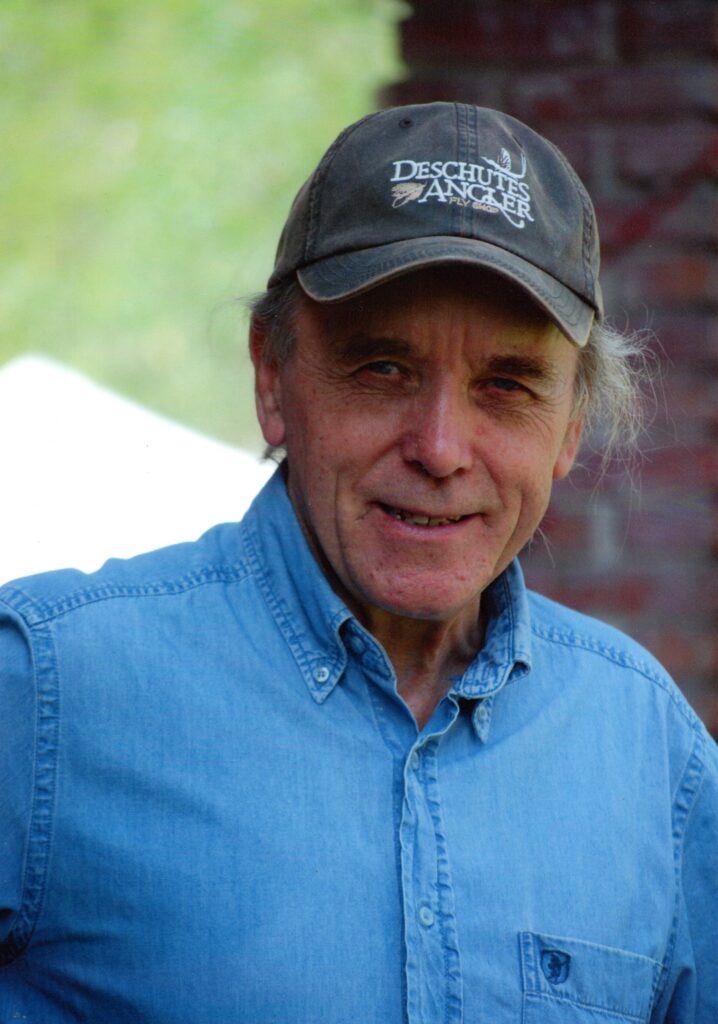
After AAM (Agriculture, Alimentation, Medicine) Terra Nuova, a monthly journal of the alternative, gave up on pursuing the bioregional idea in Italy, I found myself alone insisting on this prospect of change. Nobody knew me at that time (late eighties), also because working on my father’s small farm absorbed all my free time. If we add to this my innate shyness, which meant that even in those few AAM bioregional camps in which I participated, my voice was hardly heard. Notwithstanding of that, my conviction of the validity of the bioregional proposal was such that I really didn’t want to see it abandoned. And that was how the publication of Lato Selvatico began. A modest newsletter, written partly by hand and partly with a simple old typewriter (it was 1992) and sent for free to a few targeted addresses. That was literally a “stone thrown into the pond.”
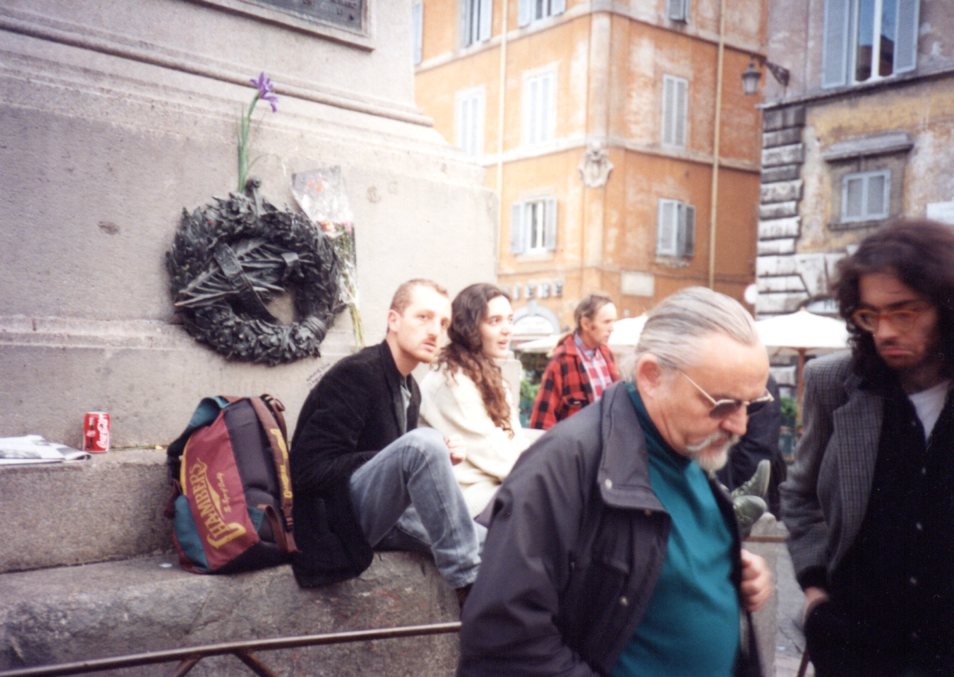
I encountered Peter Berg and Judy Goldhaft the year before at the first meeting for the Shasta Bioregional Gathering in California. Two years later, in 1994, I received a letter from Peter in which he informed me that he and Judy were about to leave for Germany and that I could take this opportunity to organize some meetings on bioregionalism in Italy. I contacted the few whose attention Lato Selvatico had captured and together we organized six conferences up and down Italy: Mantua (Green University), Bologna (Frontiere), Ravenna (Appropriate Technologies), Rome (La Sapienza University), Naples (Flaming Rainbow) and Florence (AMM Terra Nuova). Peter’s eloquence on the bioregional theme and Judy’s art, with her performance “Water Web,” broadened the minds of the audience to discover that the world is not just one of power games, economic interests, or the megalomaniac dream of modern society which continuously absorbs energy and makes us feel powerless. Rather, the immediate world in which we live, the bioregions, provide the place to build the foundations for another world based on respect for ecological processes and social aspects of a just and aware society.
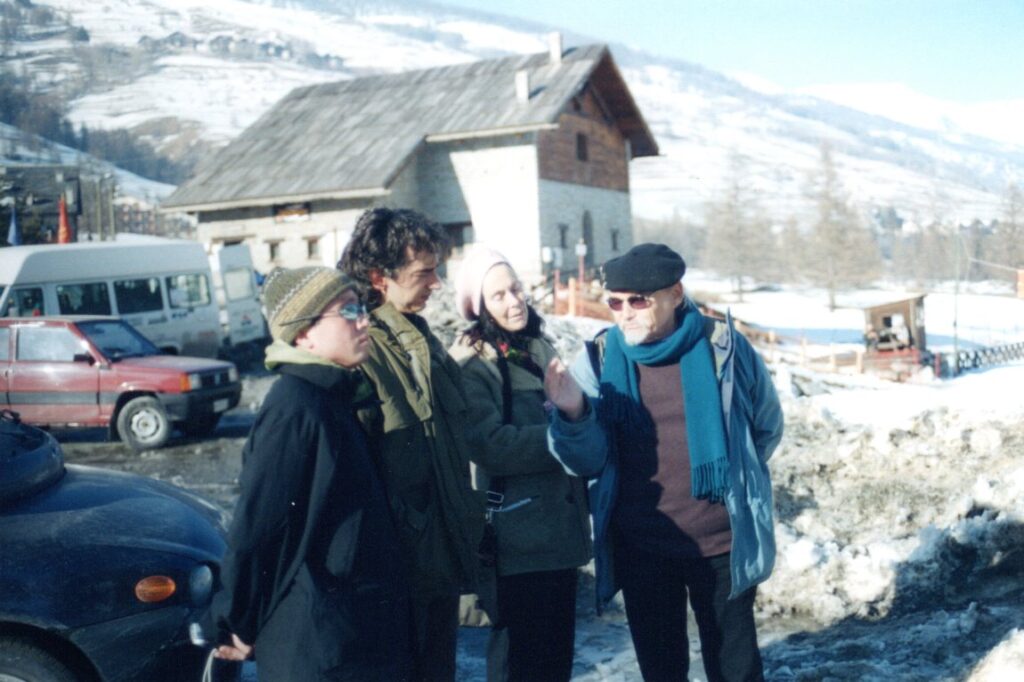
The bioregional arguments as expressed by Peter and Judy were so new, visionary and explosive that there was no shortage of criticism in the newspapers, especially from the environmentalist green area. But for me and for the other aspiring bioregionalists, Peter and Judy’s words gave shape and vigor to a movement that at that time was in its infancy. The movement later grew producing coordination at the national level (Rete Bioregionale, 1996/2010, and Sentiero Bioregionale, 2010 to now), local and national annual gatherings, presentations and conferences, plus the publication of books and newsletters (in addition to the aforementioned Lato Selvatico).
The collaboration with Peter and Judy never failed so that in the following years they came back to Italy for conferences in Universities and Social Centers. They also came as Guard Fox Watch in 2003 to monitor the Turin 2006 Winter Olympic Games. I enjoyed their hospitality in the headquarters of Planet Drum on several occasions. We all miss Peter, a real warrior for Earth!
Giuseppe Moretti is an organic farmer, is part of the Sentiero Bioregionale group (www.sentierobioregionale.org) and is editor of the Lato Selvatico newsletter. He lives in the Po River Watershed Bioregion in Italy.
<<<<—————–>>>>
By Caryn Mirriam-Goldberg – August 5, 2022
Meeting Peter, Judy, and the Bioregional Movement
We were holding hands in a circle, 200 or so of us, singing Leonard Cohen’s “Suzanne” somewhere in the heart of the Ozarks in 1982. It was the second Ozark Area Community Congress (OACC), and I was lured there by hearing David Haenke, one of the congress organizers, six months earlier sing another song, Joni Mitchell’s “Same Situation,” outside of Ernie’s Cafe in Columbia, Missouri. It wasn’t a well-known song, but a very well-loved one by me, so I followed the music.
Now the multitudes of us who followed music or lust, yearning for adventure or an earnest wish to live lives that matter, were here together, holding hands and swaying. I looked across the circle and saw Peter and Judy, moving with elegance and panache. I looked up and saw the tent swaying, and beyond it, the clouds easing across dusk just before the swaying stars would make their presence known.
In time, I was hugging Judy and looking deeply into her beautiful eyes. I was holding Peter’s hand. I was in love with everything and everyone, at least for a while, but let me be honest: I was also, for the first time in my life, on acid. Most others around me probably were too.
A few hours before, when we were introducing ourselves around the massive circle by stating our name, home, and why we were there, a middle-aged man with long brown hair and a mustache too big for his face said, “I’m Rank N. File, I’m from the CIA, and you all know why I’m here.” Within short order many realized he was telling the truth because after introductions he passed out hundreds of tiny Mickey Mouse squares of paper, LSD, for everyone to try. My heart was so open by the oaks, the pines and the kindred humans looking into my eyes to acknowledge that we were old friends that I followed along.
So, the tent swayed. The clouds swayed too, and in time, I saw hands re-arranging them. Mostly though I was encased in a horror of flashing lights and torn rusting metal, realizing too late that the drugs were an irrevocable mistake, and I was trapped in six or so hours of horror-tripping when I meant to be loving up trees. Did Peter and Judy drop acid too? Maybe because whenever I ran into them that night, we clutched each other and laughed hysterically. Peter’s laugh could leap tall walls, then lie down in the grass and astound the sky, and Judy also had a lovely way of dancing in half circles to each side while laughing.
The drugs were a mistake for many of us, and surely, they were meant to derail what we were really there to do and be, making us into tripping hippies rather than a body of people talking, planning, and singing their way toward a more perfect union with this living earth. Waking the next morning, I felt like a train had thrown me hard into the hard earth, everything sore and my mind blinded by a migraine. I was exhausted and wrung out, but eventually I would find my feet and breathe again in love with this movement, these people, this earth.
But how that first gathering grabbed hold of me. It blasted and sung open the world as I always knew it without yet knowing this was my truth, and I had good company. Sometimes one thing—like an obscure Joni Mitchell song—or deciding to walk down this block instead of that one changes your whole life. Following the music to bioregionalism was that for me, first to OACC and six months later to the Kansas Area Watershed’s (KAW) first gathering in 1983. There, I would meet my husband and many of my closest friends, not the least of which was the community and eco-community of Lawrence, Kansas where I would plant myself for life.
***
I saw Peter and Judy again in 1984 at the first continental bioregional gathering, then called the North America Bioregional Congress (NABC). At the camp near Kansas City, Missouri, we shared some meals, surely laughed our way into the spine of stories Peter, a story-spinner of great renown, told. We were clear-headed but perhaps because of the gonzo swirl and sway of our initial meeting, I felt like we were old friends.
I met Stephanie Mills who dazzled me with her articulate passion for interior and exterior wildness. I watched the Paul Winter Consort floating in a series of canoes on the lake as they performed. I sat in a lot of meetings, including the first plenaries where I saw the facilitation genius of Caroline Estes and glimpsed how people could truly find collective wisdom and common ground, especially across grand divides and old wounds. The men at the congress took turns sewing the new bioregional quilt together, each square made largely by women throughout the continent.

As part of the planning committee with other OACC and KAW people, I also worked my tail off rushing around to haul groceries or help in the kitchen. An old handout of meeting notes I recently found tells me I was transportation coordinator for the event although I can barely remember what I did in an age long before emails and the interwebs.
But throughout the congress, there was something about Peter, there was something about Judy, and there was everything about Planet Drum’s dream that permeated and shaped all we did. Peter’s “Amble Towards Continent Congress,” a manifesto written in 1976, was the blueprint beneath the house of the congress we built in the wild.
Those nights, sitting around campfires or walking quietly along the woods from the lodge to the cabin, were filled with an open promise of what was possible. There weren’t any hallucinations of hands moving clouds but instead the refreshing reality of us all there together, talking and listening to what might come next. Mostly, I listened to the wind and to my own heart settling into a deeper sense of home. Many of us were doing the same.
***
She lifted both her arms, her loose blue kimono rippling around her like water as she swirled and spiraled down on the stage. I swayed side to side with my newborn daughter, just two weeks old, pressed against my chest, both of us sweating. We were near San Antonio, Texas, mid-May, 1992 for another bioregional congress. I had caravanned down with other KAWsters, most notably Ken and my family, including our new being. Just past dusk, most of us at the gathering stood and sat in the cooling air watching Judy do the water dance, something she developed in a more ancient dimension and returned to us at each bioregional gathering.
This time I watched her with new eyes, exhausted and also in love as I felt Natalie root around my chest for more milk. I hadn’t slept much in the bunk beds of a far-off dorm where the congress organizers thankfully put our family. We hadn’t recovered from the twelve-plus-hour drive with a toddler and a newborn, both Ken and I birth-weary but determined to be at the gathering. The kids did fine, sleeping a good amount, but we were another story, trying to relax on the road and now at the camp in between so much ecstasy and exhaustion.
Just as I looked for a place to sit, a young man brought me a plastic chair and asked if there was anything else I needed. No, just this. Just sitting here, nursing my newborn daughter while watching Judy lift and spin, still and rise, pause and arch her back to take in the sky, starting to churn the humidity of the day into the rains of the night.
We’re all made of water, she reminded us in a language beyond words. Yes, we are, my body, my daughter’s body, sang back to me in the quiet of the still air right before the wind of the storm makes its way through the crowd and the open space around us.
I knew Judy and Peter’s daughter was named Ocean, whom I met both when she was a child and a woman. I knew Planet Drum hugged the edge of the land on the west side of this continent. I knew all was fluid and in motion, but Judy was showing me something else at that moment as she enacted water and a woman moving through water. She gave me a wider glimpse of the life ahead, the moments now so precious and seemingly contained of this deep-dish motherhood, the moments behind and the moments ahead, all rolling through our bodies and lives like weather.
***
Sometime in the late 1990s, I was in San Francisco for a drama therapy conference, there because of my work founding and growing Transformation Language Arts, an MA program I started at Goddard College, and an emerging field all about using writing, storytelling, theater, and more for community-building, healing, and social change. But San Francisco was, as always, crazy-expensive when it came to hotel rooms, so I stayed with Peter and Judy. The conference also turned out, for me at least, to be a bust: over 350 people doing wonderful work in drama therapy and psychodrama (yes, an actual field of using theater for healing) together don’t always make for a very welcoming conference to outsiders. So, I punted and walked the city in between talking with Peter and Judy.
“You’re moving differently. Something has changed in you,” Peter told me one morning at their kitchen table over breakfast.
“He sees these things,” Judy added.
He was right. I had just weaned my third child after eight years continuously pregnant or nursing, and I was returning to my body as the habitat mostly of one human. He looked right into my eyes from across Judy and his kitchen table. “Yes, something has definitely changed.”
I drank the last of my honey-sweetened coffee and smiled, so content to be seen as someone who had arrived on the other side of a passage and someone ready even for whatever came next although of course I couldn’t know what it was.
There’s something about bioregionalists who have hooked into the power and presence of the ceremonial village we create together that basically downloads what bioregionalism is into our bodies and psyches. It also makes kin of strangers, so much so that many of us feel like we could walk into each other’s apartments or houses, open the fridge and root around for some good leftovers, read each other’s magazines, and nap on one another’s couches. This was what it felt like to be at Judy and Peter’s place, an apartment connected to the Planet Drum office, city and Max Parrish-like city skies integrated and of one piece.
I promised myself I would visit again, feeling so at home in their presence, but 1,500 miles between my home and theirs, the tears and pulls of time, and all the workaday ramblings that overflow a life kept me from keeping that promise. Yet I have that visit, that conversation, that breakfast to remember.
***
Where does time go and how does it move? This grabs hold of my poetry and yearning to know something more solid in a world of constantly shifting weather and water, movements and gatherings, meetings and departures.
Peter died too soon and yet over eleven years ago, a mere 73 years in age although much older in bioregional time given his still-unfolding legacy. He was the original raconteur, a performer of space and place, a visionary and curmudgeon. He was fearless and loving, present and a bit omnipotent, even when alive. He and Judy started the Planet Drum Foundation decades before we knew what was coming but surely on the basis of what was on its way.
I remember at the first bioregional congress in 1984 how people were debating whether there would be a new ice age in our lifetimes or global warming. Obviously, the latter won out. But the movement, which he named into existence, all of us who came to it further unfurling its language and possibilities, was way ahead of the game, even if we were and still are bent on dismantling the game and making something better. Especially if we realize there is no real game at all, but the something better is simply what is here: the earth in its most local forms, including our own bodies and where our bodies dwell, in real and specific time.
I remember reading in the L.A. Times after his death how he once tore up the sidewalk outside his and Judy’s home and office with the intention that seeds from what they planted would “blow down the street and crack open all the sidewalk with native plants.” That’s what he left us: seeds capable of cracking open sidewalks and lives.
That’s what Judy and other Planet Drum people carry forth while Judy especially shows us, the Jill-of-all-trades she is, in her sinewy ways of moving. She keeps dancing it together and beyond those walls out to where there are no walls.
When I think of Judy and Peter, I still think of them swaying arm-in-arm with all the others under the swaying tent and sky while we all sang “Suzanne.” I think of the rain blessedly coming. I think of the clearing afterwards.
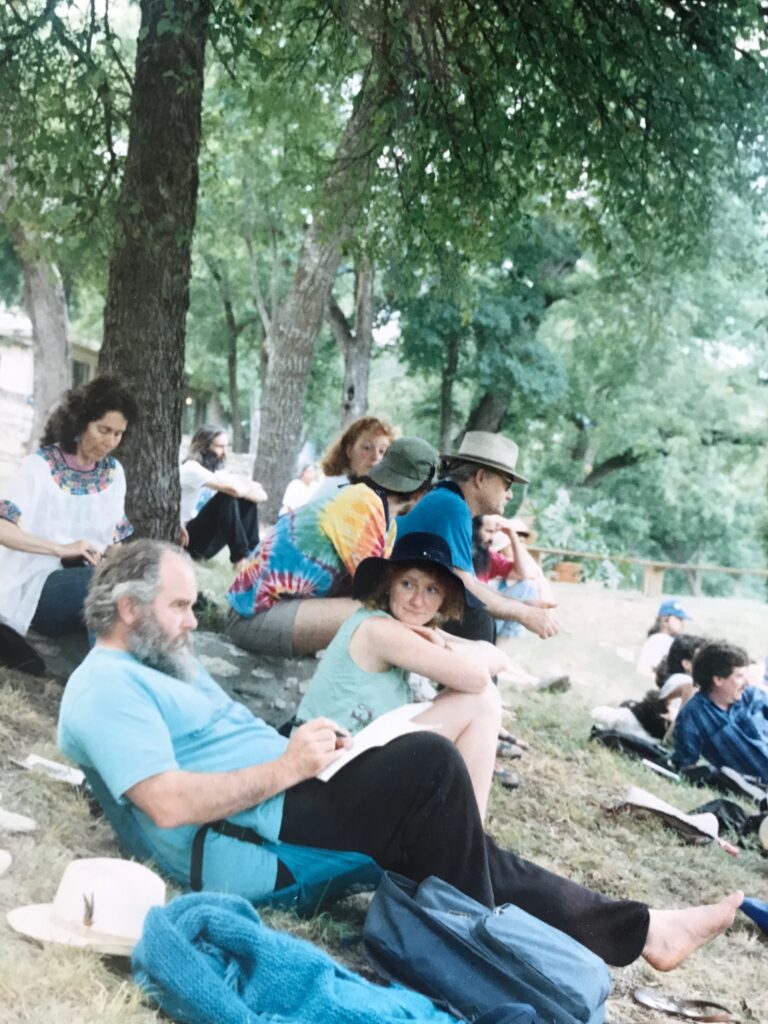
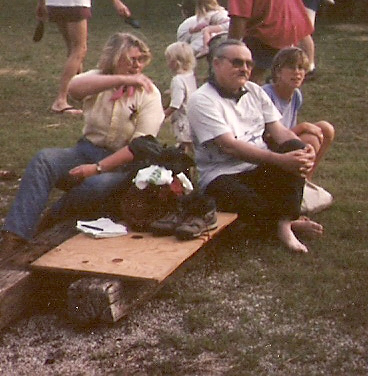
Caryn Mirriam-Goldberg is a long-time bioregionalist and one of the founders of the Kansas Area Watershed Council. Past poet laureate of Kansas, she is the author of more than 20 books of poetry, fiction, memoir, and anthologies, and founder of Transformative Language Arts. She offers classes, workshops, writings, and coaching on writing for our lives, Right Livelihood, and facilitation. She and her husband, ecological writer Ken Lassman, make their home and are made by it on the prairies of Kansas, just south of Lawrence, Kansas. For close to 40 years, they’ve worked, prayed, struggled, freaked out, schemed, dreamed, and planned to save the land where they live, and in 2020, they were able to buy that land, which will be placed in a conservation easement to protect it forever through the Kansas Land Trust.
<<<<—————–>>>>
By John Diamante – November 22, 2022
I was influenced by the early mapping work of Erwin Raisz. His landform cartography was drawn in pen and ink. Apart from my childhood’s pictorial poster maps of the world’s peoples, their habitats and various species, from murals by Miguel Covarrubias for the 1939 San Francisco World’s Fair, it was the first time I saw a map without the normally basic anthropocentric information such as cities, political boundaries and other clutter.
For me, it’s always been the watershed as the basic political unit, though there is a certain inter- changeability between watershed and bioregion. The word “bioregion” has gone from an arcane term (still not quite a kitchen word) to one at which most people don’t react blankly. As wellsprings of the bioregional movement, one would have to identify Planet Drum Foundation and, among early articulators, latterly David Haenke and the Ozark Area Community Congresses (OACCs).
Planet Drum’s legacy to date is a multi-media (largely print and theater) dissemination of hearts-to-Nature call to how we might live, specifically, in Planet Drum’s terms, how to reinhabit place. The word “reinhabitation” kind of says it all—how to adapt our human needs and lifestyles to eco-systems of different (wilderness, forest, preserve, rewilded, regenerating, prairie, farmed, ranched, ecotone, montane, alpine, desert, riparian, oceanic, island, coastal, urbanized, megapolitan] bioregions, watersheds and deltas, successfully to live with, not against or degrading the natural world.
A watershed can be very small, a microsite such as the headwaters or tributary stream of a river. On the other hand, the National Recovery Administration (of “dirt farmer,” arborist FDR’s New Deal) administratively organized programs addressing ecological distress and economic depression of the 1930s according to macro watersheds (Columbia River, Colorado R., Tennessee Valley Authority, et al.; i.e., today, federal regions could be referenced as identified regions instead of Roman-numbered Districts: I, II, III…)! There are different scales but it seems plain that people attuned to place are going to have to look to their ingenuity and proficiency, intimacy with Nature and handiwork with tools (oriented from Stewart Brand and crews’ Whole Earth Catalog on) to survive payback for a century’s depletion of resources and driving, we thought, oh, so freely, swiftly, luxuriously, privately—in polluting, carbon-based, pavement’s traffic-trapped (auto)mobility.
I became acquainted with the Peters (Berg, Coyote, Warshall), Judy Goldhaft and crowd through a group called Reinhabitory Theater. Based on indigenes’ tales, they performed engaging plays in San Francisco parks, cavorting semi-costumed, mostly with masks. I got to know the continental movement of place-based thinkers and doers better through OACC, participation in several of the NABCs (North American [Turtle Island] Bioregional Congresses, 1980s to ’90s) and a Shasta Bioregion gathering held in North Coastal California.
Congresses were hosted by allied inhabitants of proudly identifying bioregional areas including the Ozarks (1984), the Great Lakes (1986), Cascadia (British Columbia, 1988), the Gulf of Maine (1990), Edwards Plateau (Texas, 1992), Ohio River Valley (Kentucky, 1994), Cuauhnahuac (Mexico, 1996), the Prairie (Kansas/Kansas Area Watershed/KAW, 2002), Katúah (Southern Appalachia, 2005), and the Cumberland bioregion (Middle Tennessee, 2009). They were like very grounded and joyful summer camps with a couple hundred (mostly white, except in Mexico) people, including families and lots of children, with intensive showing, trading, recreations, entertainment, Turtle Island and Mother Earth circles, dancing, late-night earnest deliberations and jawing.
We San Francisco watershed evangelists also nourished each other at The Farm (a wood building underneath the intersection maze of Cesar Chavez Blvd. [Army St.] and 101 freeway). This cross-roads meeting place of many arts was created by recently deceased reinhabitress (New York City’s Bryant Park to San Francisco’s Mission Creek), Bonnie Sherk, assisted by Jack Wickert and Andy Pollack (who has founded a multi-activity “SF New Farm,” with various species and artists, integrating both a native plant-dedicated and additional nursery, at 10 Cargo Way’s Bay shore).
I remember the concurrent All Species movement (including us two-leggeds, not the other way around) with Chris Wells, launching year-long schoolroom work-ups of costumes inspired by self-chosen animal and vegetable totems, that climaxed with spectacularly inspiring All Species Parades on officially proclaimed All Species Days, from San Francisco to Manhattan among other metro centers.
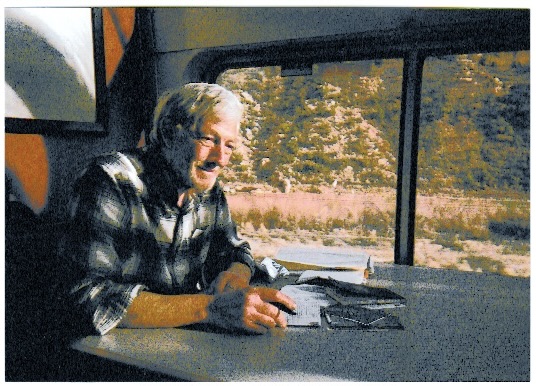
The San Francisco Ecology Center, at 13 Columbus Avenue, one of Zach Stewart’s inspirations, directed by Gil Bailie, then, Marc Kasky, (at once a venue for all sorts of meetings and presentations, a gallery, and thronged, Financial District, lunch-hour Soup Kitchen) was frequented by downtown workers, tourists, water and resource stewardship pioneers, authors, photographers, artists, incantational summoner, Ponderosa Pine, and other, full-blown, eco-invocatory, bioregionalist enactors.
One can’t say enough about the dedication, inspiration, originality and integrity of Planet Drum’s work and mission to seed and spread bioregional understanding—Nature first and adaptation promoting a future for Earth’s interwoven ecosystems and species, in harmony with one’s chosen region. I was happy as an independent, friends-financed NGO (nongovernmental observer) and proudly as a San Franciscan, to carry a “bioregional portfolio” of Planet Drum’s and related maps, texts and graphics to various U.N. and multilateral conferences and plenipotentiary reviews (such as the protracted Law of the Sea negotiations), in the ’70s and ’80s.
Planet Drum’s “bundle” concept was a key contribution to the bioregional movement as a medium of assembled representative media. Each unique whole bundle was brilliant, indeed awesome, motivating inhabitants of very different regions to signify, to express their place, in poetry, prose, art, texture, memory, everything but (only for lack of budget) audio and visual media. They were so inventive and marvelous. Everyone who received even one bundle, especially the series, was converted. Perhaps the work of them should be repurposed in comic/graphic book form to reach new hands (bundles were max tactile), eyes, senses and minds.
Planet Drum is a small press, an esoteric thing in the landscape of publishing, and small presses struggle. The influence and impact of its output deserves funding appropriate for republication and new originations. Planet Drum’s fantastic work has progressed on a Mickey Mouse scale compared to what the content merits. What’s the mailing list membership base—a few hundred maybe? But poets are the true legislators, artists and teachers of humankind, right? Planet Drum Foundation has been a poetic source of orientations and truth.
The opening and closing ceremonies of the Olympics are the largest of media and theater productions. What if ecological commitment had been favored, endowed to work at that scale, symbolized by benchmarks from Earth Day to Al Gore’s An Inconvenient Truth? Planet Drummers could mount Come-to-Nature revival shows with a big tent, music, projections, and voices of all species, drawing people in using song, culture, lore, insight and humor of a venue’s region to lift up and unify. Immersive revival theater could be done with bioregional content, for instance: this is where we live, this is what we’ve done, what we are doing to the place, plus flourishing upsides if we can change. Bring people to that same emotional pitch of openness to each other as at the great rock fests of the ’60s and beyond—such as Grateful Dead concerts where several thousand people danced in harmonic, euphoric wisdom. Take the tent(s) on the road, camp in reaches and precincts and celebrate life oriented to Nature. Facilitate connections to life using sung and spoken word, music, dance, image, news, data. Attract people to amassed experience, dissolving frames, connecting capabilities of individuals, families, affinities, consumers and voters to live nourished by and nourishing Nature. How to amplify beats of tolerance, peace and cooperation? Scale tent-sized or arena-full, enveloping, green-content theater for 5,000 or 50,000 people at a time.
A few memories…
I remember Judy always working and laughing, celebrating. And providing—real makers of movements are always to be found in the kitchen as well in colloquies, ateliers, onstage and, when the chips are down, on the front lines. Peter was a very gifted and gutsy person, like all leaders, creatives and authentic disruptors. He was a born director and could be a tough taskmaster with a barbed, acerbic side. I decided early on I wasn’t going to let that bother me. He was a wonderful and magical person.
Together, the two of them were a magical pair. We’re in debt to Judy, staff and volunteers for carrying on the catalytic, prolific, high-spirited, humor-loving, faithful reporting of Green City, Pulse and related Planet Drum chronicles.
Another memory of spending time with Peter and Judy is the hospitality of their house and the paper (pre-digital) information produced by that house. We’re all aging. Who’s going to take on the archives, hard copy (for permanence) and digitized (for global access)? What institution or library will serve as the repository? Big question—how can all of us help Judy and staff, fiscally, logistically with where the working, openly accessible output, as well as unique holdings of Planet Drum might be situated? The move will free up Judy’s life and free us, in knowledge that PDF will long be drumming.
map!
And, to the matter at hand: celebrating 50 years of Planet Drum. Since NABC and to this day, I don’t think I’m alone in wishing for continental distribution of a colorful, pictorial, diner-, truck stop-, café-, classroom-, student union- and government center-popular, simple, QR code-graced, Planet Drum 50th Anniversary (North American for starters) map of bioregions.
coders!!
What about the game? Of life! In the massive, multiplayer, dominant entertainment industry of online gaming’s immense demographics, find, inspire or follow talented coders, to transcend the genre’s primary, first-person-shooter product with an individual and team game of high-humored, first-person(s)-reinhabitor, bioregional challenge—for an epiphanic gift to the commons. All rights and revenue (overseas, copyrights, any media, merch spectrum), however, securely to be held by and accrue to Planet Drum Foundation, Inc.
John Diamante is an independent creative whose half-century of Special Projects (Public Communications, Inc., and Threshold (Center for Environmental Renewal, Inc.—Way of Nature) has included research, writing, networking, tactical newspaper publishing, advocacy planning and direct organizing for long-cycle public benefit causes and coalitions. His proofreader.com shop provides full editorial services. From the Bay Area, Shasta Bioregion, he regularly travels coast-to-coast by rail. For (print or digital) Special Projects’ 14th Draft of a ‘sheet-to-beat,’ single-page roster of 22 infra[eco]structure priorities, fronting May ’23 Edition of 11″x17″, full-color, USA railway network urgency, map folder: contact by voice @ 202.203 9100 or write @ 268 Bush St., 1009 SF CA 94104.
<<<<—————–>>>>
By Daniel Christian Wahl – March 31, 2023
Our ancestors around the world for nearly 290 thousand years of the Homo sapiens story have been custodians of the bioregions they emerged from, dwelled in, and were expressions of. The return to becoming a cosmopolitan bioregional species through what Peter Berg called “reinhabitation” is our collective path towards planetary healing and a regenerative future. The work of Peter Berg, Raymond Dasmann and the Planet Drum Foundation was 50 years ahead of its time and has never been more significant than today.
Daniel Christian Wahl is an educator, activist, agroforester and author of Designing Regenerative Cultures. He lives in Mallorca in the Balearic Archipelago in the Western Mediterranean.
<<<<—————–>>>>
By Peter Brastow – March 31, 2023
My relationship to Planet Drum (PD) goes back to the mid-1990s when I was interning for the National Park Service at the Presidio. I applied for a job at PD in 1996 and had an interview with Peter Berg. Though I didn’t get the job, Peter said that our paths would cross in the future, which of course they did at various times. One of those was when Peter and the Mayor of Bahía de Caráquez, Ecuador (where PD had a community restoration project since the 1998 El Niño), served on a panel that I organized for World Environment Day, 2005, which was held in San Francisco. Later, Chris Carlsson and I collaborated on the Shaping SF/Nature in the City TALKS at Counterpulse, and Peter and I were on a panel together with Bonnie Sherk talking about strategies to create a Green City.
My deepest connection to Planet Drum, Peter, and Judy is of course the concept and vision of bioregionalism. After encountering this and other ideas while I was studying geography at UCLA, I immediately began putting them into practice when I started to volunteer doing habitat restoration at the Golden Gate National Recreation Area. I loved how PD would always include the Shasta Bioregion on their address, and for the last 30+ years, we in the local nature conservation movement have always framed our work as part of restoring the Franciscan Bioregion, which was first coined by the botanist James Roof. Finally, in 2006, I started to promulgate the idea of creating a Twin Peaks Bioregional Park, which is still a very viable idea and directly complements the grassroots-created Crosstown Trail. Speaking of 30+, the most obvious manifestation and inspiration of Planet Drum’s bioregionalism is the Wild in the City map, which PD sponsored back in 1992. We honored the map’s contribution, including that of its creator Nancy Morita, recently at a wonderful event at the Bay Observatory at the Exploratorium (March 2023), where we also showcased examples of all of the astounding ways that people have been inspired by the Wild in the City map’s bioregional vision for all these years. And bioregionalism is absolutely infused into San Francisco’s 2018 Biodiversity Resolution and our bold chapter for Healthy Ecosystems in the City’s 2021 Climate Action Plan.
Peter Brastow is a Senior Biodiversity Specialist and Yerba Buena Island Restoration Ecologist with the San Francisco Environment Department in the Franciscan Bioregion. He lives in the San Francisco Bay Area Bioregion.
<<<<—————–>>>>
By Robert L. Thayer, Jr. – March 31, 2023
Congratulations to Planet Drum for its 50th birthday (this year is also my 50th as a professor at UC Davis, now retired). I attended the Shasta Bioregional Gathering (SBG) III on the Big River camp in Mendocino in 1994 and SBG IV at Cazedero in 1995.
The two SBG gatherings I attended were very important and pivotal events for me. Four other professors and I had put together a Putah-Cache Bioregion Project at UC Davis in 1993, and for me, attending the SBGs was essential. I remember vividly when Peter Berg had us form a spatial “map” of where we came from on the dining room floor, each person standing in their own small place with regards to Northern California. I was also quite moved by Judy’s history of Planet Drum, and by Malcolm Margolin’s fascinating talk about native California groups and their relation to the land and to each other.
Prior to attendance, we were all asked to bring a container of water from our home stream; I pick up mine from Putah Creek on the way to the Russian River, and in ceremony, each poured our water into Austin Creek. I was quite moved by this simple gesture, and later instituted a similar water-sharing ritual on Utah Creek by a diversion dam: each person gathered a container of water from above the diversion dam, later to pour half of the water in the diversion canal for people and the other half into the stream beyond for fish and other creek animals.
These two bioregional gatherings were essential life changers for me, as if I had been baptized as a bioregionalist, which I remain today. Planet Drum IS the birthplace of the bioregional movement. More recently, I have reminded many of my bioregional colleagues around the world of this critical role Planet Drum played, and the rest of us are loyal followers spreading the word.
Robert L. Thayer, Jr. is Professor Emeritus of Landscape Architecture at the University of California, Davis and is remotely working on another Ph.D. at Kingston University in London. He resides in the Putah-Cache watershed subregion of the Sacramento Valley Bioregion of Northern California.
<<<<—————–>>>>
By Stephanie Mills – April 3, 2023
Planet Drum 50th Anniversary Encomium
Trying to come up with an adequate tribute to Planet Drum on the occasion of its fiftieth anniversary has taken me through some of my own archive of bioregionalia, thence to the internet and home to my own love and respect for Peter, Judy, and Freeman, treasured friends, remarkable people with wonderful minds, all kinds of courage, brilliant imagination and utter commitment to Nature’s primacy on Planet Earth, with unyielding hope for human species kind to reinhabit the biosphere one life place at a time. Along with companeros they began Planet Drum, a crucial node and polyphonic voice of bioregional thought and action.
Early on, Planet Drum’s savants understood how cruel and serious things were getting and that more of the same old piecemeal tweaks and reforms wouldn’t help for long or inspire for the long haul. So they dared to think beyond modern environmentalism to a future primitive; dared to peel the geopolitical lines off the maps and see watersheds and biomes; dared a politics beyond left and right.
Fifty years is a fairly long time and utterance proliferates but what’s issued from this outfit is durable goods. Planet Drum has been radical, sane, wild and persevering. The bioregional vision is a template for something more than permaculture or restoration or natural history or festivals, although these are all essential to the work. It’s more, Peter said, than “just saving what’s left.”
The synthesis, the understanding, the invitation to a renewal of diversity, wholeness, and belonging in nature—not in general, but in a certain place, respecting its stories, landforms, watercourses and biotic communities have made Planet Drum’s message compelling: the existential meaning of habitat, with the nudge to wonder at and engage with all species— our homies.
Affiliation with Planet Drum and the bioregional movement led me to some of the most enlivening encounters in my life: with magical, charismatic, thoughtful individuals: flocks of terrific writers, gifted naturalists, artists of every ilk; scholars and organizers and shamans, sages and facilitators and cranks; troubadours and comedians, people of first nations, rainbow people, bohemians and cartographers, prairie and savanna and swamp people, city folk and monks, ecofeminists and rural fairies, homesteaders and craftspeople, all bodying forth possibility in their myriad ways. “This is the kind of talent I like to run with,” said Freeman House.
Planet Drum started fresh but not out of nowhere. Shasta bioregion is where I met Peter and Freeman and Judy, the terrain of consciousness that gave rise to one great bioregional cohort. That intelligence kept pursuing leads; going native in the city of San Francisco; journeying upriver and downriver and on around the Pacific Rim, parlaying with others all ‘round Turtle Island.
The core truth animating the forerunners and ongoers is that Earth’s bioregions are immanent: Even altered severely life places abide. Humans can be numbed by consumerism and a host of other grave misdirections, but evolutionary reality is that it’s in our nature to wonder and risk; to know reciprocity with, and care for all our relations. In essence we’ll always be animals, seeking water, sustenance, territory; craving stimulus and medicine: touch, scent, color, vibration, repose; entheogens and herbal remedies; needing Others: prey and predators, symbiotes, coevolutionaries: Kindred; Community. Planet Drum has animated that.
Peter and Freeman left their legacies. Judy remains, works, awes with her grace, wisdom and sheer mettle. Planet Drum endures and inspires. It’s fed souls, gone mycelial, sparked wild pulses of life in a world straying towards zombified gray goo neolife. It’s encouraged life-lovers, place-knowers, sense-makers, reinhabitors and faith keepers; has kept faith with watershed within watershed; kept faith with the seasons and the solstices, equinoxes and phases of the moon.
Gratitude.
Gratitude.
Gratitude.
Stephanie Mills has been writing and speaking for nature and community for nearly 50 years. She is the author of numerous books including Whatever Happened to Ecology?, In Service of the Wild: Restoring and Reinhabiting Damaged Land, Epicurean Simplicity, and On Gandhi’s Path: Bob Swann’s Work for Peace and Community Economics. In 1984, following a life-changing encounter at the first North American Bioregional Congress, Mills quit the San Francisco Bay Area for Northwest Lower Michigan, where she lives to this day.
<<<<—————–>>>>
By Jean Gardner – April 11, 2023
Remembering Planet Drum
Remembering Planet Drum, Peter, and Judy supports life today. Cast away any notions of nostalgia! When we bring the past into the present, we are fertilizing our lives now. I have known Peter and Judy since the days when they birthed Planet Drum. Much has happened in the last 50 years that brings to center-stage our awareness of human impacts on Nature. But nothing equals their understanding of the inextricable ties between the natural world of soil, plants, climate, non-human, and human culture.
During the same years Peter and Judy were organizing in San Francisco, I was documenting the presence of the living Earth In New York City. Discovering Planet Drum and their bioregional efforts, emboldened my own work. I also connected with Video Artist Paul Ryan and Cultural Historian and Scholar of the world’s religions Thomas Berry, benefiting from the contributions of both to bioregionalism in and near New York City.
The ground-breaking insights of these four bioregionalists affected me deeply. My life changed. With photographer Joel Greenberg and a foreword by American journalist and political commentator Bill Moyers, we published a book on Urban Wilderness: Nature in New York City. Also, we produced posters and pamphlets on the Urban Wilderness in each borough. We distributed these freely to community organizations, schools, and other local groups to encourage interest in the benefits of experiencing the Living Earth near one’s home.
To this day, I continue my efforts on a global scale now through an NGO I founded to honor indigenous peoples and their fight across the Earth to safe-guard and honor their bioregions.
Jean Gardner is Professor Emerita of Earth History and Architecture at Parsons/New School in New York and is the Founder and Director of Earth Group Global. Jean lives in the Lenapehoking Bioregion. For how her local Bioregion is connected globally see: https://earthgroupglobal.org/2023/03/i-am-haunted-by-waters-by-jean-gardner/.
<<<<—————–>>>>
By Brian Hill – April 24, 2023
In the late 1960s and until 1971 I was mostly in New York City at the New School for Social Research studying Cultural Anthropology, teaching at a couple of the local universities and hanging out with political activists and psychedelic groups in NYC. Stanley Diamond was the Chairman of the Department of Anthropology at the New School, and he was friends with Gary Snyder who greatly influenced my Ph.D. dissertation, as did Carlos Castaneda who was a member of our Radical Caucus of the American Anthropological Association. I left NYC in late 1971 and a friend from the Weather Underground suggested I look up Peter and Judy in San Francisco because they were talking about a new effort called “bioregionalism.” At that time new communes were forming in places like Tennessee, Colorado, New Mexico, Oregon, British Colombia and, of course, California. We didn’t know it at the time, but there was a shift from countercultural urban street politics to “living in place,” as Gary Snyder said, and in “re-inhabitation of the land,” as Peter Berg said.
During these years there was great movement among the radicals back and forth across the country. The new communes were networking centers for new views and lifestyles, as well as hideouts for frontline political radicals.
There was great movement and great renaissance. Openness, compassion, unity, trust and sharing all prevailed during these few short years. Bioregionalism was the catalyst that allowed me to transition from being a revolutionary to a back-to-the-land hippie helping to build a new culture that is still being born today. Thank you fellow bioregionalists.
Brian Hill, Bioregional Anthropologist, member of the founding generation of bioregionalists, lives in the Shasta Bioregion. He has specialized the last 50 years as a Back-to-the-Land gold miner and a founder of the now global Alliance for Responsible Mining –https://www.responsiblemines.org/en/, a back country Trinity Alps mountain man, an early 70s cannabis indica farmer, founder of the Wise Use Movement, close colleague of Kurt Saxon who was the founder of Survivalism, a 10-year participant in the 1990s UN NGO grassroots environmental movement, devoted hipneck, a founder of the Back-to-the-Land Project: https://www.facebook.com/ProjectBTTL, and the Counterculture History Coalition: https://chcoalition.org/, and now an ecosystem restorationist helping with the fire and desertification crises that the Shasta Bioregion is experiencing. He’s also trying to link the soil we can make from the forest fuels with the soil regeneration of Kiss the Ground/Common Ground so the 2023 Farm Bill will pass.
<<<<—————–>>>>
By Tad Montgomery – April 26, 2023
Judy and Peter were passing through my stretch of the Connecticut River Valley a few years back and had a gig in the small Vermont mill town where I lived. Afterwards I took them out to dinner, up a side street that’s always been a mix of addicts, panhandlers, hippie entrepreneurs, and bohemian artists. We turned a corner and I saw a poet sitting on a stoop. Wheeling the two around to him I asked, “Friend, these two people love the Earth very much. Could you recite your tree poem for them?” He did, a beautiful piece where he talks as a tree might, about to be cut. They were deeply moved, and gave him the kind of recognition that only one poet can give another, an honoring. Then we turned and continued on our way. Peter and Judy each took one of my arms, holding me as we walked up the middle of the street in the summer dusk, and Peter said, “Watch out for him. He’s the type of visionary they go after.”
Tad Montgomery lives in the Connecticut River Valley Bioregion.
<<<<—————–>>>>
By Alice Kidd – April 27, 2023
Planet Drum? What’s it to me?
Planet Drum provided a way into a community of communities. For the communards of the 80s that I lived with, this was a huge gift, to learn of others not unlike us.
We lived in the edge of the wild, and all of the writing about bioregions was both supportive and fascinating.
And the people we met and heard about. Suddenly the world was far more inviting. And so many of them understood community. And they, like us, believed in the necessity to re-build culture.
And now, as we work to explore possible futures locally, I am finding what I have learned through bioregionalism and with others is very valuable.
So yes, I celebrate Planet Drum.
Try to remember the first time you heard about human exceptionalism and the need to re-join the natural world. Or the first time you heard about local solutions. Or the first time you got obsessed with local maps. I did all of those things either because of the work of Planet Drum and others … or with people I met through them. And they know a lot of great people and communities.
And it was like a smorgasbord – my choices, my consequences.
Going into an unknown future requires working with people you do not agree with (or like or trust). And yet, if you do not know what will happen, you have to include the possibility that you and the people you agree with (and like and trust) have got it wrong. So, you have to figure out how to stretch across the divides. The first rule is that no-one is perennially in charge. And you learn how to listen, listen, listen.
Planet Drum models that. They share what they have learned; they work on their own projects; they offer educational events and publications; they find and work with each new generation in their bioregion. And they do not tell us what to do.
Judy Goldhaft reminds me of a “Mother Tree.” She is totally herself, a dancer, actor, and writer. At the same time, she nurtures the people she works with, of all ages. (We have one of those in this community).
Peter was a character. Each of us knew a different Peter. He helped a very nervous not quite poet to perform at a bioregional congress evening event. He taught me things about my poem that I had not known. And if you got him talking about bioregionalism, he was one of the best thinkers I know. His love for the ideas shone through.
50 years is a long time (I know, I’m 74). To reach this point in such good health is a major accomplishment for organizations, and humans. Thank you to all of you for your work and your vision.
Witten in 1987, I have included the poem that I read at the third bioregional congress held in Squamish in 1988:
Pain
I know the colour of pain
I know of its necessity
not because we need it to grow
but because it happens as we grow.
It is a feature of life.
But we must take care not to worship it.
It lets us know we are alive
but so do laughter, joy, delight.
It etches the faces of my friends
and burdens not a few.
We, so passionately devoted to change,
Inspired by the vision of a new world, new culture
are not strangers to it.
Pain limits
We can go here – and no further.
It directs
not this way folks.
Engaging vigourously with life
brings intimate acquaintance with pain.
It takes time to learn to withdraw the foot
from sharp stones – before they cut the flesh.
It takes time to learn how to share
without overpowering the other
with fitting generosity.
We live with pain
as we live with our friends
An intimate.
In time it may become a respected tool
The first warning signal shapes our footsteps.
Alice Kidd is an adult educator and community activist living in the Dry Interior Fraser River Valley Bioregion in British Columbia. This includes the town of Lillooet and the Yalakom valley 20 miles away. In 2020, she wrote an article titled “Notes from the MidFraser” in Planet Drum’s Pulse publication.
<<<<—————–>>>>
By Jacqueline Froelich – May 1, 2023
May Day Froelichian Planet Drum Memory
Circa 1990 I was a forest-dwelling Ozarkian offset lithographer, taking leave in San Francisco’s Mission District for a spell to work on some ecological communications projects. I convinced a bioregional colleague (whom shall remain anonymous) to join me in committing a crazy act of guerilla graffiti on Planet Drum’s residence/offices occupied by the most elegant Judy Goldhaft and brilliant bioregional theorist Peter Berg — with whom I had congressed for several years. We hopped a trolley late one evening, wearing dark clothes, packing water-based paint and brushes. At our destination, when the coast was clear we painted in large letters:
BIOREGIONALISTS RULE!
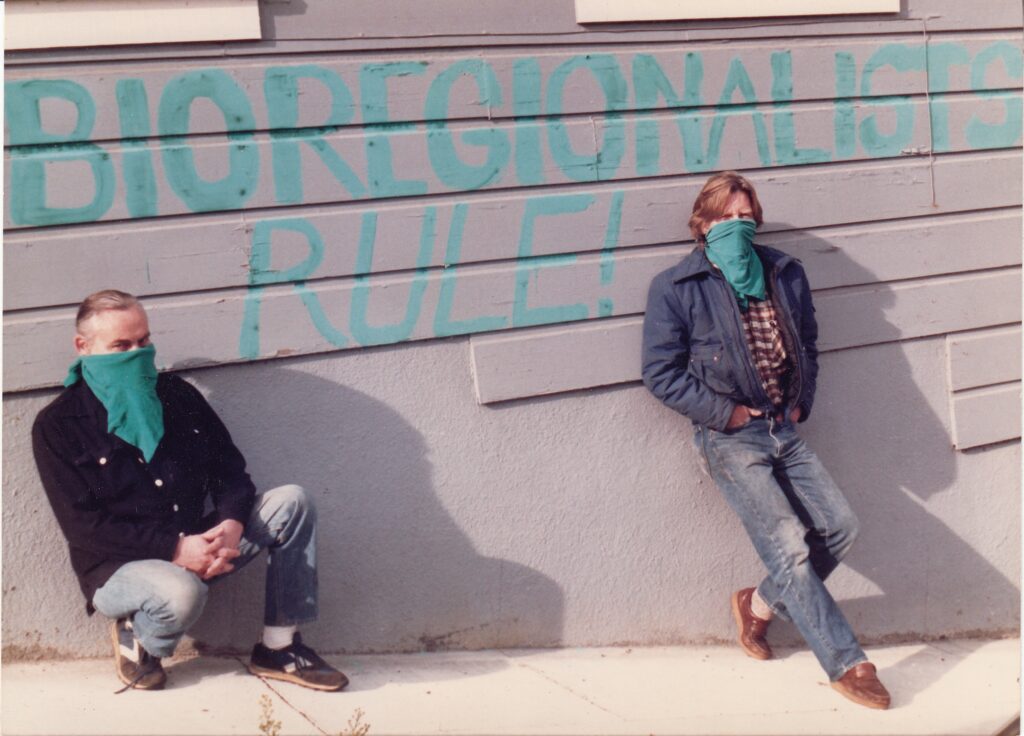
To this day I regret this act of vandalism, and should have returned to repair the damage. But I was a young eco-punk spurred by retribution, I think, because Peter for some reason, enjoyed teasing me at bioregional congresses, where I and a gang of writers during the halcyon North American Bioregional Congress (NABC) era worked day and night publishing our congressional minutes, documenting all-species resolutions and green laws and producing bound NABC proceedings.
We legacy bioregionalists were and remain a brilliant band of Earthists, still working in the trenches in all sorts of profound capacities, despite a looming climate catastrophe wrought by 8 billion + humans. We did our best.
Thank you, Judy and Peter and Happy 50th to Planet Drum!!
Jacqueline Froelich is an NPR-KUAF Reporter and Ozarks Area Community Congress Bioregionalist.
<<<<—————–>>>>
By Beatrice Briggs – May 2, 2023
My First Encounter with Planet Drum
Once upon a time in the early 1980s, I heard about the concept of “bioregions” from Thomas Berry. I was living in Chicago at the time and soon connected with David Haenke and Stephanie Mills, both luminaries in the Great Lakes region. In this good company, I began to apply the bioregional concepts in my home place. Then I decided to convene a one-day workshop that would bring together people knowledgeable about the prairie, the lakes, and the rivers that defined what we were beginning to call the “Wild Onion Bioregion.”
By that time, I was dimly aware of the distant beating of Planet Drum. One day I called the office in San Francisco to ask about the availability of information to share at the upcoming workshop. To my good fortune, Peter Berg himself answered the phone. It is hard to say who was more surprised – me to be in direct contact with one of the legendary founders of the bioregional movement or Peter talking to an unknown yoga teacher in Chicago.
Over the next several years, Peter and I had numerous opportunities to meet in person and collaborate, but I will always be most grateful for his willingness to help me find my way on the bioregional path.
Beatrice Briggs is the Founder and Director of the International Institute for Facilitation and Change (www.iifac.org) 2004 – present. She is a specialist in participatory processes that help visionary leaders and change-oriented groups define their goals and collaborate to make a significant difference in these challenging times. A native of the USA, Bea lived in the Wild Onion Bioregion (aka Chicago) before moving to the Bosque de Agua (Water Forest) in central Mexico in 1998.
<<<<—————–>>>>
By David Haenke – May 2, 2023
When Planet Drum Came to the Land of the Oak
From the time the first Ozark Area Community Congress (OACC), henceforth referred to as “Oak,” had its acorn emergence from the Dream of the Earth in October 1980, I feel we were fully in this Dream when Oak II leafed out a year later at the sacred Alley Spring on the Jacks Fork River near the confluence with the Current River Watershed, with the miraculous appearance of Planet Drum in the quintessential foundational representation of Peter and Judy and delegation from the Shasta Bioregion!

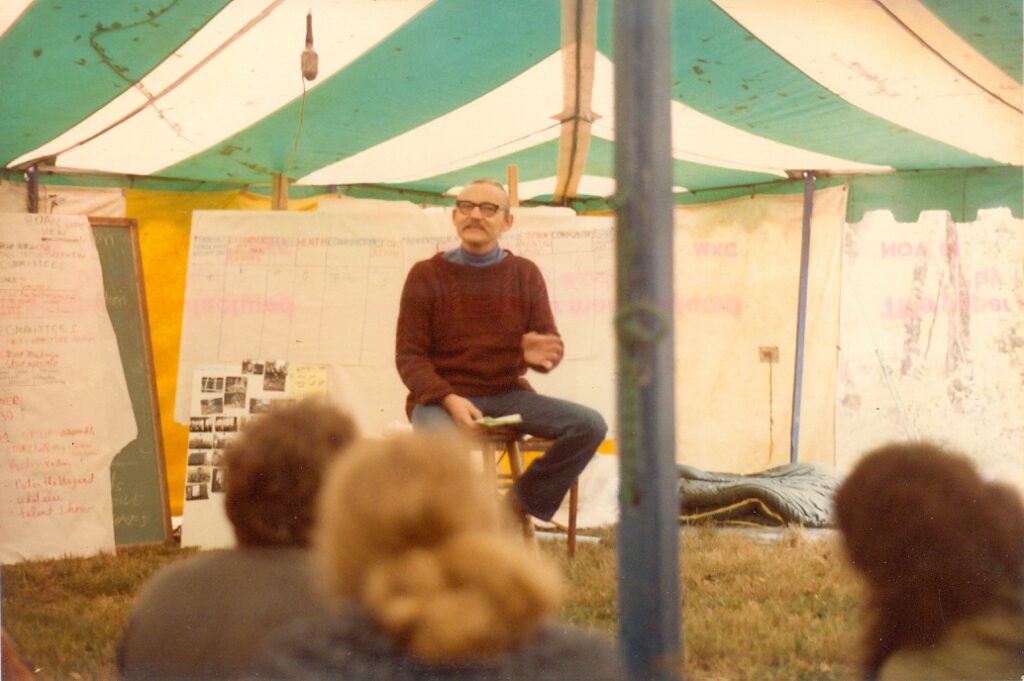
Planet Drum! Planet Drum! The first time those two words appeared to me in the middle-ish 70’s they struck my being like a synesthetic tuning fork that has never stopped humming and thrumming to this day. Planet drumming out around sweet Earth, bardic music in the key of Gaia, Schumann Resonances, mothered by lightning mind on oceans of foundational alpha waves the length of the circumference of Earth, nascent biocentric mind in evolution…Shasta quantumly entangled with Ozarks: bioregionalism!
Ella Alford (supporter of bioregionalism and namesake of The Alford Forest, the 4,300-acre ecological reserve that she donated to the Ozark Land Trust, the Forest hereabouts within and along the Bryant Creek/Watershed) funded Judy and Peter to come to Oak II. Ella attended with her beloved dog Buddy.
Oak II was in so many ways a wondrous one-off, a full campout at Alley Spring Park. 175 people, somehow fed off a wood cookstove I schlepped in my truck, with giant pots of beans and rice to simmer on the stove, and other donations of comestibles from gardens and anon. We had the simplest of “infrastructure,” with the main venues being a big rented auction tent, the picnic tables of the camp, grass and trees to meet upon and under, plus tents that folks brought for their lodging. Water sources included a hose I brought and hooked up to a camp hydrant, the river, and frequent rainstorms. The full cost of attending, including food, for the three days was $10.
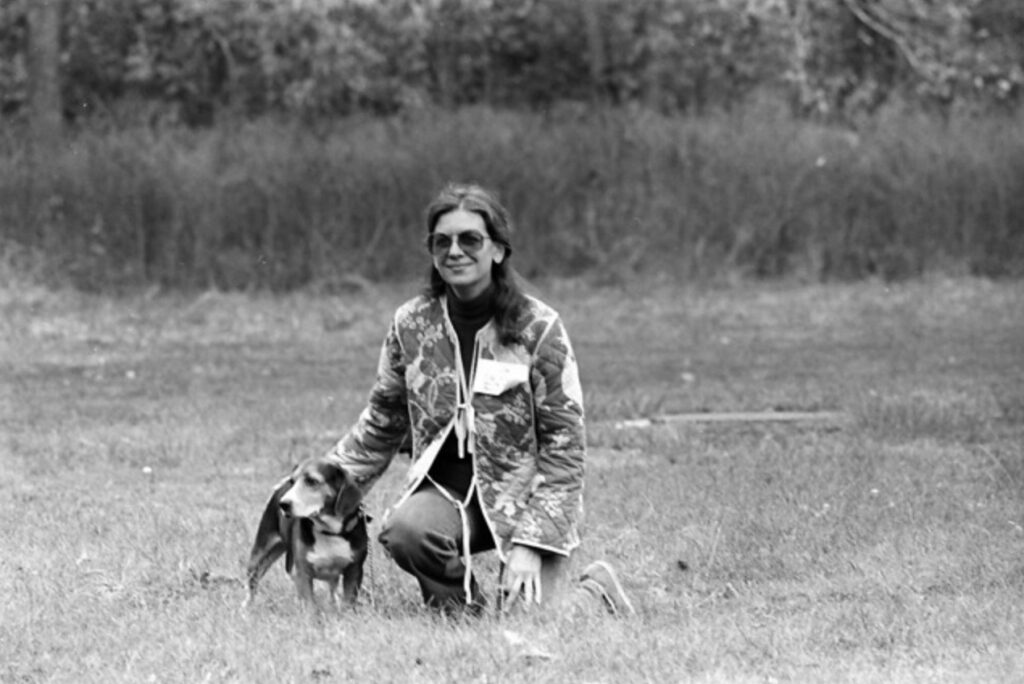
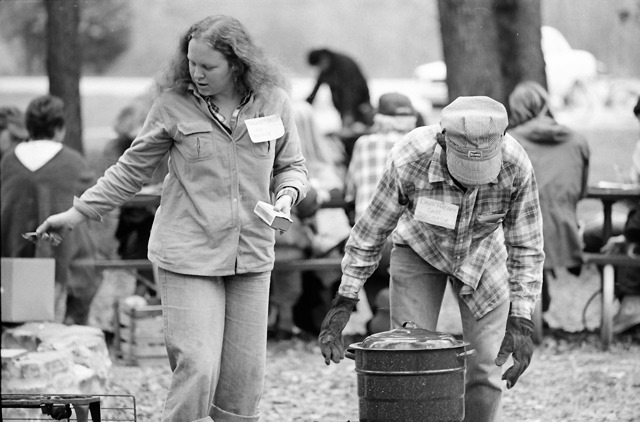
Attendees/Representatives came from all around the Ozarks, and other realms of Turtle Island. It was so phenomenal to have Peter and Judy there!
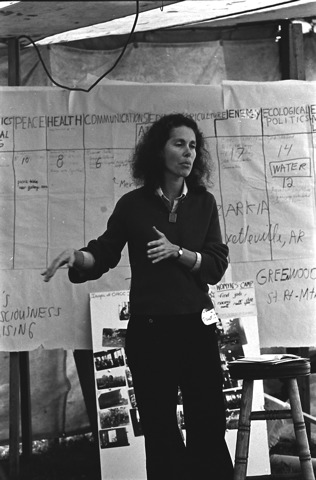
Oak II, like Oak I, had its time from Friday through Sunday divided up in three primary modes: full group/plenaries held in the big tent, committee meetings in the tent or outside, and workshops. Along with his talks on Planet Drum and bioregionalism in the tent, Peter also reported on his attendance at the first meeting of the Fourth World Assembly in London in an outdoor committee session where we discussed what might be next for the bioregional movement. In that session, I brought up my resolution that had passed at Oak I on convening a “congress of congresses.” The discussion continued with my proffering the name “North American Bioregional Congress” (NABC). All in attendance agreed that this sounded good. Later the Oak II plenary approved a resolution to allow me to go forward in working on convening what became NABC I three years later in 1984. In Oak II’s wondrousness, Planet Drum/Peter and Judy were present in catalyzing NABC I as a manifestation of at least some dimensions of Peter’s visionary declaration, “Amble Towards Continent Congress,” written some years before in 1976.
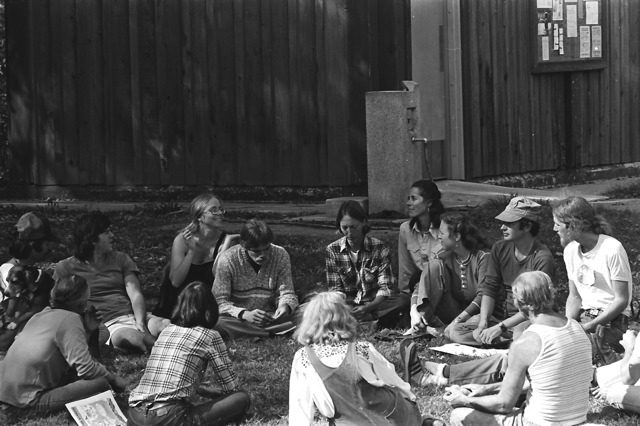
Oak II, through the inspired attendance of a contingent of folks from the Kaw River Watershed, also led to the founding of the KAW Council in 1982.
I believe Planet Drum’s presence at Oak II was a primary event in the story of the unfolding of the bioregional movement and on to its continental manifestations. All gratitude to Planet Drum, Judy, the memory and legacy of Peter Berg, and the people of the second Ozark Area Community Congress!
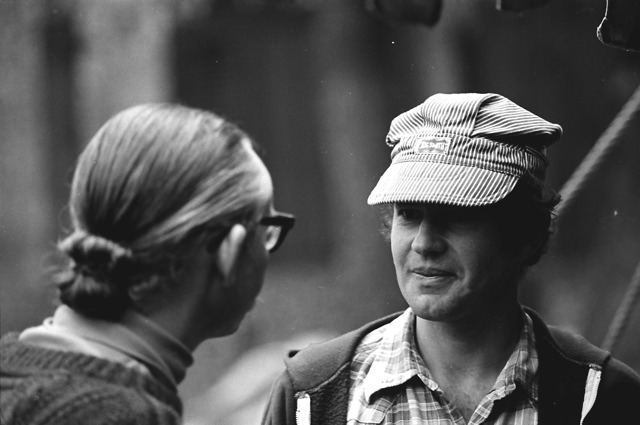
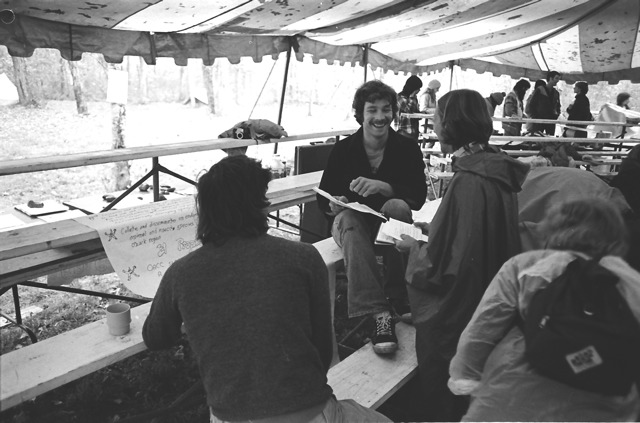
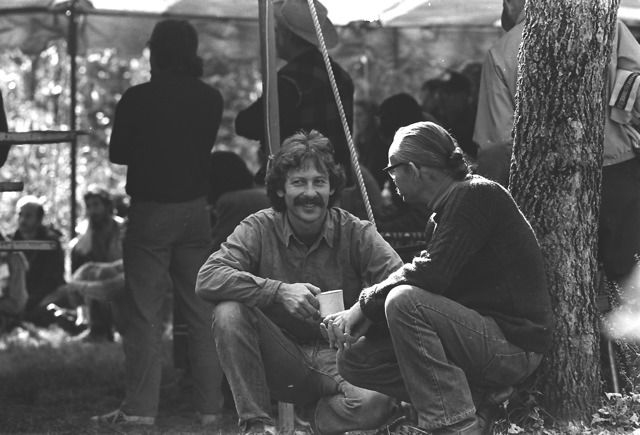
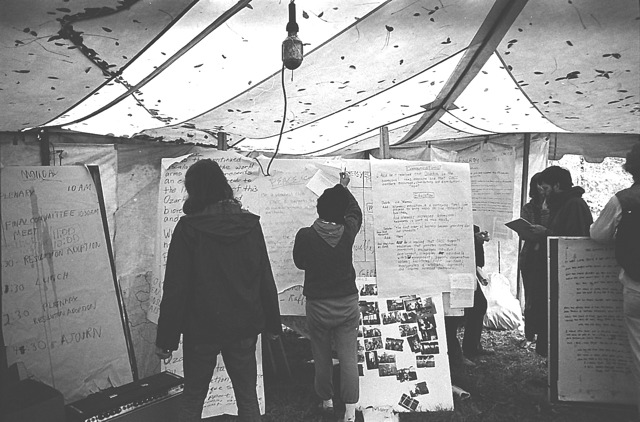
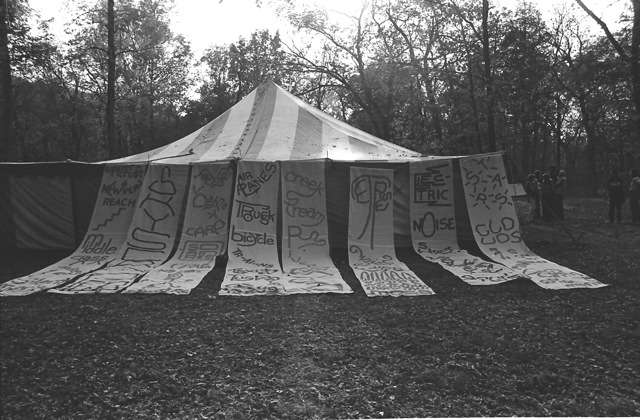
David Haenke is co-founder of the Ozark Area Community Congress which will gather for the 44th year this October. He lives in the Bryant Creek watershed in the Ozarks Bioregion.
<<<<—————–>>>>
By Eve Quesnel – May 3, 2023
Some quotes by Peter Berg:
“All life on the planet is interconnected in a few obvious ways, and in many more that remain barely explored. But there is a distinct resonance among living things and factors which influence them that occurs specifically within each separate place on the planet. Discovering and describing that resonance is a way to describe a bioregion.”
“Bioregions are geographic areas having common characteristics of soil, watersheds, climate, and native plants and animals that exist within the whole planetary biosphere as unique and intrinsic contributive parts. Consider them as possessing the diverse and necessary distinction of leaves from roots, or arms from legs.”
“The main focus for life-place learning is on the ecologically bounded place itself. It isn’t difficult to locate this spot. Identify the climate, weather, landforms, watershed, predominant geological and soil conditions, native plants and animals, and sustainable aspects of the traditional culture along with ecological practices of present day inhabitants. Your life-place is the geographic area where those things converge.”
“The bioregional perspective…recognizes that people simply don’t know where they live. Generally when you ask people what their location is, they give it in terms of a number on a house on a street in a city in a country in a state in a nation-state in some political division of the world. But if you were to answer in bioregional or ecological terms you might say, ‘I’m at the confluence of the Sacramento and San Joaquin Rivers and San Francisco Bay in the North Pacific Rim of the Pacific Basin of the planetary biosphere in the Universe.’”
Eve Quesnel is the co-editor of The Biosphere and the Bioregion: Essential Writings of Peter Berg and is retired from teaching English at Sierra College in Truckee. She lives in the Sierra Bioregion.
<<<<—————–>>>>
By Ken Lassman – May 4, 2023
I have struggled to find words for the handful of times I really got to spend some good time with Judy and Peter, and I think I have finally figured out why that is. In the early days of organizing the first few Congresses, I was a young man from rural Kansas who had not been exposed to much outside my own circle of friends and strongly held beliefs that were all pretty much coming straight from my experiences with the land around me, supplemented by my voracious appetite for those who had things to say about such things.
When I stumbled across Peter’s “Amble Towards Continent Congress” in Truck 18 Biogeography Workbook (1) put out by David Wilk, I was blown away. Here was someone who had their pulse on the planet in a way that I had not seen so deeply before. When the first North American Bioregional Congress convened in Excelsior Springs, MO and I got to meet Peter and Judy for the first time, and to see Judy’s jaw dropping dances, they were like gods to me. I was star-struck. I was happy to just be in their presence. Seems kinda silly I suppose, but that is pretty much the honest-to-god truth.
Over the years, that relationship has matured considerably and even from afar, took on a much more in-depth form as I continued to read and share their many exploits through their Planet Drum missives, visiting them, and seeing them in subsequent congresses. But the aura of being beings from a slightly more elevated plane than others I have known persisted in the back of my mind, if I am honest with myself. I attribute my speechlessness so far to arising from this place, and it’s something that I feel I can contribute to honoring them.
Ken Lassman is an ecological writer and author of Wild Douglas County (2007) and Seasons and Cycles: Rhythms of Life in the Kansas River Basin (1985). He is co-founder of the Kansas Area Watershed (KAW) Council which explores, protects and celebrates the prairie and local culture through gatherings, educational programs, creativity and creative thinking, and the occasional journal Konza. He also curates the weekly nature postings found at www.kawvalleyalmanac.com and has been married to poet and author Caryn Mirriam-Goldberg since 1985. He is a fifth-generation resident of Douglas County in the Osage Cuesta ecoregion in the Kansas Prairie Bioregion.
<<<<—————–>>>>
By Glenn Page – May 9, 2023
Congratulations Planet Drum for this historic milestone of 50 years of providing inspiration towards a more just, equitable and regenerative world. Here in the Gulf of Maine, one of the most rapidly warming systems on the planet, we are inspired by the legacy of bioregionalism to learn from the past, better see the current realities and help navigate into the uncertain future. Thanks to the work of Planet Drum, we are better able to see interconnected systems across our biosphere so that we can explore the “terrain of consciousness” that inspires us to become better stewards. Your legacy has inspired us to examine linkages, cross-scale dynamics, traps, tipping points, governance dimensions, and transformation systems where climate and sustainability actions can be suitably amplified, scaled deep and wide as we face the growing polycrisis. We must continue to build on the legacy of Peter Berg and Raymond Dasmann to learn-by-doing, weaving stories of collective action that document enabling conditions and bust open windows of opportunity. Promising signs of bioregional governance are emerging across the globe and serve as evidence of the legacy of Planet Drum. We send deep gratitude for the beat of Planet Drum and what that has done, and will continue to do, to inspire a global revolution!
Glenn Page is the Founder of the Collaborative for Bioregional Action Learning and Transformation (COBALT) and lives in the Casco Bay area located in the Gulf of Maine Bioregion.
<<<<—————–>>>>
By Amy Berk and Cheryl Meeker – May 15, 2023
As artists, activists and educators based in San Francisco, Amy Berk and Cheryl Meeker are committed to showcasing the groundbreaking work of Planet Drum on their 50th anniversary. Although we have not known about them for long, we are blown away by their prescience and connection to integral art movements of the last 50 years. The creation and mailing out of their signature “bundles” is of particular interest. In addition to their form as mail art, the collaborative creation of each bundle brings together a variety of voices and involves a broad community, de-emphasizing the lone individual authorial voice while uplifting and empowering the communal. The bundles, made up of poems, drawings, maps, photographs and books in differing combinations show great attention to conceptual integrity, much like how a bioregion is a distinct area with coherent and interconnected plant and animal communities, and natural systems, often defined by a watershed. The bundles are connected through content, and intent and serve as “life-place(s)” for human interactions, connections and community. The work of Planet Drum intersects as well with the art of the archive, event and process-oriented art, social practice, activist art, as well as pedagogical and eco art.
Amy Berk is an artist and art educator who taught at the San Francisco Art Institute since 2006, serving as Chair for the Contemporary Practice program from 2011 to 2013. She directed the award-winning City Studio program which engages underserved youth in their own neighborhoods through sequenced art classes that are both rigorous and joyous. In 1996, she co-founded the innovative Meridian Interns Program serving inner-city teens and has taught in the Post-Baccalaureate program at UCBX since 2004. She has shown her work internationally, was one of the founders of the web journal stretcher.org and the artist group TWCDC.com. Since 2019 she and Chris Treggiari have collaborated on ARTIVATE which creates opportunities for youth to explore artmaking and citizenship in the public sphere. Amy has recently taken on a Program Director role at Industrial Design Outreach and is running a mentor-driven project creating light sculptures at Academy High. She remains committed to giving teens (and adults) a much-needed voice, a safe place in which to speak and helping them find the proper tools to do so. She lives in San Francisco, the unceded ancestral homeland of the Ramaytush Ohlone peoples, in the Bay/Delta Bioregion.
Cheryl Meeker is a visual artist based in San Francisco, the unceded ancestral homeland of the Ramaytush Ohlone peoples, in the Bay/Delta Bioregion. Her work ranges from photography to installation, drawing, painting, archives, video, interactive web projects, and social sculpture often touching on the fundamentals of sustenance in our environmentally destabilized world. A founding member of Stretcher.org, she has frequently collaborated with artist Dan Spencer as the art team Dan and Cheryl, producing actions, panel simulations, and video. Her ongoing activism with the housing and climate justice movements and recent work in the public library system inform her approach. She was one of the organizers of “Capitalism Is Over! If You Want It,” and her work has been exhibited at ATA, Mission 17, Yerba Buena Center for the Arts, Southern Exposure, the Oakland Art Museum and online at SFMOMA project open space and the Richmond Art Center. Her writing has been published in NYFA Current, Stretcher, and Art Papers. Find further information at https://cherylmeeker.blogspot.com/
<<<<—————–>>>>
By Craig Dremann – May 25, 2023
What I remember the most about what Peter said, was when we were sitting around the kitchen table and he was giving an example of how we need to go “All-In” with our work with conservation and repairs to the environment.
He was giving an example of a person picking up plastic cups off of a park’s lawn. What Peter said, was “Why plastic? Why lawns?” That has always stuck with me.
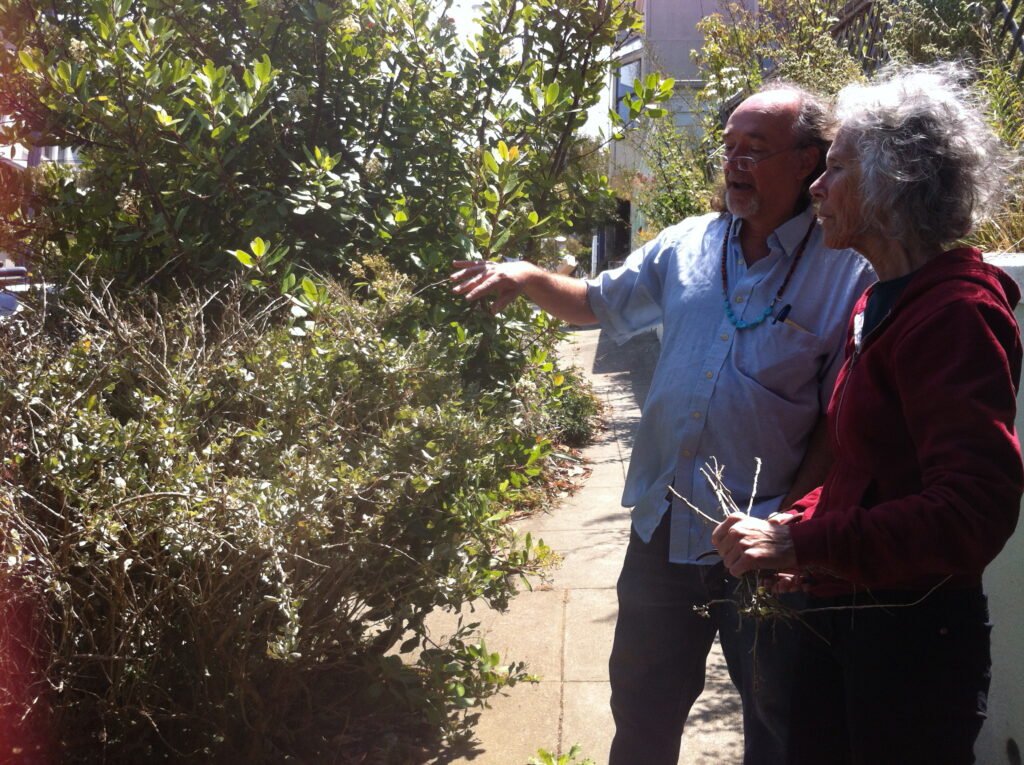
Craig Carlton Dremann’s Native heritage comes from the Tuscarora Nation and he started the “Redwood City Seed Company” 51 years ago, to offer traditional and heirloom vegetable seeds. In 1992, he started “The Reveg Edge” to restore grasslands and wildflower fields, with 800 acres restored so far—visit Kite Hill Wildflower Preserve in Woodside, CA to see wildflowers blooming from March to October each year. Between 2002 and 2010, he worked with the Saudi government, that resulted in 500 million acres being set aside as Ecological Restoration Preserves—the world’s largest Global Warming carbon sequestration project, being planted with one million trees per week as the “Saudi Green Initiative” until one billion are planted in total. This project was expanded to include 24 countries under the “Middle East Green Initiative” to plant a total of 50 billion trees. Craig is a very grateful resident to be able to live on the Lands of the Muwekma-Ohlone Nation within the San Francisquito Creek watershed of the Santa Cruz Mountains.
<<<<—————–>>>>
By David McCloskey May 27, 2023
This first piece is the eulogy I originally wrote for Peter on August 20, 2011.
On Peter Berg’s Passing….
The eulogy from Planet Drum was wonderfully evocative….
I have only a few comments to add. First, what struck me most when meeting Peter the first few times was his audacity, his grinning energy, his courage in taking a unique stand, and the incisive clarity and conviction of his thought. Wow, when he launched into those critiques of global industrial monoculture and the bioregion as the place to decentralize to, “the elsewhere of civilization,” I sat up and listened hard–he got me right away.
Of course, I loved his “mapping your bioregion” workshops with the Luminous Judy Goldhaft and her tremendous “Water Web” dance. They inspired me to begin working on mapping watersheds and Ish River Sound and Cascadia. Peter was also a better writer than people recognize.
One minor correction: to my knowledge Peter was not the first to coin the term “bioregion”–that honor goes to the obscure inventor Alan Van Newkirk of Canada. Peter may have been the first to coin the key term “reinhabitation,” though I don’t know who invented what in that fruitful collaboration with Ray Dasmann.
As far as I know, Peter was the first to link bioregion, a version of the biogeographical province, with human culture as a “terrain of consciousness,” a landscape of human perception, joining meaning to value. Linking ecosystem to region to culture and perception is an achievement of the first rank. This still distinguishes bioregions and bioregional mapping from all other “ecoregions” and “ecozones.”
But there’s something else still, a little harder to put one’s finger on. How and why and when did Peter Berg have the epiphany, the felt transformational insight, that the existential key is PLACE!!??? Not abstractions like Environment nor Ecology, nor–nor–or etc., but the living breathing place? Peter felt in his bones that the “earth is alive,” and the face of the earth that we inhabit is the place itself—the life-place, our homeplace. Perhaps it was a translation of the ecological notion of habitat, or some other electric source, but opening himself to the reveal of this fundamental truth transformed his life and ours.
Today we need to recover both the notions of reinhabitation and bioregion from an overly localized notion of life-place, and embrace our wider regions as living places, such as Cascadia…. enter into the full range of all our bioregional addresses … and recovery of the “forgotten country” in-between….We need to engender a deeply rooted “culture of place”
on all levels….
I stand in tribute and do a waterfall dance for Peter Berg, Judy Goldhaft, Freeman House, David Simpson, Stephanie Mills, and all the other pioneers of bioregionalism!
——-
This next piece was written on May 27, 2023.
On the 50th Anniversary of Planet Drum: In Honor of Judy Goldhaft
Judy Goldhaft is a luminous being….
There’s a glow about her… and a lightness of being that befits a dancer…
She exudes a warm welcoming open presence that invites others to bloom like her….
Planet Drum has always been a collective communal project, but she has been the heart and soul of the bioregional movement. As a “Jill-of-all-trades” behind the scenes, she has kept the office, and Raise the Stakes, and latterly the Pulse and website, going. She’s also a consummate editor and publisher. Quite literally she is the matrix, the connecting thread, that keeps it all going….
She embodies moral clarity, compassion, patience, and understanding. She is infinitely “hip” in the original sense, “getting things” intuitively from the inside—poetry, arts, music. Her own “Water Web Dance” is a true bioregional gem, enacting in graceful flowing movement and poetic image what “watershed consciousness” means.
How her circle and generation came up with “bioregionalism”—what grounded inspiration led to this epochal fierce and beautiful philosophy of place-based reinhabitation and restoration as “The Real Work” of our time—and how they found their way and so creatively blazed the trail—remains an unexplained miracle, something for ecocultural historians to ponder…. But one thing remains clear: she exemplifies the best of bioregionalism—and its original promise–in her life and work.
It has been my pleasure and honor to have known and worked with Saint Judy the Goldenhearted!
David McCloskey lives where he was born in McKenzie-Willamette land, foothills of the Cascades of western Oregon … Kalapuya “Illahee.” An Emeritus Professor from Seattle University, he’s considered “The Father of Cascadia” having created the idea of “Cascadia as a BioRegion” in 1978. He’s mapped the distinctive character and context of Western bioregions for over forty years, including the original hand drawn “Cascadia” map (1988) from which all others derive, updated in the award-winning GIS-based “Cascadia: A Great Green Land” (2015), an “Ish River-Salish Sea” map (2022), and the second edition of “The Cascadia Map-Atlas” (late June 2023). His “Ecology & Community: The Bioregional Vision” (w/ a centerfold map of “The EcoRegions of Cascadia”) appeared in Columbiana in 1994 and was distributed as a bundle by Planet Drum. He’s created an original BioRegional Mapping Model which appeared in the Pulse, as well as numerous ecocultural, philosophical, and poetic pieces (e.g. in the forthcoming two volume “Cascadian Zen” from Watershed Press). To learn more, go to cascadia-institute.org, and to order his maps go to featheredstarproductions.com, then open “Map Gallery.”
<<<<—————–>>>>
By Denise Vaughn – May 28, 2023
Included here are photos from the archives of the second Ozark Area Community Congress (OACC) held in 1981. That year, the OACC took place at Alley Mill Campground along the Jacks Fork River in the Ozark National Scenic Riverways (National Park). We rented some big tents and had an all-outdoor event. The photographer was Phil Orlikowski.
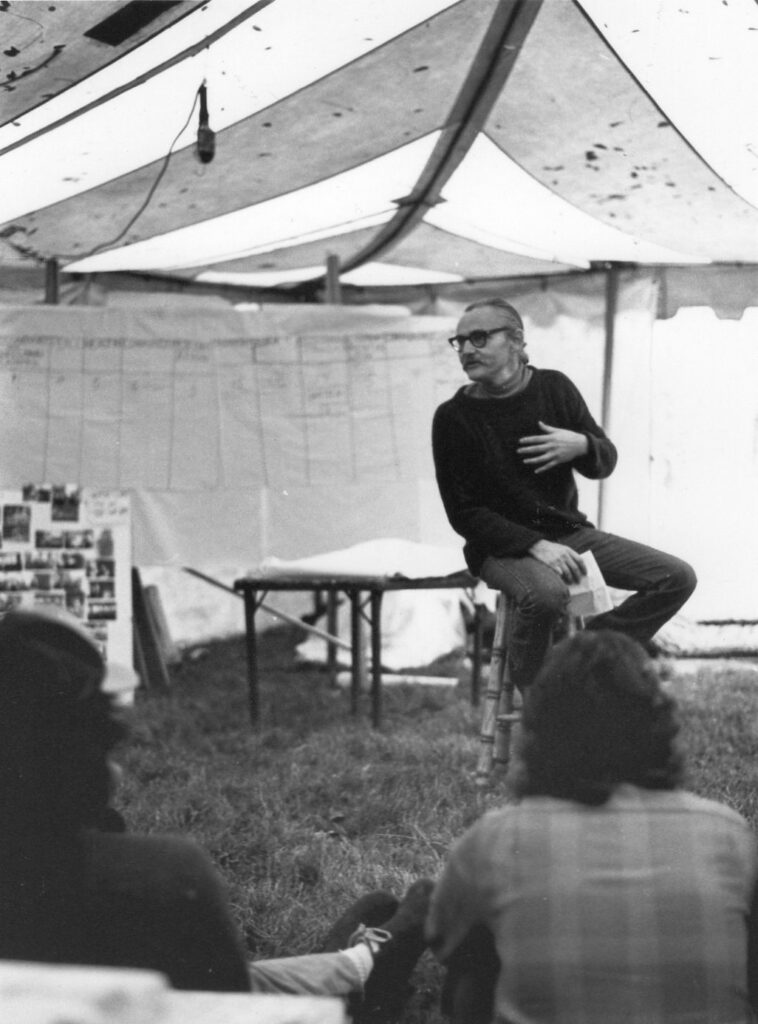
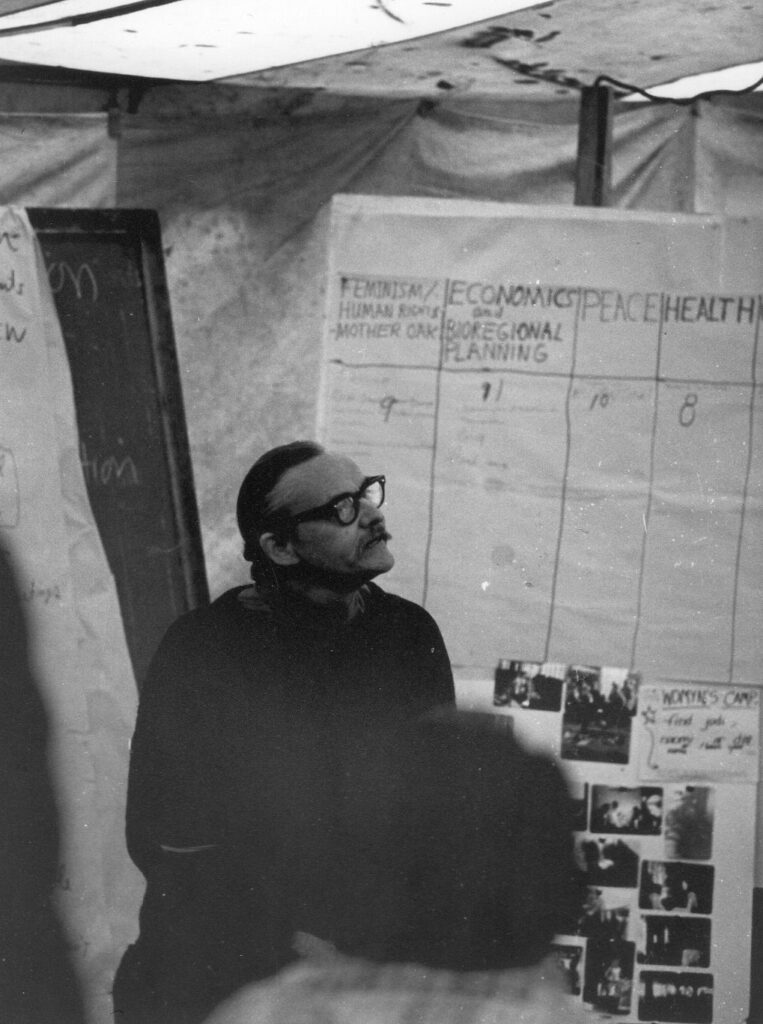
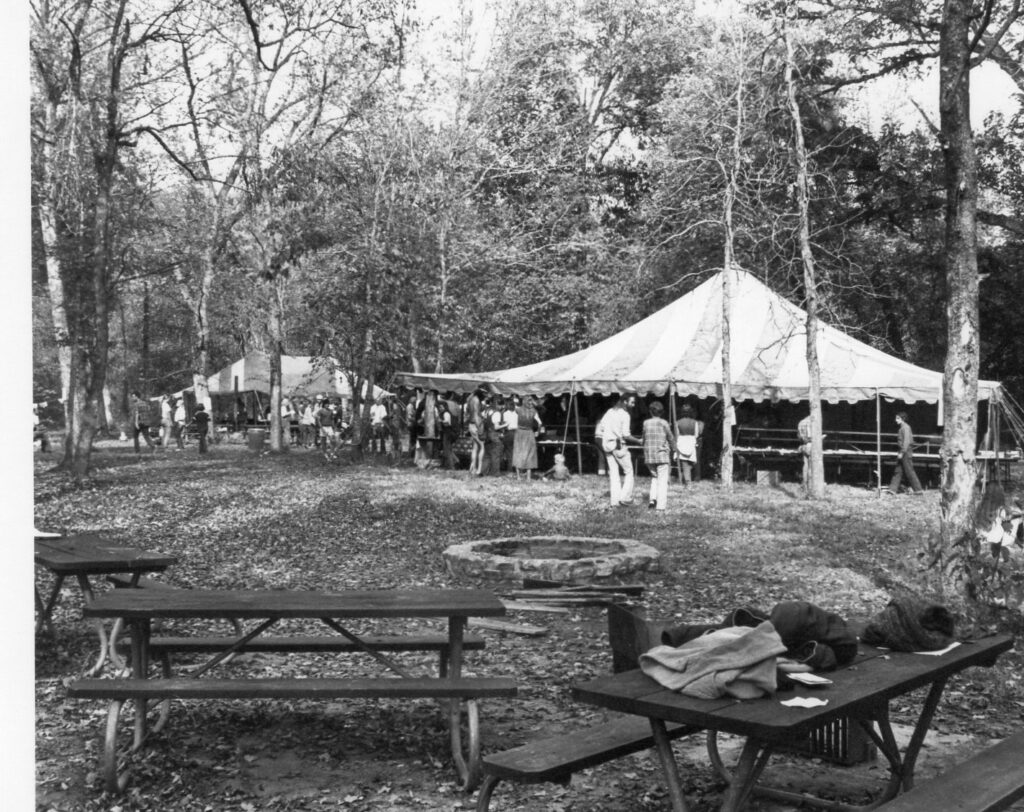
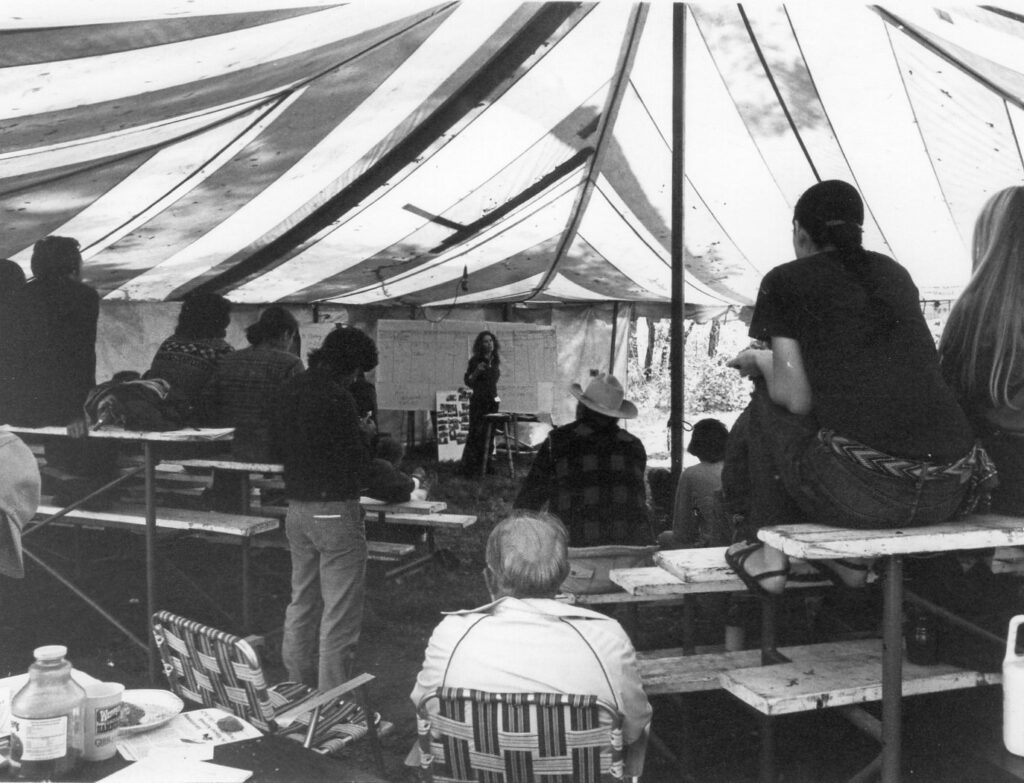
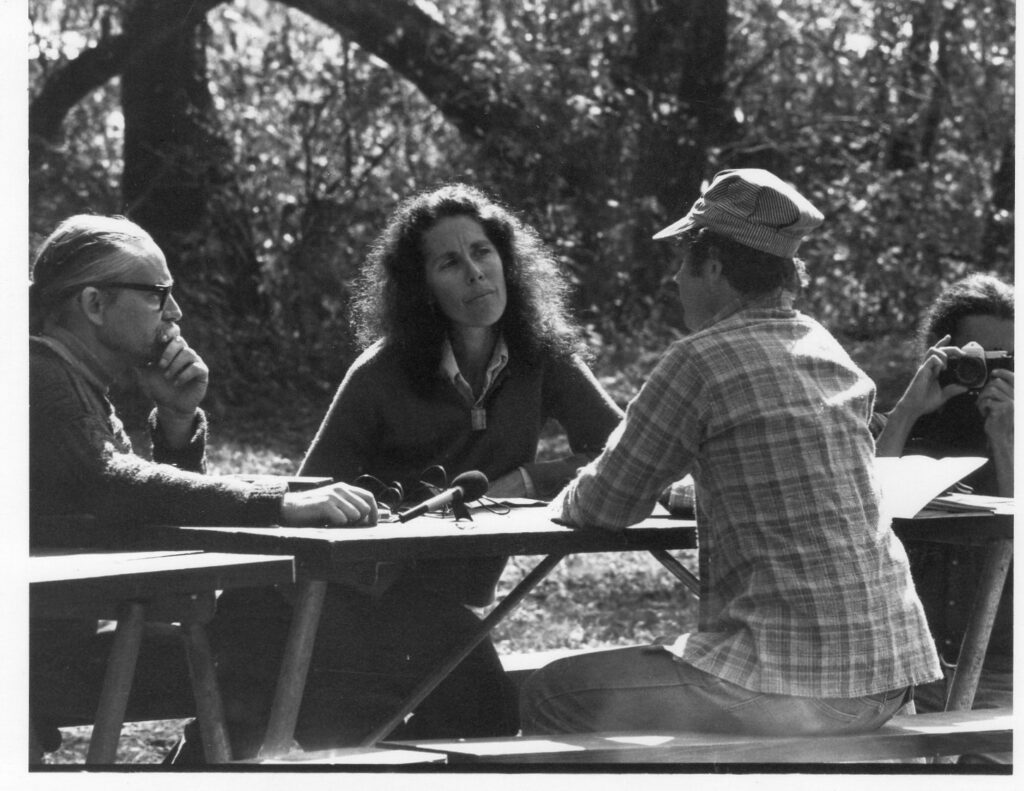
Denise Henderson Vaughn is a longtime co-coordinator of the Ozark Area Community Congress, which will gather for the 44th year this October. She lives in the Jacks Fork watershed in the Ozarks Bioregion. She will travel to D.C. in June of 2023 for the Smithsonian Festival on the National Mall where she will help OACC co-coordinator Sasha Daucus to showcase the Ozarks Seasons poster that was created nearly 40 years ago with inspiration from Planet Drum bundles. You can read more about and order the poster here: https://ozarksresourcecenter.org/seasons-poster/.
<<<<—————–>>>>
By Chris Carlsson – May 28, 2023
A Green City?
San Francisco is probably a “greener” city today than it has ever been since the beginning of urbanization in 1849. There are more street trees and more park land. There are wildly successful restoration projects in the Presidio’s El Polín watershed and along Mission Creek (and more to come in India Basin and Yosemite Slough), which combined with the City’s Department of Environment Natural Areas Division are giving the original web of life on our tip of the peninsula a real shot at renewal. None of this was true 50 years ago when the Planet Drum Foundation was founded. The Bay itself is probably less toxic than it has been in decades, thanks to the Clean Water Act and countless billions spent on sewage treatment. The stunning clarity of the skies during the Covid lockdown was a revelation, proving that we CAN stop this madness and—though we have failed to take advantage of it this time—reorganize and change how we go about making life together.
I met Judy and Peter at a Planet Drum lunch they invited me to in 1993. I’d known about the Green City Project they were promoting, and the word ‘bioregionalism’ had entered my world, but I knew almost nothing about Planet Drum at that point.
I’d heard of the Diggers thanks to reading Ringolevio years earlier, but it wasn’t until later that I understood that the characters in Emmet Grogan’s novel were thinly veiled versions of real people, especially Peter Berg! Not that the novel’s version was “true” exactly, but after I got to know Peter a little, it wasn’t hard to see where reality and fiction overlapped a bit.
I remember showing up with Dave Snyder and Dave Cohen, two other bicycling activists from the first year of Critical Mass rides, to a bountiful feast of salad and fresh bread and a group of sweet, mostly young people gathered around a big table in the kitchen on 30th and Harper Streets. Peter and Judy welcomed me, and I enthusiastically joined in, anxious to discuss the Green City concept which resonated strongly with my years of radical writing about the stupidity of modern work, as well as anti-nuclear and ecological politics. Ostensibly it was my role in helping launch Critical Mass that had prompted the invitation, but I had a bigger agenda.
As I recall, Peter was pontificating about getting some downtown corporations to “buy in” to the Green City concept—which set off my alarms, as I had been publishing Processed World magazine since 1981 at that point, and if there was anything I felt really strongly about it was that most of the work being done in the Financial District was a HUGE waste of time. It wasn’t about reforming it or making it behave better ecologically—it was long past time that whole swaths of the modern economy should simply be abolished outright! Banking, insurance, real estate, advertising and public relations, stock brokers, the list was endless. I said something along these lines and within minutes drew Peter’s wrathful attention.
“What?!? What are you, some kind of Marxist?!?” he demanded.
Not a particularly auspicious way to begin our relationship.
“Well, sometimes, yeah. But the point is if we’re promoting the idea of a Green City project, don’t we have to challenge all the work going on right now that is destroying the planet? Don’t we have to propose doing an awful lot of OTHER work, from urban farming to replumbing the city, that is going undone right now? How can we talk about a Green City without talking about work?” I figured this was pretty obvious.
I can’t remember where it went from there, having suppressed my memory of the very awkward minutes that followed that opening exchange. I stayed through the lunch, and I recall leaving on a pretty good note, Peter saying to Judy or someone else that he thought we were going to make some “strong medicine together” in the future. That felt ok to me. I didn’t really dig his metaphor, but I definitely thought we should be allies, even if we had rather different emphases and ways of framing what we were up to.
They ended up bringing the typesetting and layout for the Planet Drum publication Raise the Stakes to my small graphics business, which lasted until they could find someone to do the work for free again. Now, years later, I’m still working with Judy on the Planet Drum Pulse, one of my last desktop publishing clients.
When we began sketching out what would eventually become Shaping San Francisco, originally on a CD-ROM and a half dozen public kiosks, ecological history was a central concern that we sought to include. That led to reproducing a small text about Planet Drum as part of our Ecology section, but more importantly, we also foregrounded as much as we could ecological histories that were socially rooted, embodying my own overriding interest in connecting the ongoing ecological crisis with the work we do. How could we understand the odd paved over, over-built city of San Francisco without understanding the types of work that had been done, under what conditions, and under the direction of which values and ownership structures? And how could we understand all the decisions that shaped how work was decided upon, how it was carried out, and how it shaped our world, without understanding what the natural world was AND IS here in the city? After all, paving over creeks, dunes, and wetlands does not get rid of them, it just buries them under cement.
In that regard, I think the work done by Planet Drum, stretching back to the Frisco Bay Mussel Group discussions in the late 1970s at The Farm, to the spread of bioregionalism into the pores of radical ecological thought everywhere, to the promotion of the Green City project concept, all helped shape a climate of thought in which nature was and is always present. Building on Ray Dasmann’s work, Peter and Judy and their wide circle of friends and colleagues helped all of us to re-center nature, even in the most urban of environments. Today’s San Francisco, with its Natural Areas, its open hilltops, a much healthier Bay, its demilitarized bases now serving as delicious parklands, are all lasting testimony to the legacy of a group of radicals who started out insisting that everything should be free and finding new ways to connect urban life to surrounding agricultural abundance.
Over time we learned to see our asphalted public spaces as an insult to our collective possibilities. We’ve come to enjoy a shoreline more accessible than ever, but more threatened by sea-level rise than ever. Our insistence on poison-free food led for a time to a burgeoning alternative world of food conspiracies and eventually collectively run food stores that understood the many forms of exploitation at the heart of modern industrial food systems. It also led inexorably to the Piles of Pornographically Perfect Produce at Whole Paycheck because, for all the good initiatives and profound challenges we’ve managed to push out there during the past half century, the Capitalist Market has proven its absorptive flexibility again and again. For all the ways that our common sense is so different today than it was 50 years ago, we can’t escape the sad truth that the most destructive forces on the planet are still in the driver’s seat—whether we’re talking about globe-straddling fossil fuel giants, or the thoughtless normality that allows us to casually linger in the shower, or drive when we can bike, or discard when we might repair.
Our collective future requires collective rebellion. Change your lightbulb—why not? Better is better than worse. But if we really want to live in a world with a real future for life in all its abundance and diversity, we have to find a way together up and over a much higher mountain than we’ve scaled before.
Chris Carlsson, co-director of the “history from below” project Shaping San Francisco, is a writer, publisher, editor, photographer, public speaker, and occasional professor. He was one of the founders in 1981 of the seminal and infamous underground San Francisco magazine Processed World. In 1992 Carlsson co-founded Critical Mass in San Francisco, which both led to a local bicycling boom and helped to incubate transformative urban movements in hundreds of cities, large and small, worldwide. In 1995 work began on “Shaping San Francisco;” since then the project has morphed into an incomparable archive of San Francisco history at Foundsf.org, award-winning bicycle and walking tours, and more than a decade of Public Talks covering history, politics, ecology, art, and more (see shapingsf.org). Beginning in Spring 2020, Carlsson has hosted Bay Cruises leaving from Pier 52. Carlsson has written three books, the most recent being Hidden San Francisco: A Guide to Lost Landscapes, Unsung Heroes, and Radical Histories (Pluto Press: 2020). His 2004 novel is set in a future “post-economic” San Francisco (After the Deluge, Full Enjoyments Books: 2004), and his groundbreaking look at class and work in Nowtopia (AK Press: 2008) which uniquely examined how hard and pleasantly we work when we’re not at our official jobs. He has also edited six books including three “Reclaiming San Francisco” collections with the venerable City Lights Books. He redesigned and co-authored an expanded Vanished Waters: A History of San Francisco’s Mission Bay after which he joined the board of the Mission Creek Conservancy. He has given hundreds of public presentations based on Shaping San Francisco, Critical Mass, Nowtopia, Vanished Waters, and his “Reclaiming San Francisco” history anthologies since the late 1990s, and has appeared dozens of times in radio, television and on the internet.
<<<<—————–>>>>
By Herman Greene – May 29, 2023
We of the Center for Ecozoic Studies (CES) celebrate with admiration and enthusiasm the 50th Anniversary of the Planet Drum Foundation and its founder Peter Berg. Having been founded in the year following the inaugural Earth Summit of the United Nations in 1972, Planet Drum was there at the beginning. Planet Drum more than any other organization developed the ideas of bioregionalism and reinhabitation. Not only did they develop these ideas, they have applied them in Ecuador, San Francisco, and other places. CES believes bioregionalism is so important that we call it one of three “building blocks” of ecozoic societies, the other two being the universe story and ecological spirituality.
We wrote, “The second building block of ecozoic societies is bioregionalism. A ‘bioregion’ is a naturally occurring geographic division of Earth that contains an interacting community of life functioning as a relatively self-supporting system within the ever-renewing processes of nature. To think bioregionally means to think of humans as being co-existent with and dependent upon the natural order, not as being dominant over it. The role of humans in the bioregion is to appreciate and celebrate its diversity and to honor and preserve its vitality, including the human part of it.”
We express our deepest good wishes for the continuation of Planet Drum Foundation’s critical work.
Also included is a piece written by Peter Berg about Thomas Berry (source publication: Peter Berg, “Meeting Thomas Berry, Biospherean,” The Ecozoic Journal no. 2 (2009), 18-19.)
Meeting Thomas Berry, Biospherean By Peter Berg
Thomas Berry watches the same eclipse of the sun we all see. Many observers are shocked by the gradual loss of light and point at the darkness, shouting alarms. Thomas concentrates on the bright nimbus continuing around the shadow. He believes the full sun will gradually return and tells us how it will look then.
Within minutes of first meeting Thomas in the ‘80s at his sanctum above the Hudson River, he asked if it was all right to borrow the words “bioregion” and “reinhabitation” for an essay he was writing. It was a highly memorable introduction to his interpersonal sensitivity and elegant manners, traits that were always present whenever we spoke. Those ideas were being used by a widening circle of people at that time (although no one had requested permission before) and it was gratifying to know he thought they were useful for illuminating the future post-eclipse era.
Paul Ryan, the visionary video and ecology artist who had once been his student in the Catholic Passionist Order, had arranged that meeting apparently at Thomas’s request. It seemed by happy chance that the three of us very quickly started discussing topics such as homo sapiens seen from the same perspective as other mammals, so-called “primitive” people, and the place of ecological consciousness in civilization. It wasn’t an accident, of course. Berry isn’t oriented toward spirituality in the conventional sense. He never used the word “God” when we spoke, saying instead, “We ought to close the Bible and not open it for a hundred years.” He knew we shared awareness that there was an urgent need to radically reinterpret civilization in order to preserve Earth. He wanted to get right on with exchanging possible solutions.
Berry comes by his eco-centrism (a “geologian” he calls himself) authentically as an assistant to cosmologist-philosopher Teilhard de Chardin who was an early adopter of the term “biosphere.” Wide travels in Asia stimulated his interest in trans-cultural ideas. (His personal collection of anthropological works seemed dominant in his study and was one of the largest outside an institutional library I have seen). There is a North Carolina down home country rootedness under it all that was as omnipresent as the gigantic hundreds-of-years-old oak tree that grew just outside his window. Thomas’s eyes can narrow at times like the edge of a stone outcrop when he is carefully listening or making a point. More than just a serious facial expression, it is a canny look that a hill farmer might have making a crucial survival judgment. It was visible when he explained the difference between himself and the people who called themselves conservatives. If self-declared conservatives clear-cut forests or destroy topsoil or pollute air and water to make money, they’re acting radically. Thomas said he was the real conservative because he wanted to preserve the environment.
At that time Berry’s written work was reproduced on an office copier and sent to his mailing list or handed out. He didn’t seem to have any intention to distribute it in a more formal way than this forerunner of contemporary internet distribution. It was obviously an extension of his “mission” rather than a career. And it was autobiographical in a way because he was steadily working his way toward his eventual personal philosophy. I always think of this when I see his later books. There is a shining seam of dedication that runs through their original self-publication and the work of strongly committed non-academic environmental activists.
Thomas Berry is strikingly genuine and original. He was an insider as a leading priest in a formal religion, but developed a major outsider view. It arose from searching for earth/human unity in his own and other religions, and when a satisfying version to lead out of the present eclipse couldn’t be found, he courageously formulated a New Story.
Herman Greene is the founder and president of the Center for Ecozoic Studies in Chapel Hill, North Carolina, a thought, imagination, dialogue, and action center for an ecological age. He is Thomas Berry Scholar-in-Residence of the Earth Law Center and is co-author and co-editor of the legal textbook Earth Law: Emerging Ecocentric Law—A Guide for Practitioners. He is a resident of the Piedmont Bioregion.
<<<<—————–>>>>
By Cheryll Glotfelty – May 31, 2023
Happy 50th, Planet Drum!
Every member of the Planet Drum circle can tell you of their first encounter with Planet Drum.
I was Professor of Literature and Environment at the University of Nevada, Reno. In 2006, I was teaching a graduate seminar on Bioregional Literature and Theory, a topic new to me and an approach that offered a proactive, positive alternative to the defensive, jeremiad-style finger-wagging of much environmental discourse. As an introductory text, I had assigned Reinhabiting a Separate Country: A Bioregional Anthology of Northern California, edited by Peter Berg and published in 1978 by Planet Drum Foundation, San Francisco, California. Everything written by Peter Berg in that book–the Introduction, “Reinhabitory Theater,” and “Reinhabiting California” with Raymond Dasmann–struck me as sheer genius. His prose flashed dazzling lightning bolts and lit me up.
My graduate students and I became increasingly persuaded by the bioregional paradigm, and we also became curious about how a bioregional approach could be applied in a large, urban context and not just by back-to-the-landers. The word “Foundation” in “Planet Drum Foundation” evoked images of a corporate headquarters with a formal boardroom and floor-to-ceiling plate glass windows on a top floor of a skyscraper. Nevertheless, my students and I were inspired to make a weekend field trip to San Francisco to see for ourselves some of the urban bioregional projects that we’d read about, and, if we were lucky, meet Peter Berg and get a tour of the Planet Drum headquarters.
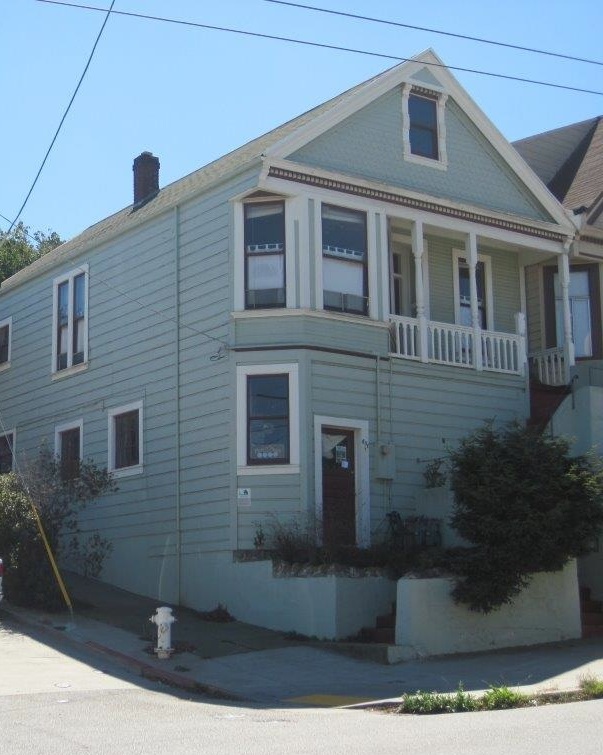
On a foggy, chilly SF day on October 1, 2006, seven students and I managed to find the Planet Drum (PD) headquarters on 30th St. in the Glen Park district of the city. Surprise! The PD address took us to a two-story, peaked-roof, sage-green Victorian house, with neat white and burgundy trim and a small front porch. Hmmm. Could this be the right place? Sure enough, a student spotted a small wooden sign in a basement window with the lettering PLANET DRUM FOUNDATION and a row of four blue-and-tan circles representing a map of all sides of Planet Earth. Below that, screwed to the side of the basement wall, we noticed a metal sign explaining that the sidewalk strip garden was natural habitat featuring native plants. As we would soon learn, Planet Drum Foundation occupied the cluttered basement of the house where Peter Berg and his partner Judy Goldhaft lived!
My students and I have indelible impressions from that unforgettable meeting with Peter and Judy. I recall seeing a calligraphy-lettered poem by Lew Welch on the wall of the basement.
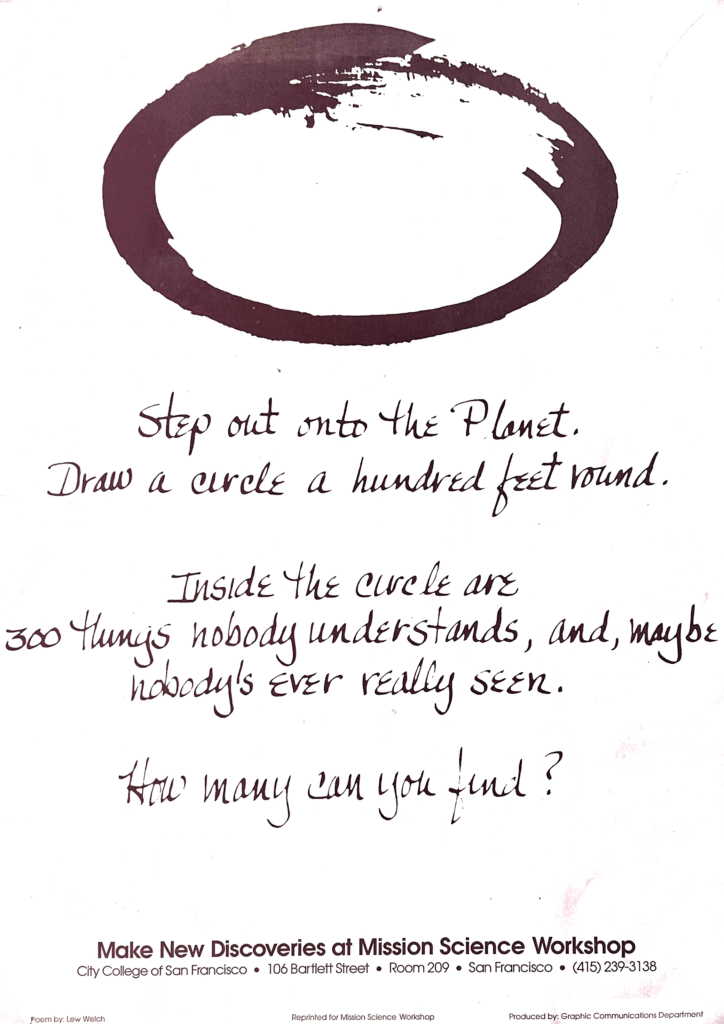
I pointed it out, and Peter said something puzzling. He stated that poetry is the most radical political act. “Really?” I thought, “how?” Even as an English Professor, in love with words and writing, I had tended to regard poetry as a highbrow pastime, a sophisticated literary genre studied in college classes. I asked Peter what he meant, and he said bluntly, as if it were obvious, “poetry changes consciousness.”
For my students, memorable moments from our visit to Planet Drum included Peter’s guided tour of the sidewalk native plant garden they lobbied the city to be allowed to plant. He introduced each seemingly nondescript plant as if it were a beloved family member. Peter’s tour of nearby Glen Canyon Park was likewise eye-opening, as he compared the non-native eucalyptus monoculture of a hillside–a habitat desert–to the tangled, wild undergrowth near the trickle of a stream, home to thriving biodiversity in the midst of San Francisco’s concrete jungle. We concluded our visit with the map-making exercise that Peter perfected, teaching each of us how to reimagine our homeplace in ecological terms. On the outside, the day was humble. We visited an aging couple in their middle-class home and looked at some rather scrappy and unkempt plants. But on the inside–in our consciousnesses and imaginations–that encounter rocked our world.
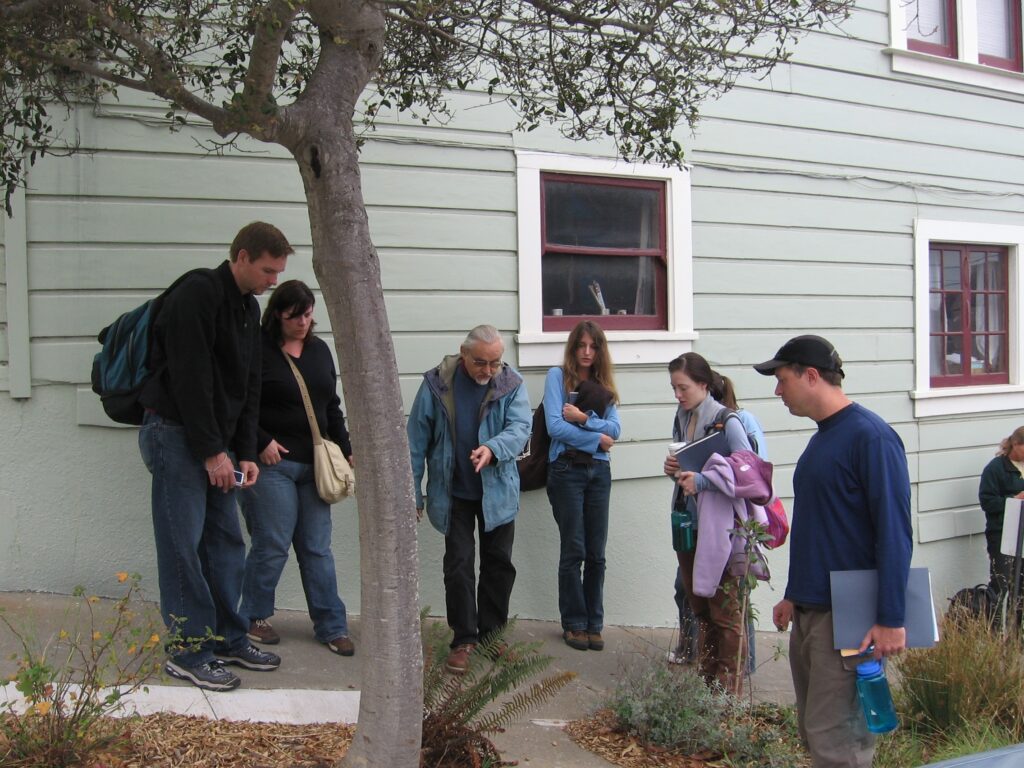
One student in particular, Eve Quesnel, was like a terrier in her unwillingness to let go of Planet Drum. Four years later, in 2010, she contacted me to say that she missed Peter and Judy, and did I want to see them again? Huh? I had viewed that fieldtrip as a one-off and assumed that Peter and Judy, who were always busy, wouldn’t appreciate us dropping by just to say hi. But Eve wouldn’t let up, and eventually I shrugged, “Sure, if you arrange it, I would be happy to see them again.”
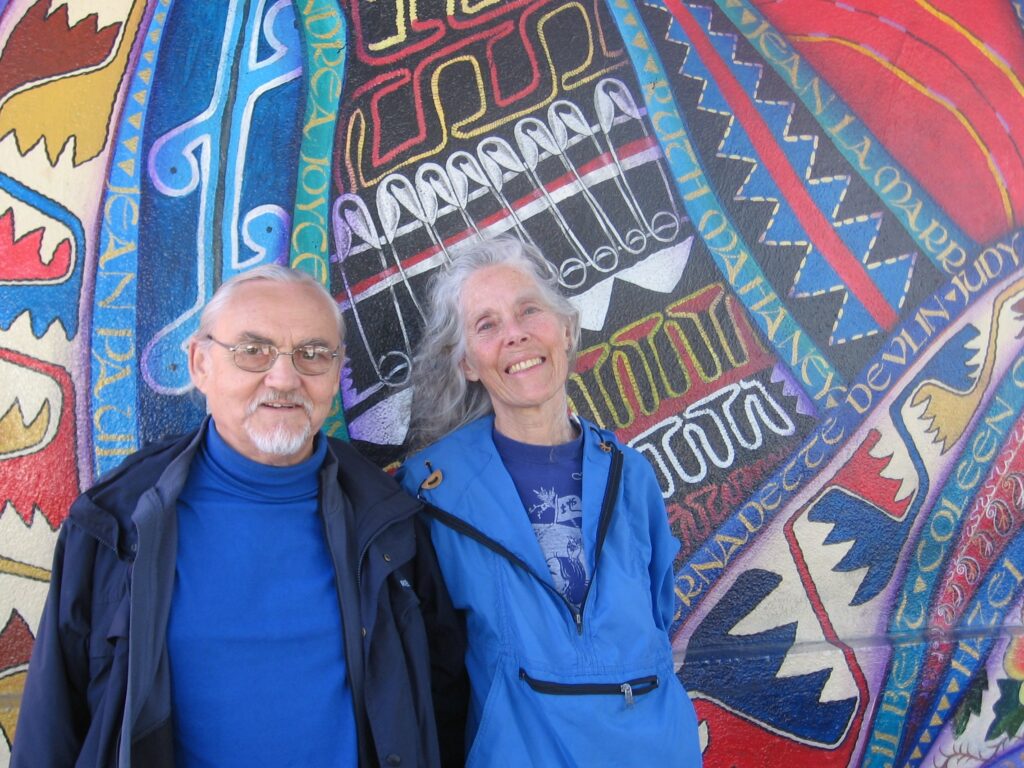
So, over the eastern Sierra, down the west side, through the Sierra foothills, across the Central Valley, and over the bay we drove to rendezvous with Peter and Judy. They gave us a colorful tour of some SF street murals and the street art of Banksy, and we had lunch at a place in the Dogpatch neighborhood as they told us about a circus school located under the freeway overpass, if I’m not mistaken. On the drive home, Eve and I mused that there should be a book of Peter’s uncollected writings. Peter Berg was a prolific essayist, poet, visionary, and philosopher, whose writings had almost all appeared in ephemeral underground newspapers and newsletters–not digitized, not indexed. Many of Peter’s essays had been collected and published in his book Envisioning Sustainability (Subculture Books, 2009), but just as many hadn’t. As an anthologizer, I ached to think that some of Peter’s work might be lost to history, and I wanted to make his paradigm-changing and utterly practical bioregional ideas available to today’s generation. Peter was having some health problems, and Eve and I felt a sense of urgency. I wanted to tape an interview with him, introduce his work, write a biographical sketch, and also produce a comprehensive bibliography. (The bibliography proved to be very possible, thanks to Judy’s filing cabinets of clippings and her dedicated archiving of Peter’s work over decades.) Eve thought that it would be cool to honor Peter by having his running mates write tributes.
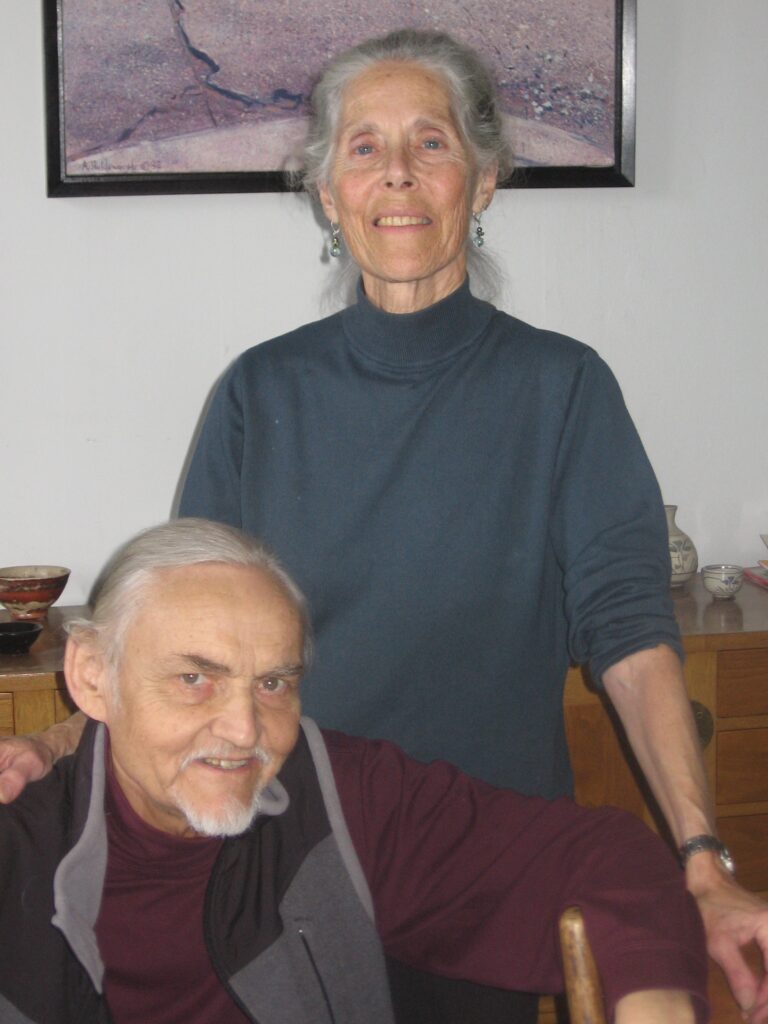
Thus, was born the idea for our co-edited collection The Biosphere and the Bioregion: Essential Writings of Peter Berg (Routledge, 2015). Although Peter was highly skeptical of academics, our passionate belief in the project’s potential impact ultimately brought him on board. Working on that book entailed several more visits to Planet Drum, and Eve and I were able to witness the remarkable partnership of Peter and Judy. Judy recognized Peter’s brilliance and shared his vision. Both of them have worked tirelessly and with astonishing originality, creativity, and theatricality to build, as Peter says, quoting the Wobblies, “a new world within the shell of the old.” Peter is the outspoken savant, always at least twenty years ahead of his time, and Judy is his loyal partner and guardian. Eve and I at times referred to Judy as “dragon lady” for her fierce defense of Peter’s legacy.
The beautiful flow of people who have pitched in with Planet Drum over its fifty years, most of them unpaid volunteers, have pulled off what no corporate-style environmental organization has done: green the city and change culture. Much love and gratitude to Peter Berg and Judy Goldhaft, together the beating heart of Planet Drum. Judy soldiers on, dancing the good dance, while Peter–the red-tailed hawk soaring overhead–is with us in spirit as we now, after fifty trips around the sun, blow the conch shell to proclaim, “Long Live Planet Drum!”
Cheryll Glotfelty is the co-founder of the Association for the Study of Literature and Environment (ASLE) and is retired from a 28-year career of teaching at the University of Nevada, Reno. She is the co-editor of The Ecocriticism Reader: Landmarks in Literary Ecology, The Bioregional Imagination: Literature, Ecology, and Place, and The Biosphere and the Bioregion: Essential Writings of Peter Berg. She lives in the Great Basin Bioregion.
<<<<—————–>>>>
By Patricio Tamariz – June 5, 2023
From my book, Secret of Paradise, I have included an excerpt from the chapter, “Bahía the Eco City ~ A Tribute to Peter Berg.” For the full chapter, please click here.
“Hermano, good to see you again,” was our most common phrase of greeting in the last years with Peter. Sometimes this was the only phrase we would to say to each other on a yearly basis, especially on his last few visits. This was partially due to my being busy with the government or on a special project consulting for the Ministry of Tourism and not having enough time to sit with Peter here in Bahía. I always was saying to myself “next time he visits, I will meet with him like I used to.”
Peter would travel many times a year to work in Bahía for the Planet Drum Foundation. His work centered on Bahía, its people, and surrounding natural systems, so that one-day we could have a Model of Urban Sustainability, our Eco city. This was something I asked of him since the first time he came to our quaint beach city in 1999, still battered by the natural disasters of 1998. My only wish is for you to understand my relations with this man, who was so ahead of our times and truly part of my family.
On Peter’s arrival to Bahía de Caráquez, I knew immediately that Bioregionalism was much more than environmentalism and that it depended not on geopolitical boundaries, but on geographical boundaries that made so much more sense. The water sheds, so important for all types of life human/animal, plants, trees and more, led way to important natural systems that held their own ecosystems. From there on, I made the deductions that human history from one water shed (or bioregion) to another, evolved in harmony with the own specifics of each region, different but complementary to each other.
A genius in life, Peter was a maestro for someone who was searching for more and wanted Bahía to excel in leading Ecuador to become a sustainable paradise. He came in, set up his foundation and was able to keep the dreams of an Eco city alive here in Bahía.
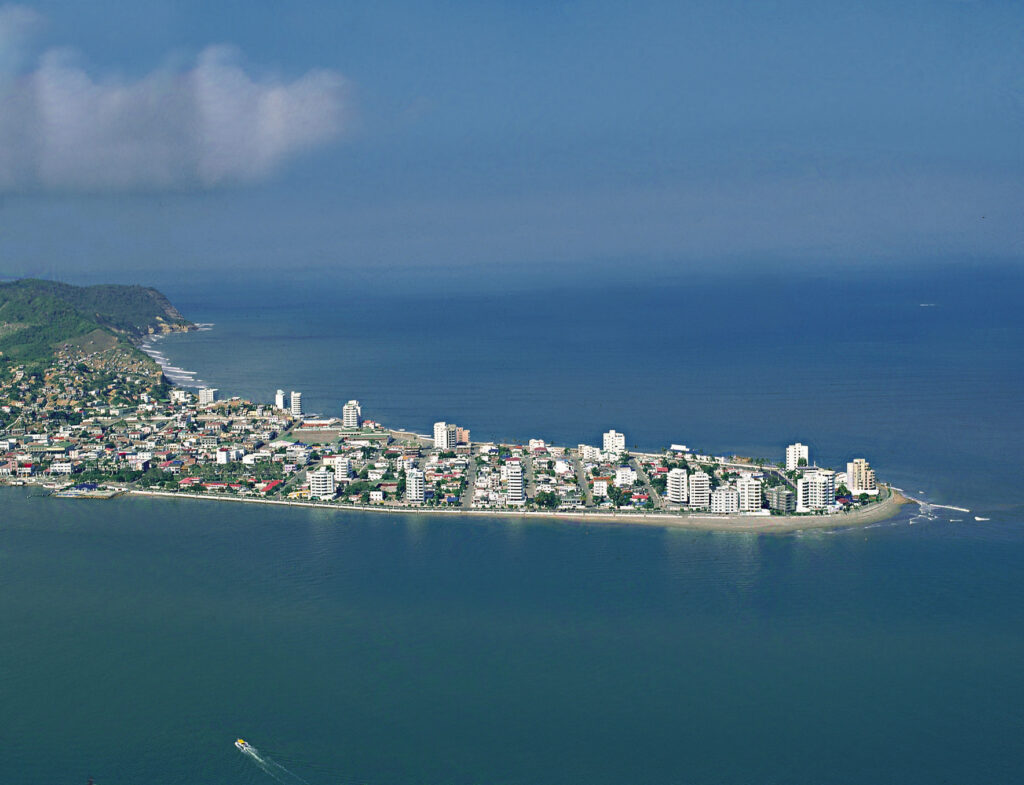
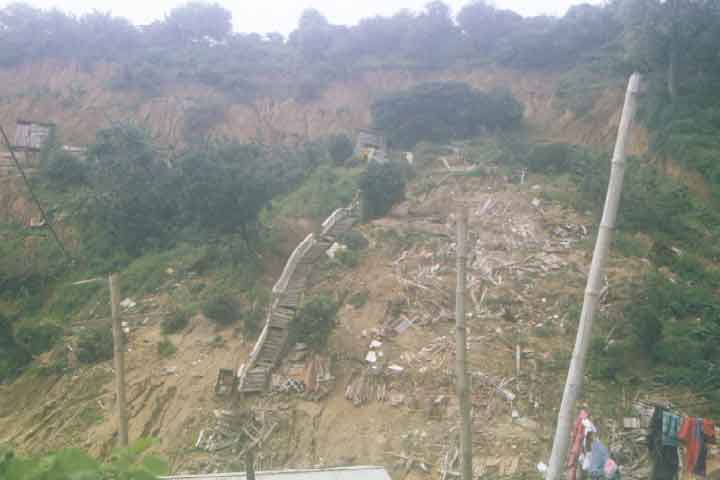
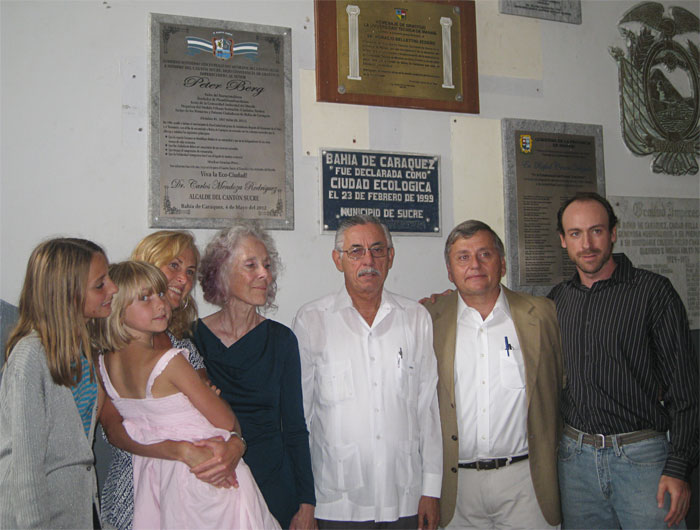

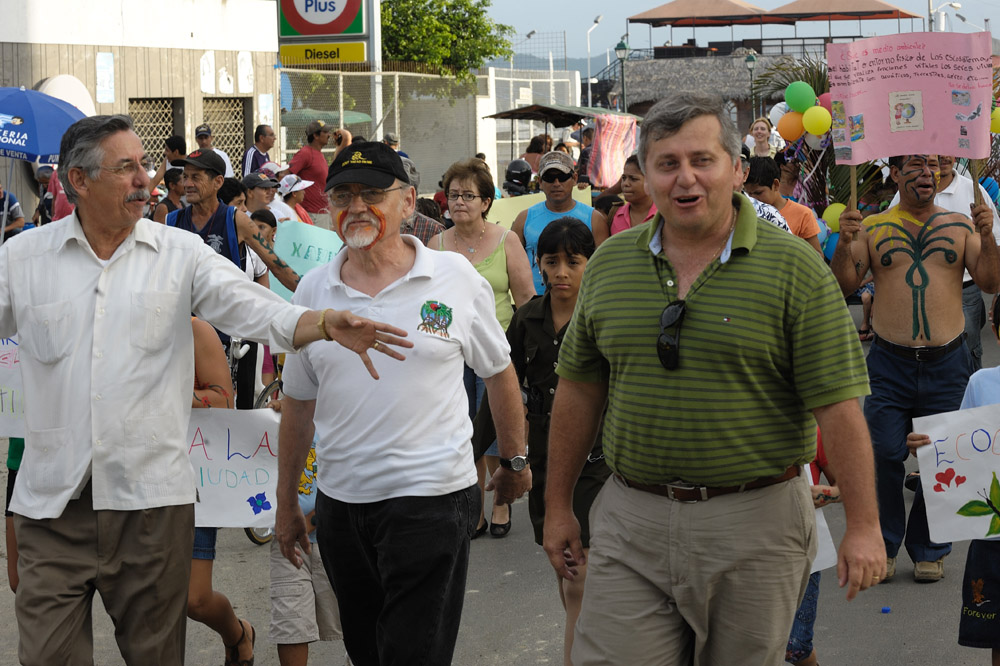
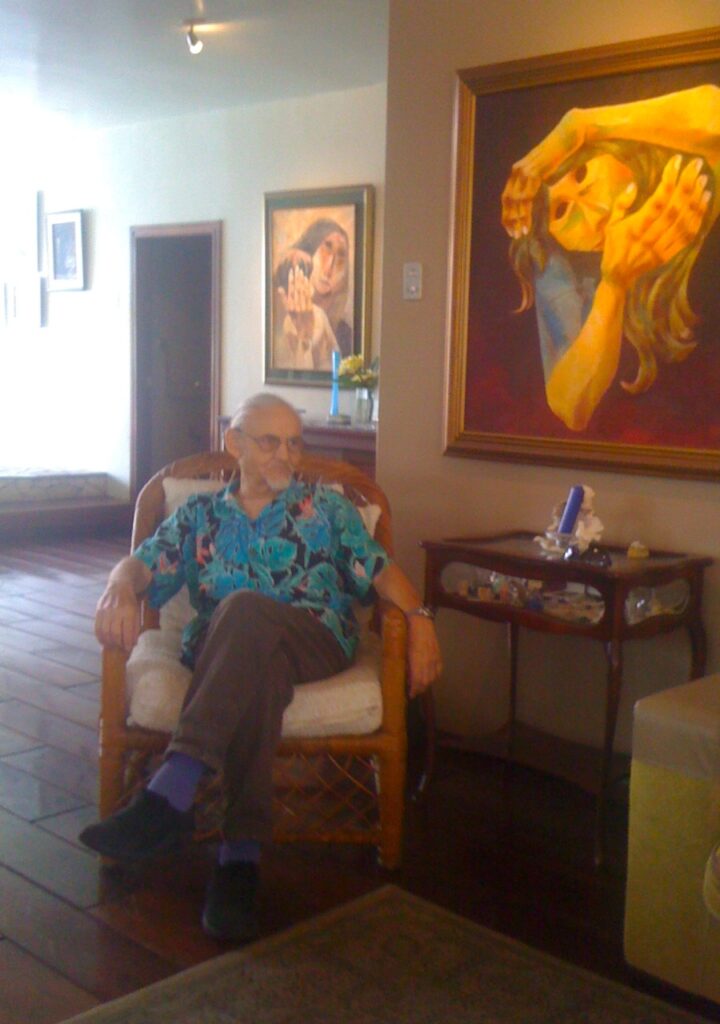
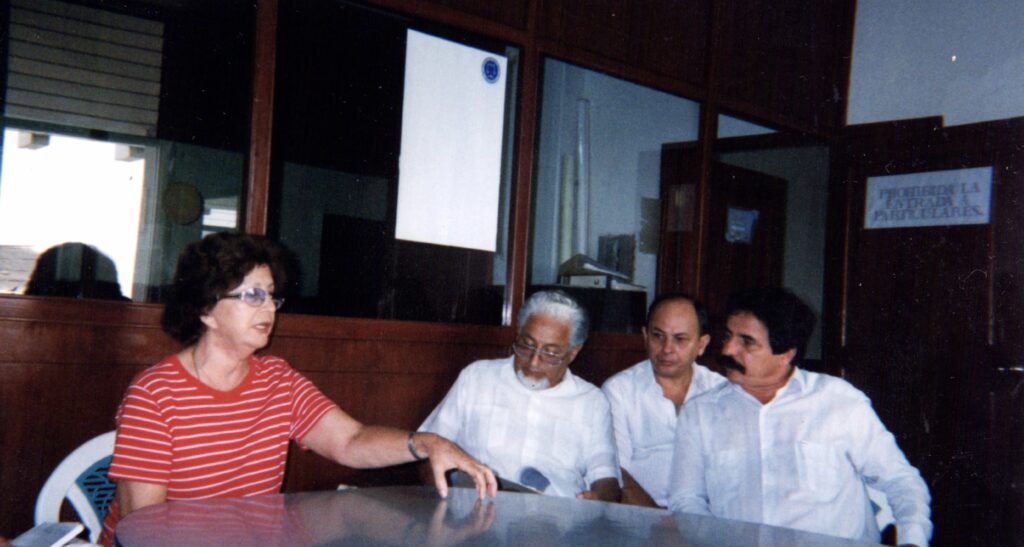
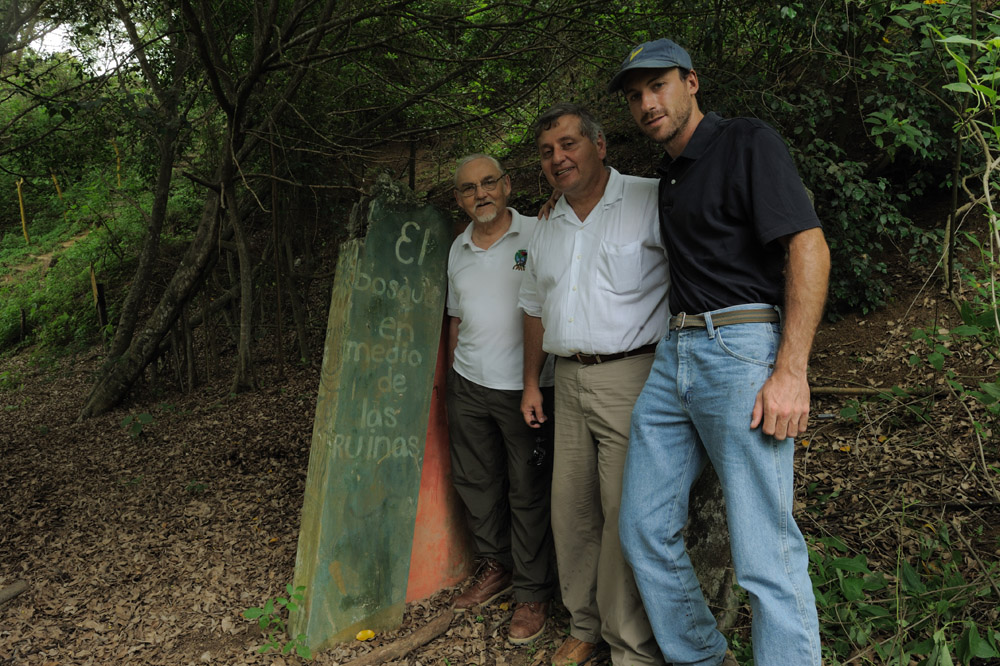
Patricio Tamariz is one of the founders of the Bahía Ecocity Movement, ex Viceminister of Tourism of Ecuador, National and International Consultant and now Tourism Advisor to the Prefecture of the Province of Manabí. He is an advocate of Sustainable and Regenerative Tourism and lives in the Estuario del Rio Chone bioregion.
<<<<—————–>>>>
By Mathias Rollot – June 6, 2023
To me, Planet Drum’s bioregional vision is a living soul.
It’s a rhizomatic spirit that you meet one day. It suddenly sticks to you, and takes place inside of you. Quite strangely, this external body of radical utopias, ecopolitical acts and indigenous thoughts seems to be able to live inside of you, to consider you its home. It grows from roots that dig deep inside your mammal body, it blooms and enlightens the darkness inside you, it nurtures your soul and ferociously shakes your internal structures, habits and beliefs. As it flourishes, it slowly provides anchorage for you, paradoxically reinforcing you from your own self. Such an ecological power-from-within may be your new strength to contribute to the livability of the places where you stand. It could help open and resist, walk and listen, sing and shout in relation with other living beings that surround you. Hopefully, it may never leave you.
I’ve been contaminated (see for instance chapter 2 “Contamination as Collaboration” in Anna Tsing’s The Mushroom at the End of the World) by Planet Drum’s vision quite recently – in 2016. But it has not only profoundly influenced my thoughts and work as an architect; in a way, it has changed my way of life as much as my understanding of the concept of « life » itself.
In France where I live, Peter & Judy’s legacy is constantly growing, in the sense that a living being is growing – it is alive, and so it contributes to the liveliness of the places and the vitality of the living beings. But most of all, their living legacy greatly helps us to face the terrifying 21st century that stands in front of us. And, indeed we need help.
Mathias Rollot is an architect and scholar living in biorégion alpine (Grenoble, France). In the past, he wrote several books about architecture in a bioregional perspective (see for instance https://wildproject.org/auteurs/mathias-rollot), and founded an online bioregionalist bibliotheque (https://bioregions-bibliotheque.fr/). Since 2021, he mainly works on an animalist theory of architecture.
<<<<—————–>>>>
By Zach Stewart – June 7, 2023
Judy and Peter were part of a tribe of around one hundred people who created a global change some years ago.
<<<<—————–>>>>
By Ocean Berg – June 10, 2023
Planet Drum in the early 1990s was full of young woman and vibrant, lively and fun energy. Sabrina Merlo was heading the Green City Project, Deborah Hubsmith was the grant writer and we had various young folks (mostly college aged) interns floating in and out.
As membership coordinator I had a lot of engagement with the folks who subscribed and purchased printed materials. Judy and Peter gave full artistic reign to the production of renewal letters and packaging of materials. This position required organization and database entry and they were both patient with my learning process.
Staff lunch once a week was a highlight. This was a potluck meal with a Judy centerpiece. Favorites included baked polenta, Mediterranean platter, cilantro and peanut pesto and black bean chili.
Occasionally we would attend bioregional gatherings. It was interesting to visit like-minded folks in different regions of North America. My favorites were the first one I attended as a teen and the last one where Debbie, Sabrina and I represented Planet Drum and were given important decision-making roles (Judy & Peter did not attend).
As Peter & Judy’s daughter, Planet Drum was a constant in my life. Joining the team as an employee deepened my understanding and appreciation for their important, land breaking tireless work!
A quote? Peter would always sign letters “In diversity” so that’s how I will end this one!
Ocean Rush Berg is a Perinatal Nurse and Lactation Consultant who most recently has worked for San Francisco Department of Public Health as a public health nurse and at California Pacific Medical Center as a lactation consultant. Ocean lives in the Shasta bioregion and splits time between the San Francisco Bay and Mattole Watershed. She is the proud mother of 4 young adults, three cats and a frisky pitbull and loves family time & gardening.
<<<<—————–>>>>
By David Zane Mairowitz – June 12, 2023
Below is the transcript from an interview with Peter Berg from the Australian Broadcasting Co radio documentary My‚68 (2008). You can listen to the full interview, which includes other people, here.
Narrator
A few days later I’m nursing my jet-lag in the famous Haight-Ashbury “hippie” district of San Francisco. I’m also editing an “underground” paper here, the San Francisco Express Times, aka Good Times. It’s a ten-thousand-kilometer commute between “jobs” – if you can call it “work” — but in these days, “trips” are equally measured in micrograms, and, most of the time, we don’t really know where we are in any case.
Peter Berg: My name is Peter Berg. I’m director of Planet Drum Foundation, which is an ecological, activist organisation. We promote the idea of bioregions throughout the planet.
Narrator
Yeah. Everywhere else in this exploding world people use the words “nation,” or “state.” But here in San Francisco in 1968, the key word is “planet.” Peter Berg, a leading “Digger,” uses it freely, and his vision of the radical events of this year is truly “planetary.”
Peter Berg: I identified with the Situationistes in France and with the Provos in the Netherlands and with the Kommune People in Germany.
Peter Berg: It was a perpetuation of the anarchist philosophy of the 17th and 18th century….It’s a completely legitimate form of human freedom.
Narrator
If there is something uniting all these groups –which I personally don’t believe – Peter thinks this is classical Anarchism. In any case, in San Francisco in May 1968, you can see how the State has failed in its obligations to look after people. After the so-called “Summer of Love” in 1967, over a hundred thousand kids are streaming into town from all over the planet, with no money, nowhere to live and no apparent future.
Peter Berg: We saw them as refugees from mainstream America… and mainstream America was breaking down…. Instead of peace, love, creativity, etc., they were being offered war, death, a money economy, a life of servitude in jobs…. So they flocked to a place where they thought it could be done.
Narrator
The Diggers certainly don’t “organise” themselves into a “group” or political entity. They just “turn up,” taking their name from 17th century English farmers who illegally cultivated what they saw as “common land.” This is not so much anarchism as classical communism with a small “c” and no Politburo.
Narrator
There’s no time for theory. Everything depends on Performance. “Do your own thing.” Left and right in San Francisco I’m collecting tracts for my book, including one which says: “This is a worthless piece of paper…. Use it to start a fire or for toilet paper; tear it up for confetti and celebrate the free city; use it to start a revolution. Wad it up and throw it at your lover.” My favourite is one that reads only: “Today is the first day in the rest of your life.”
Narrator
“Eternity is Now;” “A Vote for Me is a Vote for You.” It’s May 68. I’m in Slogan Paradise. The language of bourgeois America is being turned around and spit back in its face. And the chief code word of the Diggers is “FREE.” They deal with the city’s urban crisis by creating Free health clinics, giving out Free newspapers, Free food in Panhandle Park and a Free Store.
Peter Berg: The Free Store was the epitome of participatory theatre. First of all, you tell somebody it’s a store and that everything in it is free. And the name of it was “Trip Without a Ticket.” It meant you should indulge in a journey that won’t cost you anything….
Peter Berg: Every morning we would find a pile of goods on the sidewalk outside the store… and these 100,000 people on the streets of Haight-Ashbury would come streaming in…
Narrator
I’m still out looking for “worthless” paper.
Narrator
And suddenly there it is on a wall in front of me: an amazing poster for my book of revolutionary ephemera: It says: “1% Free.”
Peter Berg: The poster is… of two Chinese Tong men who were the enforcers for the Chinese gangs…
Peter Berg: At the top is the Chinese character for moulting or revolution…
Narrator
And at the bottom…
Peter Berg: … is the slogan “1% Free.”
Narrator
This mystical poster is stuck up outside banks, stores, etc. And it’s anybody’s guess what “1% Free” is supposed to mean.
Peter Berg: I’m really proud to tell you that just as the word “Digger” provoked people… it was meant to be provocative.
Narrator
Not only provocative. There’s a rumour going around the Haight-Ashbury that the Diggers are opening a “Free Bank.” That is, anyone who needs money just walks in and asks for it, you don’t even need to have a hold-up. And where does the “Free Bank” get its free money? Well, the rumour says that all the local pop stars getting rich – the Jefferson Airplane, Janis Joplin, the Grateful Dead, etc., as well as the psychedelic boutiques, should donate “1%” of their profits to the “Free” bank, thus the slogan “1% Free.”
Peter Berg: It was interpreted by the merchants on Haight Street who sold beads and candles and marijuana paraphernalia … to mean they should give 1% of their money (laughs)…
Narrator
So the idea of the Free Bank is a myth?
Peter Berg: One of these people said he wanted to be a “free banker.” So whenever people gave us contributions we would give it to him, and he would wear money in his hatband and give it to anybody that asked him for it.
Narrator
So the Free Bank is just some guy walking around with money in his hatband, just giving it away like that?
Peter Berg: As a life act in the Theatre of Free, he would simply take the money out of his hatband and hand it to them. The same person drove a motorcycle down Haight St. and threw coins out of a bag of money into the street to all the people who were panhandling because these “refugees from America” who were turning up in the thousands had no employment.
Narrator
So Digger is really a kind of theatre?
Peter Berg: “Life acting.” We gave people participation in a life-theatre, in an acting out of a political, cultural ideal.
David Mairowitz is a writer and radio producer in Europe, living in Provence and Berlin.
<<<<—————–>>>>
By Martin A. Lee – June 12, 2023
The below tribute was originally published in The Biosphere and the Bioregion: Essential Writings of Peter Berg, edited by Cheryll Glotfelty and Eve Quesnel.
Remembering Peter Berg
It’s not often that you meet someone who actually changes how you see things, someone who changes the way you think about the world. Peter Berg was such a person.
When I first met Peter in 1979, I didn’t know that he was instrumental in introducing ecology to the American Left. I didn’t know of his pioneering work as a bioregional philosopher-activist with the Planet Drum Foundation. I didn’t know that he had written and directed plays for the San Francisco Mime Troupe and that he had coined the phrase “guerrilla theater.” I only knew that he had been associated with a group called the Diggers in San Francisco in the mid-1960s.
I was writing a social history of LSD (Acid Dreams), and I wanted to know more about the Diggers, an anarchist cadre that provided free food for “hippies” in Golden Gate Park during the heyday of the psychedelic era. So, I arranged to visit Peter and his partner, Judy Goldhaft, at their home in San Francisco’s Noe Valley. My intention was to interview them and record their Digger stories. Peter, however, didn’t want to talk about the 1960s. He wasn’t nostalgic about those years, and he wasn’t one to rest on past laurels.
I didn’t learn much about the Diggers that day (that would come later). I never even turned on my cassette recorder. But the meeting was hardly a bust. We spoke for several hours and when I left my head was spinning. Peter dazzled with words and ideas. He articulated a brilliant, overarching, integrative vision, a kind of unified field theory of ecology, culture, and living-in-place, a notion to conjure with.
Peter Berg was way ahead of the curve. Ten years before the end of the Cold War, he emphasized the dangers of “global monoculture,” a homogenizing juggernaut initially obscured by the binary logjam of East versus West. When “globalization” became the target of worldwide protests after the demise of Soviet Bloc Communism, Berg provided a roadmap for moving beyond the post-modern, nation-state morass. “Bioregions,” he counseled, “are appropriate locations for decentralization.”
Berg insisted that a bioregion should be understood as a cultural as well as an ecological concept. A radical decentralist and an innovative green thinker, he deserves a place of honor in the pantheon of American anarchism along with Thoreau and the Wobblies. But Peter eschewed ‘isms’ – they were so 19th century, and he was eminently pragmatic and forward-looking.
And feisty. And intense. And more than occasionally outrageous, as when he and Judy ripped up a portion of their urban sidewalk and turned it into a native plant garden.
Peter and I became close friends after our first conversation. It was a great privilege to share his confidence over the years. On every solstice and equinox, he would mark the change of seasons by blowing mightily on a conch shell. It was the sound of resistance calling, a cry for sanity and renewal, and a homage to the wilderness that will colonize the scars we leave behind.
Martin A. Lee is the author of several books, including Acid Dreams, The Beast Reawakens, and, most recently, Smoke Signals: A Social History of Marijuana – Medical, Recreational and Scientific. He is cofounder of the media watch group FAIR and director of Project CBD, an information service that focuses on cannabis science and therapeutics. Martin lives in the Shasta bioregion.
<<<<—————–>>>>
By George Tukel – June 14, 2023
Especially The Fun Part
When first introduced to the Planet Drum community in early 1979 by Paul Ryan, bundle making was its chief publishing undertaking (with its magazine, Raise the Stakes, to follow).
The early bundles were mostly focused on bioregions and the cultural underpinnings for their reinhabitation. North Pacific Rim Alive, coordinated by Freeman House, is a powerful example of this effort.
Soon, the bundles branched out to critical concerns like energy, food production and community planning. This is where I lent a hand with Bioregions and Energy and Eco-Decentralist Design.
Working with Peter and Judy on bundle making was a new experience for me. I considered myself lucky to be involved with open-minded and talented people in my work of integrating renewable energy with affordable housing. But Peter and Judy introduced me to a deeper sense of collaboration with the rewards and responsibilities that come with that. It awakened in me new vistas. The capacity of words and images to authenticate needed change. A sense of artistic identity and duty that I had previously denied myself.
The hard work of bundle making brought lasting skills and satisfactions. Looking back, though, what stands out are the daily rituals of Planet Drum life and the friendships that took root there. What I like to call the fun part. Driving with Peter to get the mail in the morning wondering what unexpected surprises might be in store there (along with some checks to pay the bills). The unique culinary style with which Judy prepared meals from the garden, leftovers, and the food co-op. And the good talk that it inspired. Jaunts to the Lost Coast to visit the Petrolia gang. Bundle collating parties that included worldly souls, like Bob Watts, Lori Brooks and Bob Carroll. All of which left a lasting mark for the better.
So where, you might ask, could you experience a likeminded place to Planet Drum? A place whose work is how day-to-day concerns coalesce with original ecological insights and land-based rejuvenation (done with artistic verve and great humor). The answer is simple: Nowhere.
The work I have done and the time I have spent with the Planet Drum community has been a highlight of my life and I am honored to be associated with it.
George Tukel is an image maker and homesteader in the Hudson Estuary bioregion. His latest efforts include Reinhabit the Hudson Estuary, A Bioregional Atlas of People and Places; Vanishing Ice and After Industrial Development, What? Crow Woman Gives Birth to a Restored Planet.
<<<<—————–>>>>
By Robert Fox – June 15, 2023
It was probably the internet, circa 1999, I chanced upon an ecological organization espousing a philosophy and a place that spoke to some vague idea I was searching for. Namely, a holistic version of the region I had just moved to, Northern California. This was the Planet Drum Foundation, and through their book “Reinhabiting a Separate Country” I found the field guide for my new land (my life place) that I had hardly hoped even existed. My membership soon followed and I began learning tenets of bioregionalism, like ‘living in place.’
Some years later, in graduate school, I was fortunate enough to intern at Planet Drum. It gave me the opportunity to meet, learn from, and work alongside the erudite Peter Berg and artistic Judy Goldhaft. Those were halcyon days, attending various events, panels, workshops, and nature walks. I fondly recall spending solstices and equinoxes alongside the Planet Drum family, bonfires at the beach, and walking to the top of Golden Gate Heights.
Not long after, I had the privilege of assisting Peter in the publication of his book “Envisioning Sustainability.” A lot of work was put into compiling that collection, but now I mostly only recall how fun the process was and the feeling of reward when we finished. And I’ll always warmly remember one rainy night I sauntered into the Berkeley bookstore where Peter was promoting his new book, pleasantly surprising him and exchanging a smile.
Nowadays there is rarely a week I’m not in the Planet Drum office, doing my best to continue to contribute to the benevolent work they began five decades ago for bioregionalists around the biosphere and within my home bioregion of Shasta. In my life Planet Drum has been a gift, a golden gift, and so I extend my heartfelt thanks & congratulations to them on this milestone anniversary!
Robert Myska attended UCSB (Political Philosophy) & Sonoma State University (California Studies), dwells in & explores the bioregion of Shasta, and enjoys working for the Planet Drum Foundation.
<<<<—————–>>>>
By Kimiharu To – June 16, 2023
I really liked spending time with Peter and Judy between 1992 and 2017. I still would love to. I have many memories and they are all infused with time shared. Whether it was during a trip to Italy, in small apartments in Hakuba/Tokyo/Aomori/Syracuse, or at the Noe Valley house, their communication demonstrated forward-looking thoughtfulness. This picture was taken during the 1998 Nagano Winter Olympic Games when Peter stayed in my tiny apartment for about two weeks.
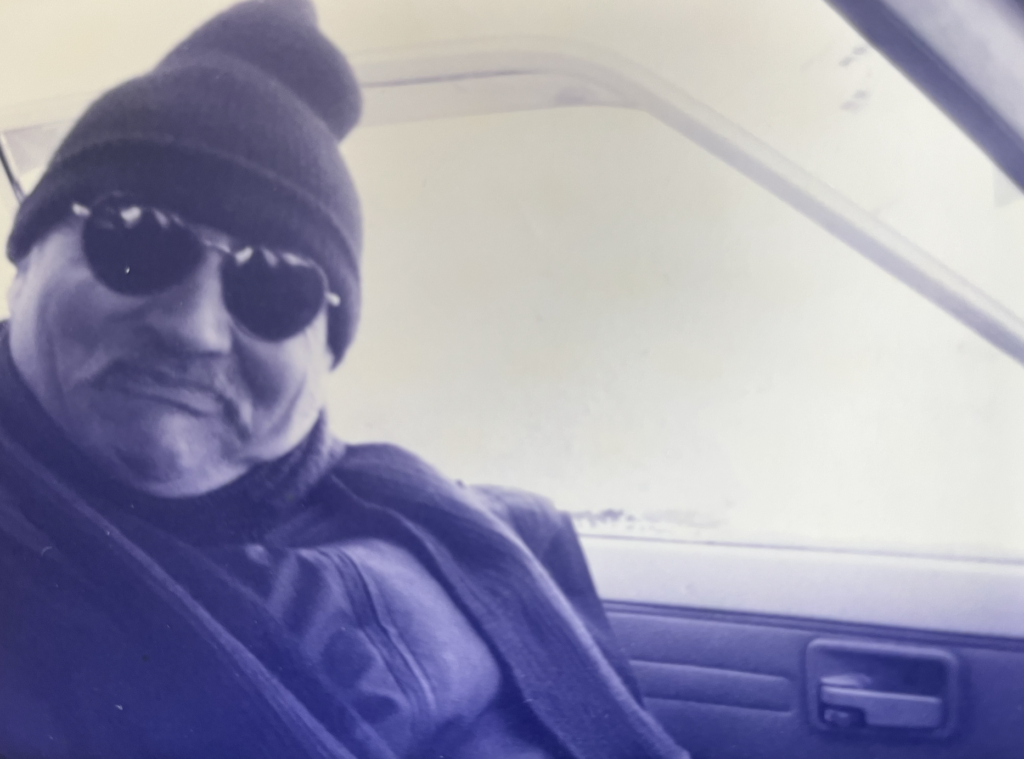
Since I had privilege of translating his talks and workshops in Japan, I had a unique way of learning the idea and application of bioregionalism and contemplating my own culture through Peter’s perception and elaboration. So, it’s inevitable that his work greatly influenced my way of seeing, thinking, living, teaching/coordinating things and getting involved.
Since 2016 for example, my seminar students and I have worked with the local municipal education board of a small fishing town of about 10,000 residents to start up an experiential environmental education program for local kids. Every summer on the day of spring tide we take about 20 kids to walk/float down a local river to the tidal flat, the largest in northern Honshu Island.
As a committee member of the Aomori Prefecture Land and Green Space Planning Committee, Kawamura Shinji, I and 5 other members including academics, an environmental advocate, and tourism planner stressed the importance of watershed-oriented planning policy and the proposal was adopted as one of the three main characteristics of the final plan. The plan is effective from 2022 to 2040, and the mid-term review will be conducted in 2030.
The overview of the plan is here and watershed-based land use plans and maps are here.
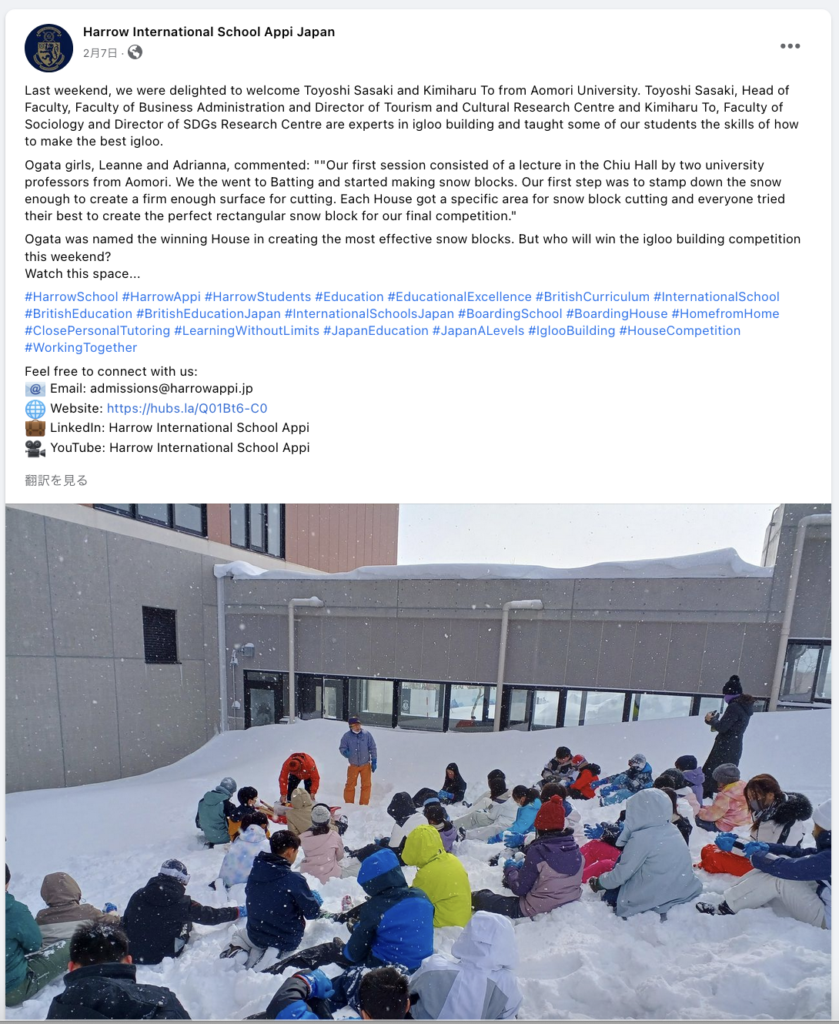
Peter and Judy also influenced my way of plotting and framing educational approaches. For example, I am working with Harrow International School Appi, a well-known prestigious British boarding school, which was opened in last August as the first campus not only in Japan, but also the very first one built in the upper watershed area and emphasizes the field of outdoor environmental education. I and my colleague, who is an expert in outdoor-adventure education at Aomori University, offered a three-day igloo building educational workshop for the students that they really loved. The school is now seeking more outdoor educational ideas and possibilities as well as networks with which to share their quality outdoor education. I just offered to set up a rafting trip in September for faculty members of Harrow Appi and Aomori University. We are hoping to observe a salmon run together and learn different approaches and pedagogies from each other. I hope that Harrow Appi and Aomori University will offer this type of outdoor program for students.
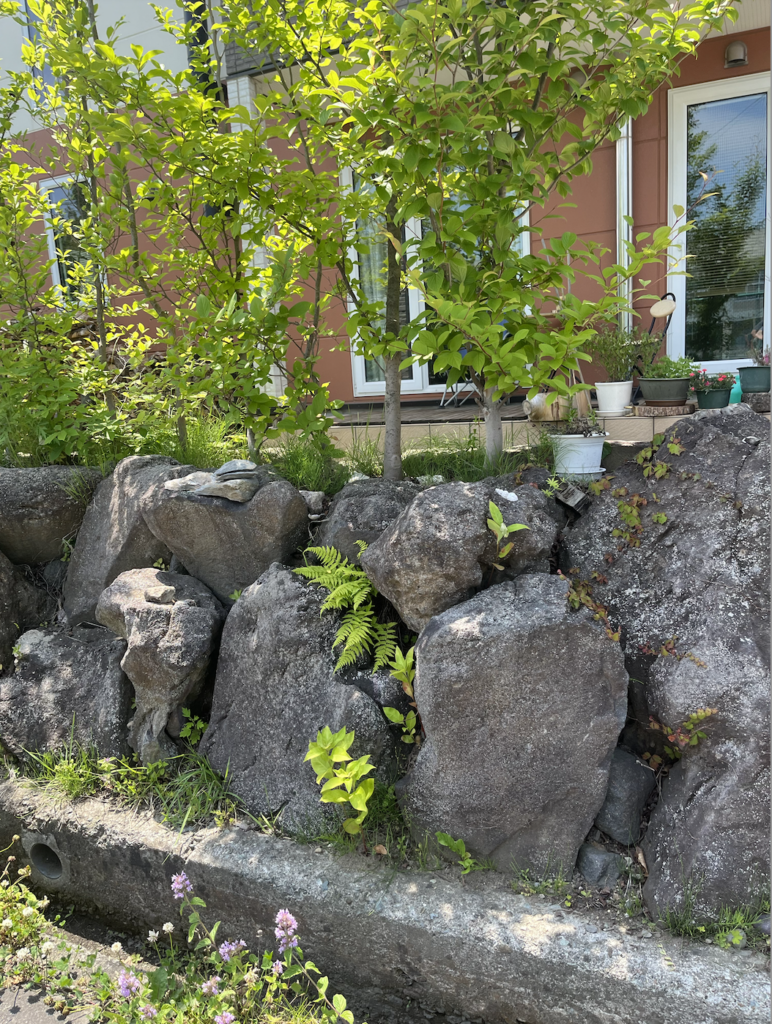
My personal life has also been affected by knowing Planet Drum, Peter, and Judy. For example, we use a wood-burning stove in winter and I am now living in a house with a tiny garden facing the street. It has a hedge of camellia japonica and a stone wall composed with native volcanic rocks. Since there are spaces in between the rocks, I planted native plants and ferns. I see little birds and insects there, and people walk by every day and notice the gardens and birds. It seems they enjoy it, and I enjoy it so much. I learned to make this small, relatively distinct local ecosystem by my house from Peter and Judy although I have not negotiated with municipality officials for permission to do it or persuaded (educated) them to encourage others to include natives in their building proposals.
Many of Planet Drum’s contributions to the bioregional movement both implicit and explicit appear in the book The Biosphere and the Bioregion: Essential Writings of Peter Berg.
My favorite Peter quote is, “Umm . . . I think it’s going to go as far as we push it. Let’s push it as far as we can.”
You asked. “How would you like to see Planet Drum contribute in the next 50 years?”
I consider that this question is asking me, “What are you (Kim) going to do with the idea and practice of bioregionalism and Planet Drum Foundation (PDF) engagements after all the time you spent learning from Peter and Judy?”
So, it’s a question surrounding one’s resolutions—especially for those who directly/indirectly got inspired through the 50 years of PDF history. I put it this way because we are always in a never-ending, discursive process of friction between planetary and global. Problems and possibilities are everywhere; we are surrounded by them. Now is the perfect time to re-embrace what Peter repeatedly mentioned in one of his speeches given in Washington D.C. in 1996 saying “let’s push it as far as we can.” So, I ask myself, “What and how am I going to push bioregional ideas and practices in the next 50 years?”
Kimiharu To is an environmentalist and translator who lives in Aomori, Japan. He translated several Deep Ecology/bioregionalism related articles. Since 1995 he has helped coordinate Peter Berg’s talks and workshops in Japan which led to the co-founding of Guard Fox Watch with Peter during the 1998 Winter Olympic Games in Nagano, Japan. During his work at Japan Environmental Education Forum in Tokyo, Kimiharu was temporarily dispatched as an All-Japan Non-Governmental Organization representative to the World Summit on Sustainable Development Conference in Johannesburg, South Africa 2002. Currently, he teaches courses on environmental studies and serves the Director of SDGs Research Center at Aomori University.
<<<<—————–>>>>
By Nancy Morita – June 18, 2023
Planet Drum’s 50th Anniversary
On this 50th Anniversary of the founding of Planet Drum Foundation, Peter Berg and Judy Goldhaft’s brain child and now grown-up multi-dimensional being, it is sweet to pause and look back at how my life and so many others’ lives, and organizations, have been stirred, nourished, kick-started, and woven so meaningfully together by their love, care, and belief in all of us.
I first met Judy and Peter back in 1980 or so, at their home/office/dream space at 451-1/2 30th Street in San Francisco. I’m not sure how I found out about them, but their network by then was already so well-established and wonderfully eclectic, that someone whose life they had touched must have sent me their way. At that point in time, I had an idea about making a historical, ecological mapping of San Francisco, and I suppose I was looking for encouragement. Judy and Peter welcomed me in, listened to my ideas, and got suitably excited about them. I think I returned to their place several more times over the ensuing months (years?) that followed, until one day Peter said, “That’s a wonderful idea, but are going to actually do it, or are you just going to talk about it?” After my initial shock and indignation, I realized that, yeah, he was absolutely right. And that was exactly what I needed to get going on making it happen.
Planet Drum became the fiscal sponsor for what came to be known as “Wild in the City.” And, I’m sure that funding was helped along by their – once again – amazing network of friends and bioregional allies. Wild in the City, now with two poster editions, and still going strong about forty years later, has opened so many doors for me, and for our shared message of the importance – sacredness, even – of wildness here in San Francisco. Peter, Judy and Planet Drum were tremendously influential in Wild in the City’s coming into being.
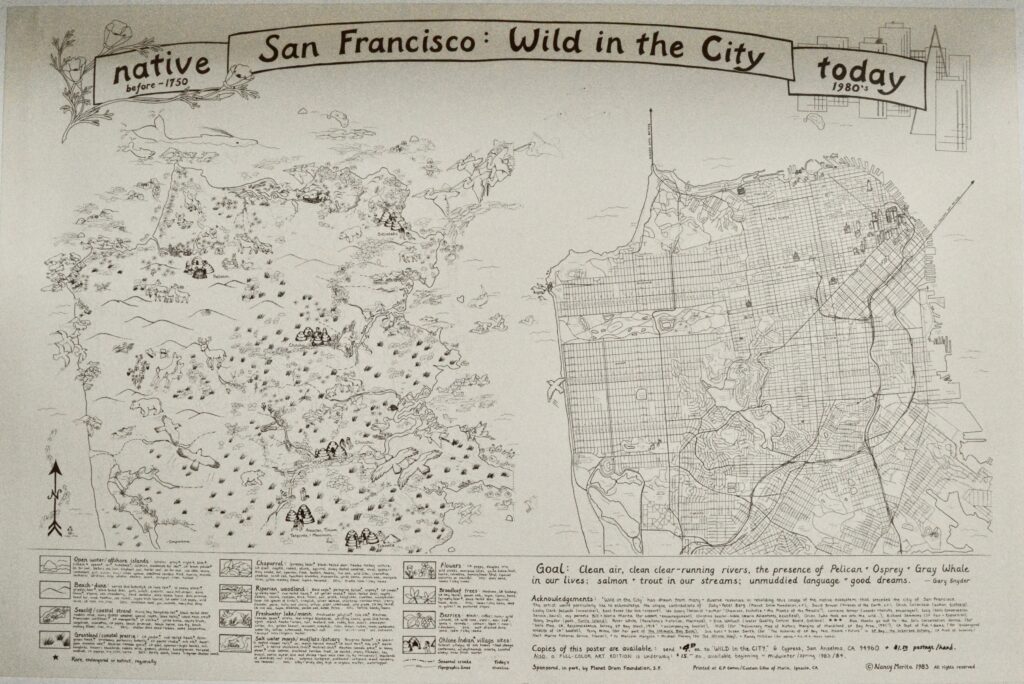
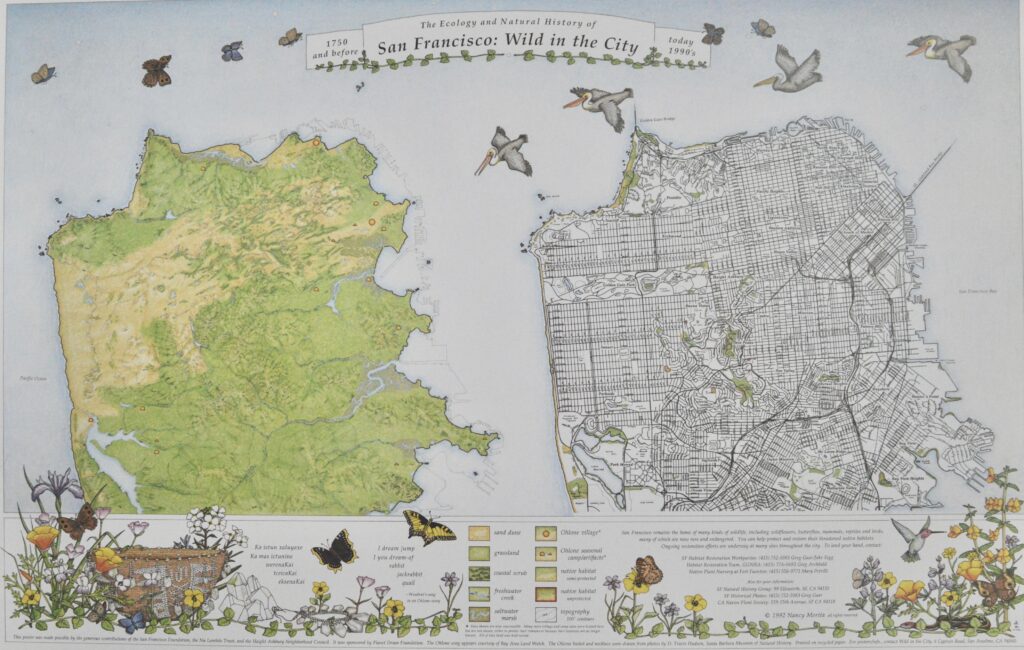
Incidentally, Judy and Planet Drum joined me at the Exploratorium in April for a celebration of Wild in the City and related natural history and habitat restoration projects, and the event was attended by 150 people, standing room only, a testament to the longevity of these ideas.
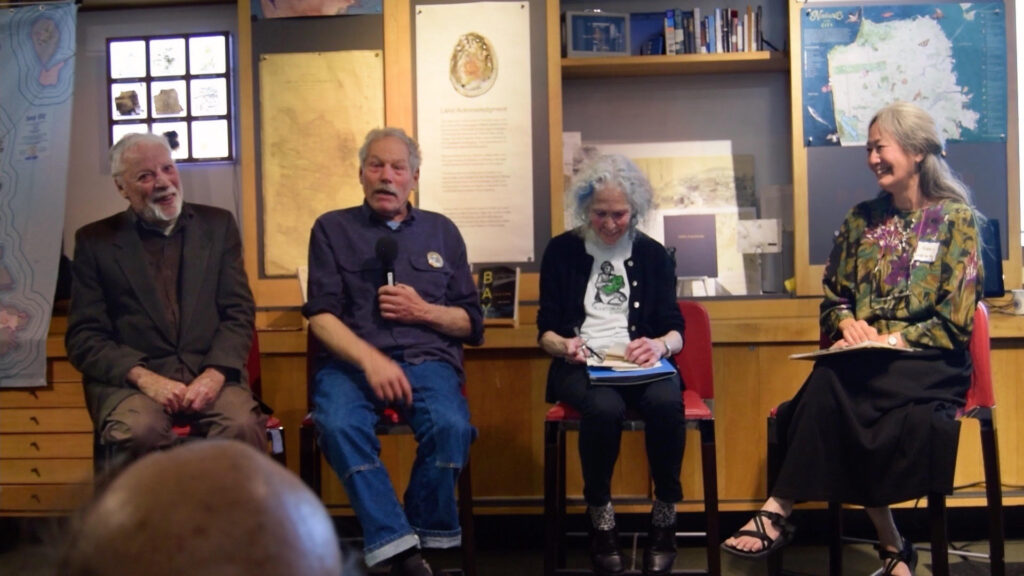
It was not only the fiscal help and encouragement, but my very thinking and understanding have been so enriched by Planet Drum and its network of bioregional allies. I can easily think of twenty friends and allies that I can trace to Planet Drum’s introduction, who have both influenced my thinking, and made the journey so enjoyable and worthwhile. Thank you, Judy (and Peter).

By way of example, one day, about forty years ago, Judy suggested that I contact a friend of hers, Lauren Davis, and she offered me her mailing address. Right on! Lauren and I wrote initial letters to each other, then more, then became friends, circumambulating Mono Lake together, adventuring in several states, writing, editing each other’s manuscripts, and sharing ideas and appreciative zeal… over all these years. Judy has an incredible eye (heart) for seeing the essence of people, and helping us make lifelong and inspired connections.
Judy and Peter were invited by David Haenke to the First North American Bioregional Congress, affectionately known as NABC I. This was to be held in the Ozarks, and they invited me to join them as part of a traveling entourage, driving across the country and staying with friends and allies all along the way. The Congress changed my life! I saw how two hundred of us passionate, devoted, opinionated bioregional allies could operate on consensus, and blow each other’s minds in wonderful ways, and feed each other (literally and figuratively) every day of the five-day Congress. Actually, Planet Drum didn’t just “get invited,” — they were actually co-conveners, very instrumental in the development and blossoming of the event. By the way, this Congress was not a trendy, expensive ticketed event to be “seen” at, but rather an all-in gathering of highly-committed, brilliant and inspiring bioregionalists, sharing about what they know and do best.
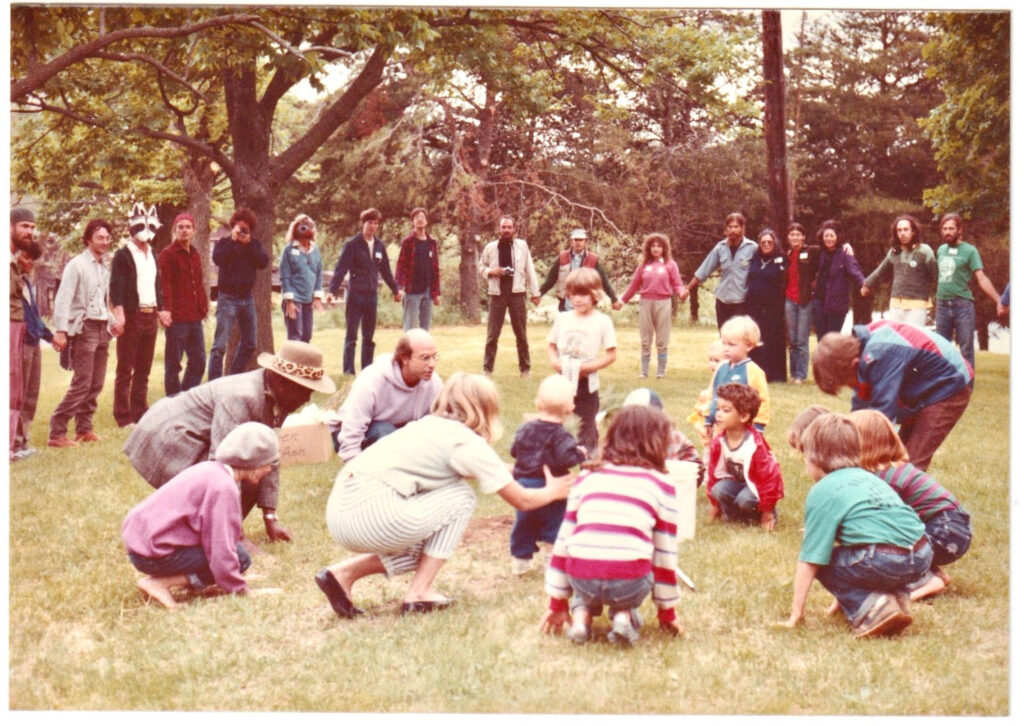
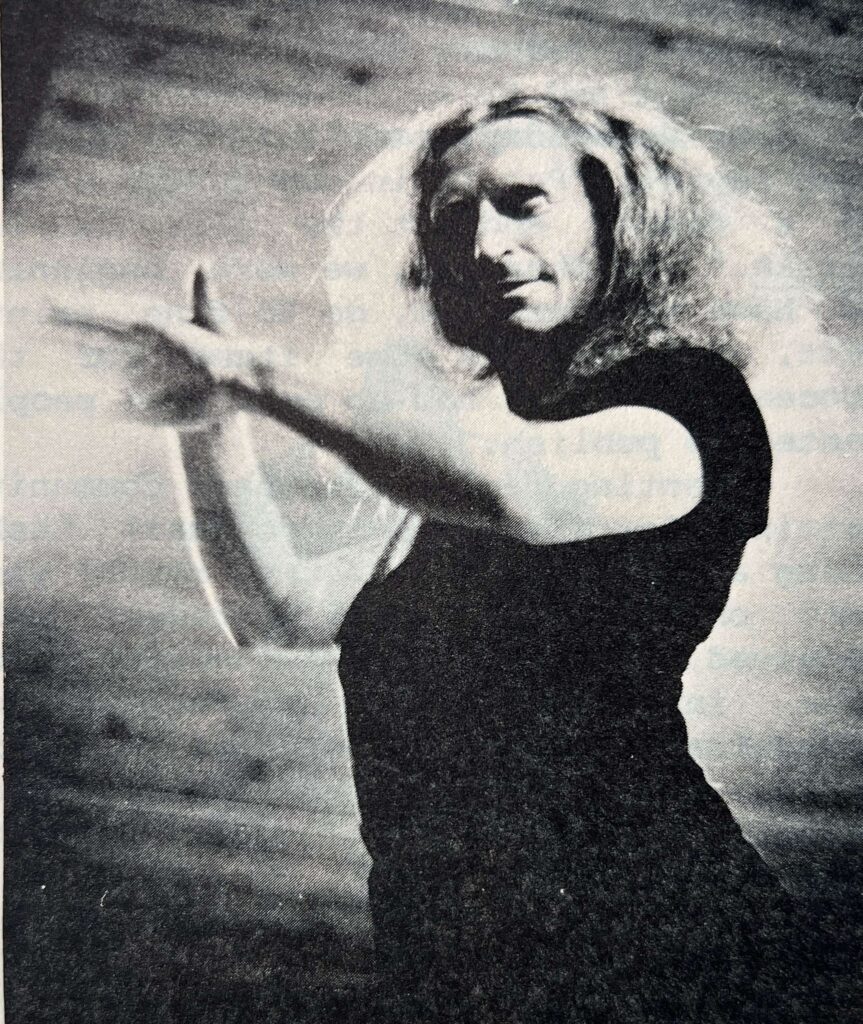
One of the people on that NABC I excursion was Bob Carroll, the actor/storyteller of the bawdy, ecologically and scientifically informed, and also radical, political performance, “To the Spawning Grounds” (aka Salmon Show). This was a pinnacle of fall-down-in-the-aisles-laughing-and-cheering level of information sharing. Marvelous! Bob Carroll was one of Peter and Judy’s dear friends, whom they helped to boost into the spotlight, to share with the community an amazing and soulful, and always-to-be-remembered message about our animal relations (as well as the politics involved). And, when dear Bob Carroll became seriously ill with AIDS, Peter and Judy took him into their Planet Drum home for loving hospice. They honored him, and in doing so, inspired all of us.
Judy came to visit me one day at a 100+ year-old one-room schoolhouse in West Marin where I was teaching at that time. We were both drawn to the 100+ year old (actually a remnant of a thousands-of-years-old) wildflower meadow there, and we laid down in it, and shared stories. It felt like we were in a sacred bubble together, one of those elusive windows into dreamtime. Judy understands and connects with nature at a very deep and beautiful level, just as she does with us (humans)… and in our modern world, rife with ecological amnesia, hers is a rare and precious super-power.
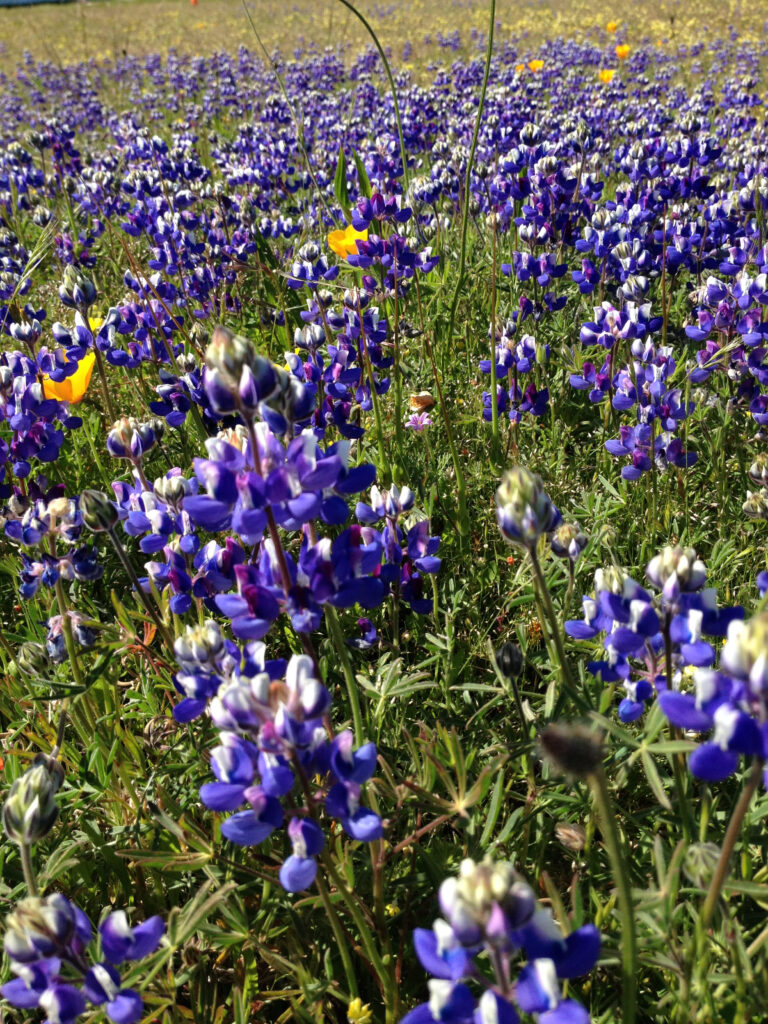
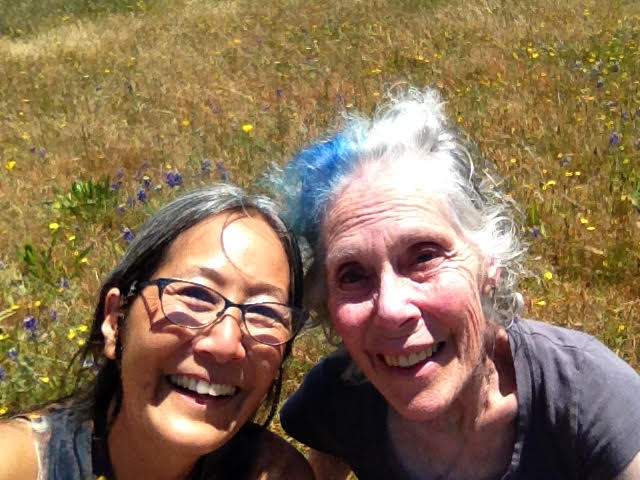
So, here’s to Judy (and Peter) and to everyone who has had a hand, and heart, in Planet Drum’s sort-of-quiet, but nevertheless formidable 50-year success!
With Appreciation and Love, Nancy
Nancy Morita is the researcher and artist of two editions of “Wild in the City” posters which show the ecology and natural history of San Francisco, comparing 250+ years ago with today. Nancy finds meaning and connection in restoring the native biodiversity of the oak-bay-madrone forest where she and her family live. They reside in the Bothin Creek bioregion.
<<<<—————–>>>>
By Matt Switzer – June 18, 2023
One Big Experiment: Reflections on Some Time Spent with Planet Drum Foundation
Planet Drum Foundation is a hard place to find, even for those who grew up down the street. The office is nestled in a basement lined by the city’s first native sidewalk garden, once paved over by a concrete slab. How Planet Drum Foundation managed to do this is still largely unknown to me — one of many miracles that light the path for curious new folk like me wondering what it means to reinhabit a bioregion and embody a sustainable vision.
While I still can’t quite tell if I worked or volunteered there, I can say I learned a lot and am irrevocably changed by what I learned. I first read of Planet Drum in an interview Derrick Jensen had done with Peter Berg alongside other luminaries for a folklore class at University of Oregon (quack quack) which introduced me to radical movements. Words like “monkeywrench,” “eco-magic,” and “bioregion” were some of the first I came across whose definitions I tried to commit to memory as a young graduate student. Arriving back in SF when Occupy was in its first iterations, my hunt for Planet Drum Foundation’s half-address was one of the first tasks I gave myself, though after some time mistaking various buildings for one I thought might house the foundation, I gave up and called Judy. Looking back now, walking into the basement became a threshold moment for me in developing my own watershed consciousness, not knowing what to expect but excited for what might await.
The first thing one notices upon entry is a lot of paper. Add a few computers, a mini-library, a number of maps and primary sources, and different people there for different reasons doing different things depending on the day, it is remarkable to think about the accomplishments that came together at that office and beyond. Eventually I would call myself a “membership magician,” and vowed to learn all I could about the philosophies, projects, programs, workshops, and calendar of events through the updates I wrote and books I took home, reading all I could from the various watersheds I had never heard of but longed to know better, while co-organizing what I believed would be the sacred events to map the future growth of what Thomas Berry had called the “dream of the earth” as best I could.
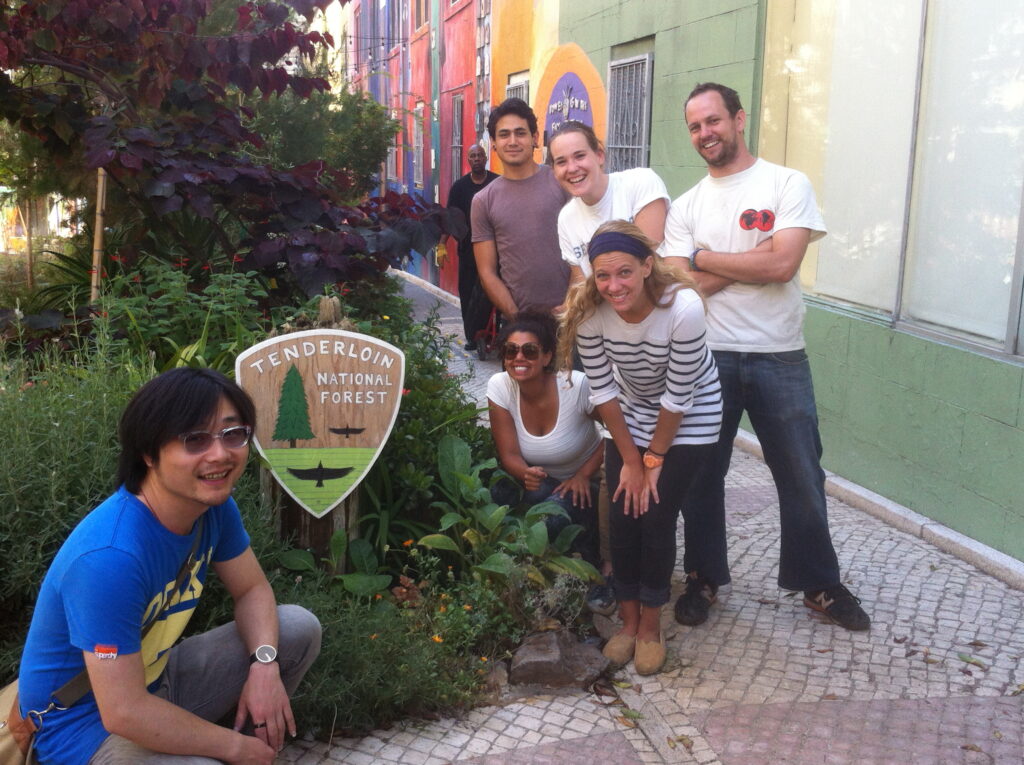
In the interview I read, Peter Berg described the greatest environmental challenge to be the transition to sustainable cities—of which there are currently none – and brought to light central topics and themes of local governance, food production, greenhouses, gardening, construction permits, reducing waste, self-sufficiency and design principles to address limited resources. Perhaps because the basic modality of the human mind is narrative, ecological grounding seems a critical ingredient in formulating any story for sustainable pathways forward. Planet Drum Foundation, in stressing bioregional consciousness of living regions, as well as activities and social forms that harmonize with natural systems in order to design a sustainable future, offered a perfect approach to catalyze these needs—a “happy ending” for the Holocene.
That first day, I sat down and talked with Judy, who explained the projects they were in the process of implementing. The Eco-Ecuador Project modeled one of the first eco-cities in the world. By stressing education, revegetation work, and crafting a bioregional sustainability institute, Planet Drum had begun the long work of restoring a community initially ravaged by deforestation and soil erosion that had led to a mudslide after an earthquake in which many community members were killed. After our talk, Judy invited me to see the garden planted next to the building in the sidewalk. She walked with me from one to the next, listing native herbs and plants while telling me their histories and offering some to smell, touch, and taste. She suggested places to go in the city, like Glen Canyon, that held wild spaces coyotes still inhabited. She told me how more and more birds were seen now that more and more people were planting gardens with more and more indigenous plants, and how even city officials were taking strides in this direction, establishing median gardens on sidewalks and between roads to offer relief from the surrounding concrete jungle. As I moved from flower to flower, noticing the way the bushes smelled and leaves felt, Judy shared about Planet Drum publications that had been adopted by city groups who had a hand in shaping local policies, and how the foundation had engaged urban dwellers in activities to provide a greater perception of our involved interdependence in the planetary biosphere.
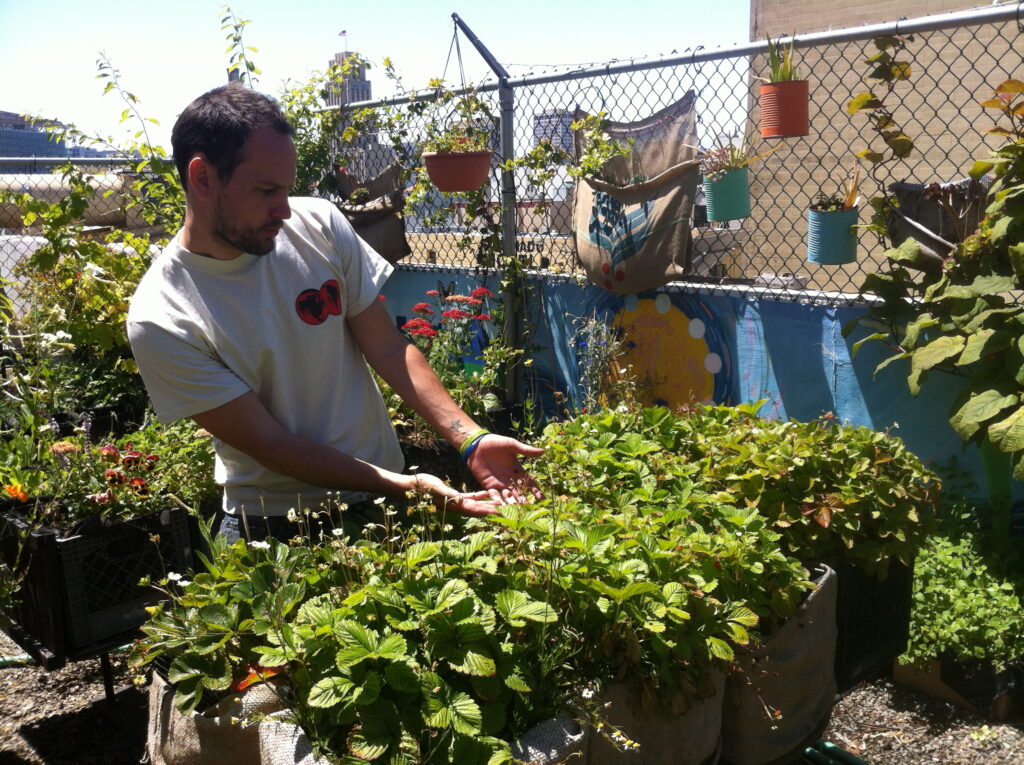
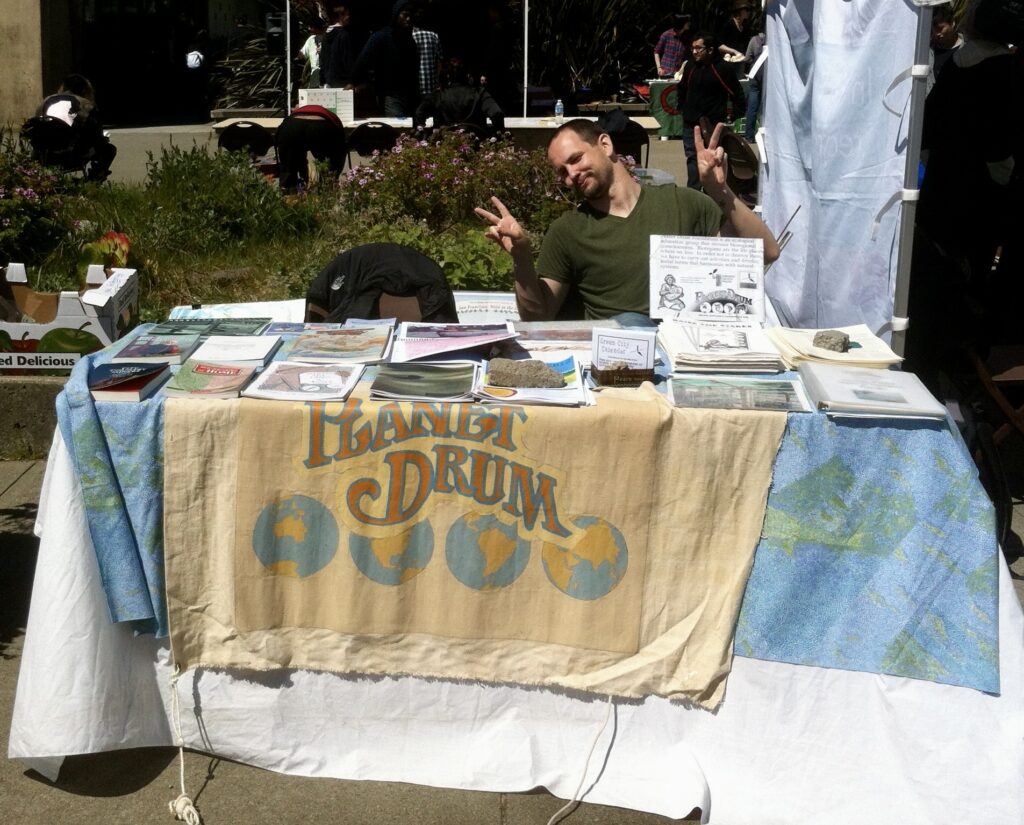
With so much importance on maintaining local natural systems and finding sustainable ways to satisfy basic human needs—food, shelter, energy, water, culture, etc.…—it was beautiful to see first-hand the people and the place involved in reinhabitation, where people could learn to become more native to the places they live, at the same time becoming aware of (and stopping) that which destroys the possibility of reinhabitation. Questions are raised and connections are made: where do products come from? Where do they go? We talked too about the potential for collaboration—bringing students I worked with to do a map-making workshop on a bioregional tour. So many of them—us—hardly know the first thing about local watersheds, and beginning to acknowledge the energy sources we are linked with while developing our understanding to construct a new psychology of power becomes a basis for strength and resilience. I want to know about my home instead of paying into an unsustainable lifestyle processed and imported from a place unknown to me. By the time my tour of the organization was complete, I felt like I was closer than I had ever been to finding a place I could go where the work I did would connect me to earth. Inspired and excited and anxious to contribute, I asked Judy if there was anything I could do in the short time I was there. She let me know if I was interested, the garden needed weeding.
I laughed as I realized something so trivial was in fact so crucial. Weeds inhibit vegetables and other plants from growing by stealing light, water, and nutrients, while sheltering insects and disease. They are resilient and persistent, like all essential challenges worth tackling. I knelt down in the soil, uprooting the first of many weeds, and felt the symbolic meaning of what I was doing wash over me—cultivating a sacred space while clearing it of intrusive forces that might choke and limit its potential. I thought of my own work and role in the larger scheme of bioregional and planetary renewal and asked Judy what she thought best practices might include for starting one’s own bioregional community, whether big or small. She smiled, her face exuding warmth and wisdom. “It’s one big experiment.” Her advice from that day is likely seared into my mind forever as I pressed her to elaborate: “Create the conditions you describe.”
If Planet Drum did anything for me, it was to help me to understand the messy history of place. Ecosystem restoration qualifies us to be inhabitants in-tune with the conditions under which we grow up. Earth is primary, and everything in it is connected as a planetary reality. If it is true our collective consciousness can be “mended” so that the illusion of separation gives way to an awareness of interrelatedness, then it is surely groups like Planet Drum, emphasizing alliances to recognize natural systems and restore and maintain these places as homes, that will be pathfinders in the necessary transitions ahead. Knowing the land, learning the history, realizing the potential, and rectifying society with the values and tenets of a self-sufficient bioregion is, I think, the best way to maintain a sense of community through reciprocal cooperation.
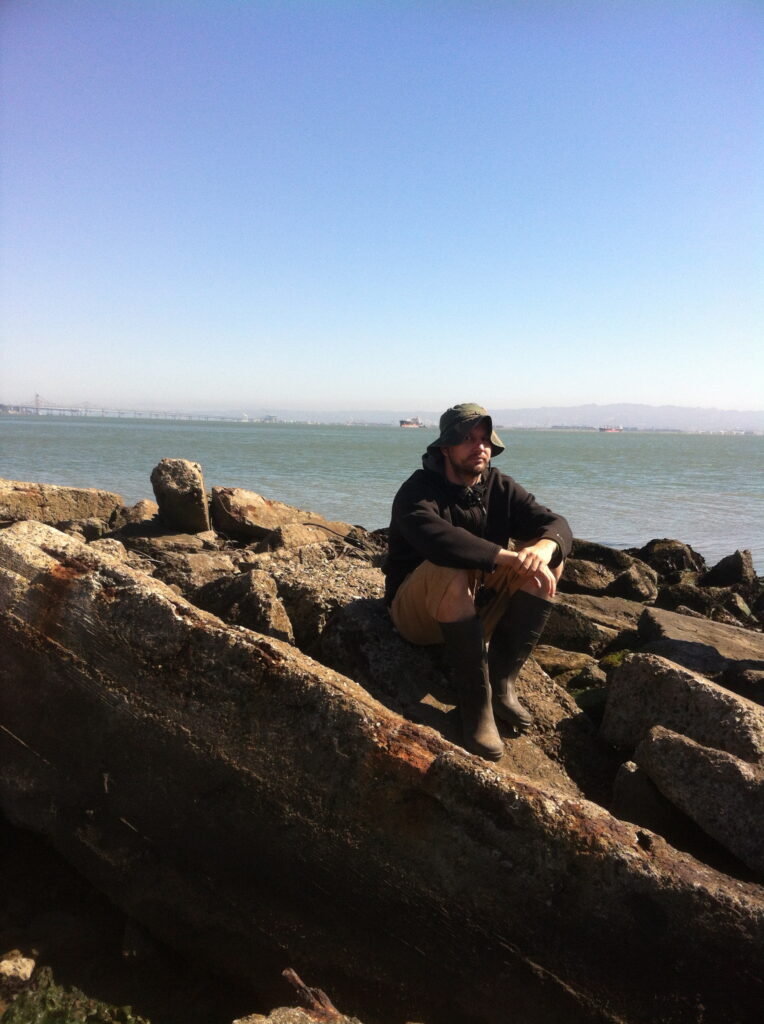
Nearly fourteen years after walking into Planet Drum Foundation after reading its name in a book, what I remember most was Peter’s sentiment that if we win in the city, we win. Urban sustainability may so far be oxymoronic, but it remains fertile ground for raising the stakes for what it means to reinhabit bioregions, keeping a finger on the pulse of the people and projects who prefigure a wilder world. It has meant the continued beating of many hearts, while remembering those that have stopped yet through death live again.
I do not know the first 50 years of Planet Drum Foundation’s history well, but I know enough to understand that if books are, as a student of mine once called them, “just dry ink on dead trees,” then I believe the trees would be relieved how highly esteemed I consider their remains that carry the many words bioregionalists have shared in the publications mailed from the half-address. Remembering my time in Oregon, touring the remains of a battlefield where freddies, loggers, and activists would play cat and mouse, where trees had been saved, others had fallen, and some had been cut down and left to make new wild growth, Planet Drum, much like the sidewalk garden, strikes me as much the same: one big experiment, to see what will take root and survive. If trees and rivers have a religion, I imagine Planet Drum Foundation as the poets and theologians keeping the spirit of nature alive in our hearts.
Looking back now, seeing what I learned, what I lost, what might have been, and what can always still be, I am thankful for what the Foundation’s members and supporters and friends have given us and taught me about what it means to be a good neighbor in a time of loss and not knowing. I have been deeply affected by the work done, and believe the ideas inked on dead trees hold the best possibility for the wider world to survive the next half century, reminding each next generation to struggle against all odds to remain wild and free, to partner with each plant breaking through a sidewalk like another earthen dream, another planetary drum beat calling curious wanderers to seek out its front door.
There are many special moments in my life, and my time at Planet Drum will be counted as one of them. Thank you especially to Judy, Ben, and Jean, to Karie for the invitation to write this, to Peter of course, to those who read these words, to the many people I will never know as well as I would like to who I nonetheless learned from directly and indirectly, and all those who carry on the tradition. Thank you to the land that has sustained my life, and for giving me the opportunity to try to repay this kindness, however briefly it may be.

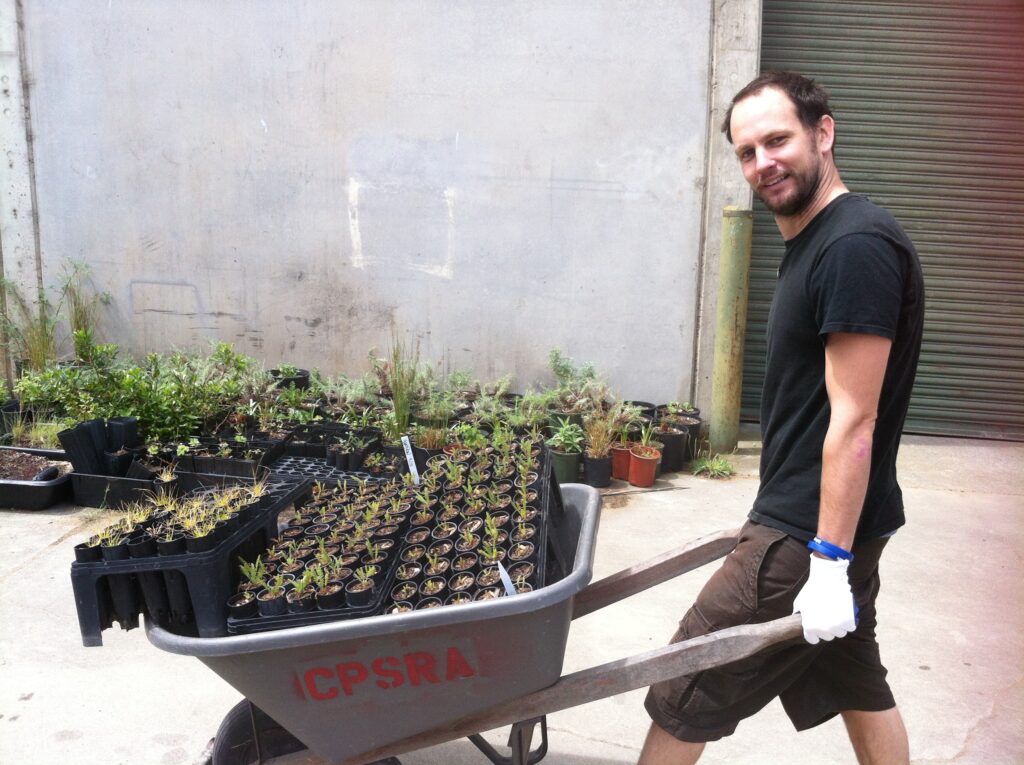
Matt Switzer is a bioregionalista extraordinaire. He lives in the Shasta bioregion and was membership magician for Planet Drum Foundation from 2011 to 2013. His graduate research focuses on ecology, spirituality, activism, and the role of dreams in resource management.
<<<<—————–>>>>
By Whitney Smith – June 19, 2023
How Do We Planet?: Catching the Bug from Peter Berg
If we’re lucky, we come in contact with remarkable people who exert a powerful influence on where we go next. This happened for me in 1987 when I met Peter Berg. I had heard about him through a Canadian radio series by the philosopher and broadcaster David Cayley. Entitled ‘New Ideas in Ecology and Economics,’ it introduced people to a class of environmental projects that were sophisticated and ingenious. The projects ranged from practical hard-science innovations to social theory and featured a cast of heroic characters: Paul Shepard, Murray Bookchin, Hazel Henderson, Bob Rodale, and John Todd to name a few. Also on the list was Peter Berg, the founder of a small organization called the Planet Drum Foundation.
In describing what Planet Drum was all about, Cayley began with the question, “how do we think about where we live?” The conventional answer to this is that we live in a particular location identified by a postal address, but this view was being challenged by the notion of natural countries determined not by political boundaries but by biological ones. Berg referred to these as bioregions and the scope of thought behind them as bioregionalism. What had started as an illuminating idea, reported Cayley, was now a vibrant social movement with more than 70 groups in North America.
When asked about the name of his organization, Planet Drum, Berg explained that we need “to start beating the drum for how we think about being on the planet together.” And rather than it being about academic research, it was about a shift in human and popular survival terms. “We know how to nation-state,” he said, “but how do we planet?” Tracing the roots of his discovery of bioregionalism, Berg says it started with the work of Raymond Dasmann, an American biologist who by that time had helped develop the field of environmental science. When Berg read Dasmann’s 56-page essay, “Biotic Provinces of the World,” he got in touch with the author immediately. They soon became friends and colleagues, which led to their collaboration on “Reinhabiting California,” an essay that further defined how biological and geographical regions (rather than geopolitical ones) related to the continuity of watersheds, river valleys, landforms, climate, native plants and animals, and to the notion of a “home-place.”
A year before attending NABC III, I started a magazine called The Journal of Wild Culture with Chris Lowry and a gang of creatives in Toronto. When people asked what it was about, we used the phrase “ecology and imagination.” This encounter with the ideas of bioregionalism appeared like some kind of inspired gift. I had to get in touch with this guy. On the phone, Peter Berg was immediately warm, welcoming and engaged. His unique combination of breeziness (perhaps a function of his Florida upbringing), attentiveness and eloquence — salted with not a little irony — had me hooked. Within minutes he was urging me to attend what promised to be an unmissable event: the North American Bioregional Congress (NABC III) in British Columbia. As an impecunious artist, flying across the country from Toronto was not an easy choice; he heard my reticence. One of Peter’s compelling traits, and there were many of them, was his ability to concisely sell an idea and explain why it was not merely sufficient that action be taken, but necessary. A few weeks later, in August 1988, I landed outside the town of Squamish, north of Vancouver in an old forest alongside a surging river, joining him and 400 other passionate and articulate Earth-advocates in a head-spinning week of discourse, conference-style info and panel sessions, consensus-based legislative plenaries seeking to forge mission statements, dramatic and inspiring local Indigenous-led drum circles, hilarious and touching theatrical presentations by residents telling us about their bioregions, with music and singing woven throughout, bringing history and traditions forward into the present. I left transformed.
Returning to Toronto, my beliefs about who I was as a resident of a particular place had been unpacked and were ready for reassembly. Like some kind of born-again compulsive, I couldn’t stop talking about the B-word. Since I wasn’t from a place where the continuity of watersheds, river valleys and landforms were so apparent or influential to everyday life, Peter said I needed to understand “green city principles.” Reading Planet Drum’s newspaper, Raise the Stakes, the “Nature in Cities’” issue (Winter 1988), I learned how the quality of my life in my local neighbourhood — the place where I buy my groceries, where I experience the fauna and flora in local parks and ravines, where I participate in nearby cultural facilities — this is all part of what allows me to see my urban earth-place with new eyes.
Around this time, a major Canadian multi-year government study was being undertaken on the future of the Toronto waterfront. When I met with the head of the study, David Crombie, I shared some of what I’d learned at the Congress. He had never heard the word bioregion and wanted to know more. In the final report, entitled Regeneration, (which identified the Greater Toronto Bioregion as the location under consideration) cited that there were a few ways of naming the different approaches to waterfront management, some of which include “bioregionalism, green or eco-cities, the livable metropolis, healthy communities, sustainable development, and the conserver society.” The report also expressed a familiar idea put forth by Planet Drum, “[that] a careful consideration of the philosophy behind all these concepts leads us to identify five fundamental themes of the ecosystem approach: the ecosystem as “home”; everything is connected to everything else; sustainability; understanding places; and integrating processes.”
As to “the philosophy behind all these concepts,” I am reminded of what compelled me to want to spend time with Peter. Aside from the cheer that accompanied his boundless curiosity applied to all things around him, it was the probing intellect in hot Aristotelian pursuit of classifications and systems. In 1989 I spoke to David Simpson, Peter’s colleague in founding the street theatre group, The Diggers, in 1960s San Francisco. David complained about the fatigue experienced by Peter’s close friends at his episodic lack of abstemiousness, but added, “However annoying all that is . . . the man is intellectually indispensable.” It was a fact about Peter Berg the potent trickster, he was an exceptionally well-taught autodidact. After winning a scholarship in psychology, he dropped out of the University of Florida at 17, clearly an inconsequential event in the formation of his analytic skills. In discussions with Peter he derived pleasure and purpose in playing the Socratic role of questioning, unpacking and reassembling, with logical rigour, his own and other people’s arguments, including for and against bioregionalism. It is now commonplace in academia to offer courses in the philosophy of various subjects — science, mathematics, physics, human sexuality, and so on — and despite the struggle that humanities departments are experiencing in keeping up with enrollment, our appetite for wanting to look at things philosophically remains undiminished. In Peter Berg’s case, his environmental writing deserves a secure place on the shelves of readings in philosophy of geography courses, at least where they have not already earned that status. Peter’s definition of a bioregion that emphasizes “a geographic area defined by natural characteristics [that] includes human beings as a species in the interplay of these natural characteristics,” and the questions he insisted on asking about this interplay, are consistent with geography’s central considerations about knowledge, perception and representation of space and place. And in other branches of philosophy as well where there are theories from the past that echo the themes I’ve described here — Rousseau’s critique of civilization or Husserl’s phenomenology applied to place, two that come to mind — there is a lot to mine. Graduate students and independent intellectuals like Peter Berg can help us go forward by thinking through the dilemma about habitat and human responsibility.
So, back to meeting remarkable people. Peter Berg — on his own and through his organization Planet Drum Foundation that he ran with his life partner, Judy Goldhaft — came into my life and by the sheer good sense of his arguments became a silent mentor. The force of his brilliance and immense spirit of generosity — as a natural characteristic of who he was, by his nature, according to his nature — continues to spread wildly and abundantly.
I see flowers everywhere.
Whitney Smith is an artist who works in the fields of journalism, publishing, and music. In 1986 he founded The Journal of Wild Culture, a print magazine from 1986-1991, now online since 2012. In music he is best known for leading the Whitney Smith Big Steam Band, a 17-piece jazz orchestra playing his own compositions. Whitney lives in the Oak Ridges Bioregion, a.k.a. the Great Toronto Bioregion.
<<<<—————–>>>>
By Josh Wilson – June 20, 2023
Knowing My Place
It’s 1989, and I have no idea what I want to do besides smoke weed, eat mushrooms and follow the Grateful Dead around. I mean, there’s a journalism degree in my near future, but all that would do, presumably, is get me a job, and what would that have to do with saving the world? Isn’t that the only work worth doing? It doesn’t seem to me that world-saving is something I’d ever be doing in a newsroom (and, frankly, my opinion on this, 30 years later and sans the weed and shrooms, hasn’t changed).
One thing that appeals to 1989-me is to go into environmentalism, whatever that means. Save old growth forests, save the oceans, fight global warming, that sort of thing.
Problem is, it’s all very abstract. Though deeply felt, this impetus lacks a sense of place …
So there I am, looking through a “green jobs” directory, a sturdy booklet about the size of a small-town phonebook. This is pre-Internet, you understand. Probably got it from the library of my alma mater, Lehigh (“Get High”) University, in Bethlehem, Pennsylvania. I’m flipping through the pages: internships, analysts, lawyers …
Hmm, internships at Planet Drum Foundation, in San Francisco. What’s that all about? Contact Peter Berg, PO Box 31251, SF, CA, 94131, for details.
“I bet that guy’s a real pain in the ass,” I find myself thinking, quite spontaneously, with no real rationale to it. I’ve never heard of Planet Drum, have no idea who this Berg fellow is…
Fast forward to 1993. I’m fucking miserable. Environmentalism sucks. I’d gone on a brief wanderjahr after graduation and ended up in Seattle, where I had a gig knocking on doors and raising money for various progressive and environmental causes … it was wretched. Desperate for some consequential connection to my efforts, I got myself a job in D.C. — and things are vastly worse. I’m underlining keywords in the Congressional Record for a cube-farm nonprofit with a Mission Statement. My work doesn’t matter at all.
I realize my bike commute to Dupont Circle is vastly more fulfilling than the shitty job that awaits once I get there. So I quit and become a bike messenger (one of the best gigs ever), then skip town for another drive across the great and glorious continent, sleeping in free campgrounds along the way, and ending up, full of unanchored, free-floating hope, in the San Francisco Bay Area (which was the last place I truly had a good time, at a string of Grateful Dead New Year’s shows at the Oakland Coliseum in December 1989).
I crash on couches, make friends and end up in a shared flat near Golden Gate Park. Not long after I get a call from my tourhead comrade Debbie Hubsmith, who’s working for this interesting environmental organization that needs someone to edit their newspaper, and didn’t I have a degree in journalism…?
So I finally meet Peter Berg and Judy Goldhaft, and work with Debbie, and Ocean, and Sabrina Merlo, and a bunch of other Planet Drum folks, and put together a bangin’ issue of Raise the Stakes (RTS No. 22, Bioregional Agriculture), all the while soaking in Peter’s wry observations — bracingly proclaimed, and amazingly erudite — and I begin to recognize my sense of the natural world, and the human cultures that take root in it, as ultimately and utterly defined by place.
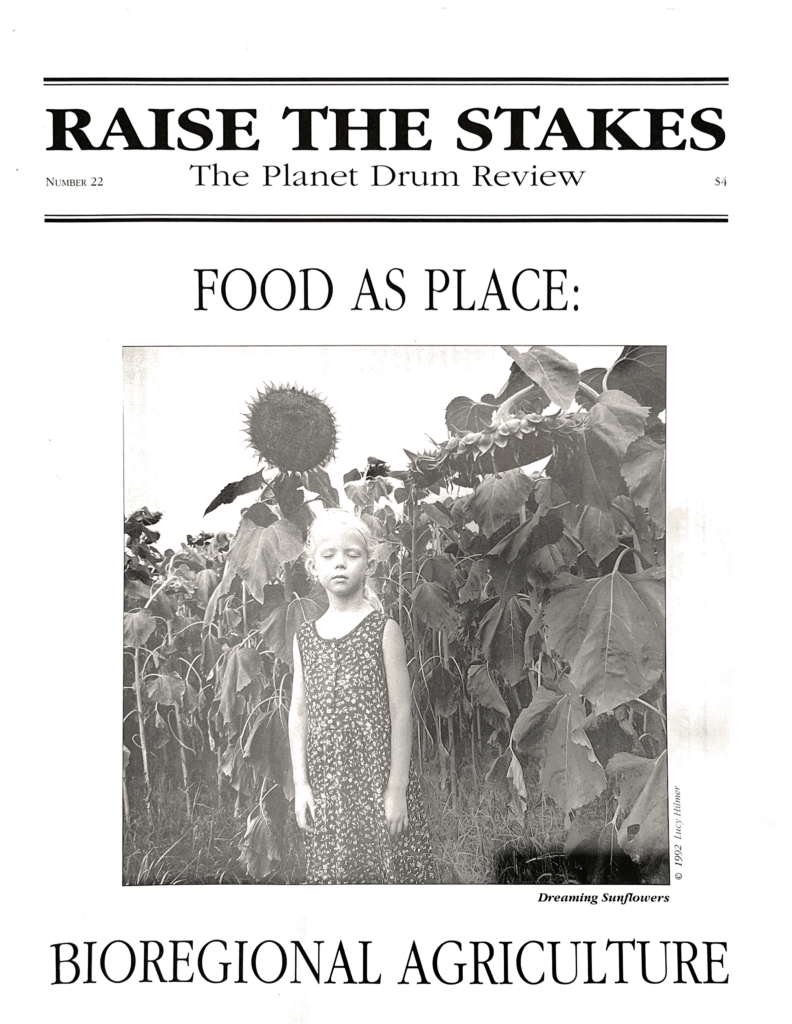
And at last, my work means something! That issue of RTS includes some of the earliest national coverage of community sponsored agriculture (CSAs), and circulated important ideas and experiences about permaculture, human culture, and the relationship between people and the food they eat every day. “Food as Place,” Judy decided to call the issue. Yes.
One afternoon, after demanding that they let me do the print layout too, not just the editing, I had pissed off Peter and Judy so much that Judy‘s eyes flashed like they were about to shoot bolts of lightning at me — her eyes literally flashed — and I didn’t end up doing the layout, obviously, which is fine because the issue turned out gorgeous and informed and exploratory and relevant still to this day. Dare I say it, “evergreen” …
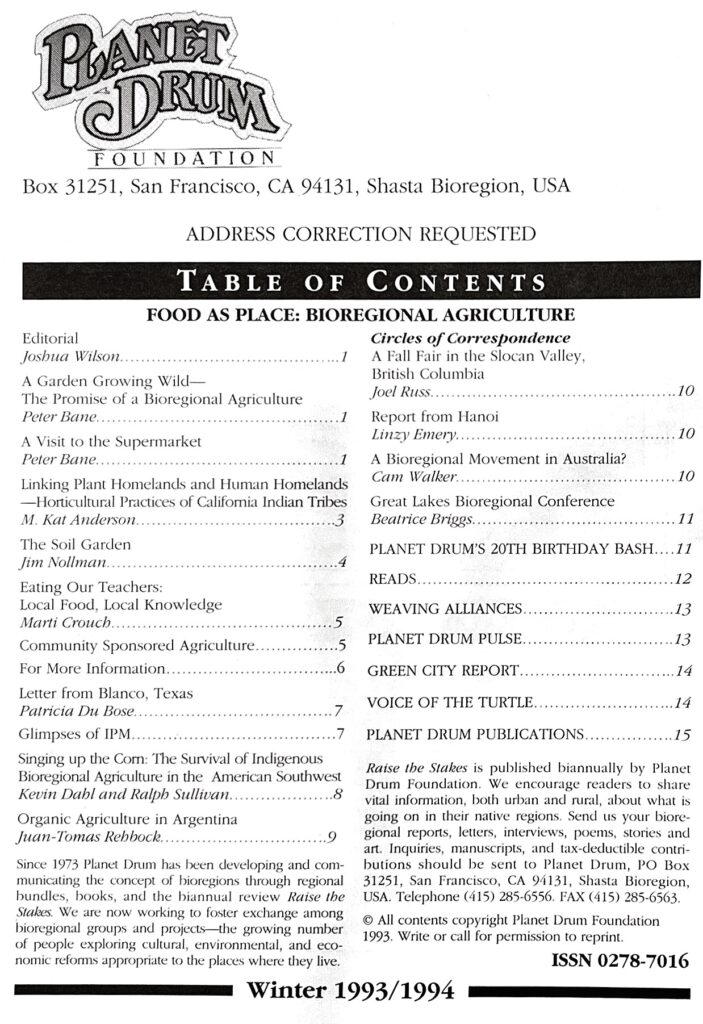
Peter and Debbie are both now gone, in that cruel way that life has of robbing us of people who still have so much more to do. The world is poorer for it, but their presence is still felt. They changed the world, that is to say, they changed our awareness of how our social constructs connect us to the vast ecological and cultural systems that make our lives possible.
Since then I have seen many newsrooms and nonprofits come and go, and recognize so intimately, and often so painfully, the struggle to change the world as fraught, agonized, an uphill battle against difficult people and my own shortcomings, against aloof institutions and impenetrable meritocracies and big money money money — not just corporate polluters and rapacious “developers” and government bureaucracies, but also philanthropies that talk big and pay themselves big and pick and choose righteous causes that they understand, that they value, and which too often are filtered through economic priorities that have very little to do with what people in places — which, after all, are inseparable — actually need.
Yet Planet Drum is more than an organization. It is a heartbeat, and even as a heartbeat falters and goes silent, the rhythm is picked up elsewhere, sometimes quite spontaneously, but self-synchronized and tumbling forward…
Planet Drum rose from need and spoke truth, and its pulse has been an animating force all over the Earth. Before there was an Internet — but in the depths of the same rapacious, profit-seeking mass medium we struggle with today — Planet Drum was a vibrant, international circuit for people continually waking up in their lifeplace (hi Peter) and recognizing both its beauty and fragility.
And now the genie is out of the bottle. Planet Drum found that bottle and poured in admixtures and sundry ingredients, spider silk and moonbeams and a little woo woo — and also science, and informed observation, and social organizing, and what technocrats today describe as “cultural capital,“ and shook that bottle up, and mumbled their incantations, and popped that fucking cork…
Planet Drum is a past full of stories and connections and achievements, and it is a present that enriches and deepens and informs and surprises near every day, and it is a future, a future worth dreaming of, cultivating and living in right now…
The madmen and fanatics and demagogues and blowhards spend their energy on folly and destruction, they stuff their faces and suck on power — what else is there for us to do but oppose them? And we have many tools, many means, to this end. Environmentalism, yes, which is comprised primarily, Peter once told me, of “lawyers, and lawsuits.” And likewise, politics and politicians. There’s a time and place for all that.
Yet Planet Drum has given us so much more. Not just protest (though yes, protest!), but also, fundamentally, an idea and an experience of ecology as culture, history, place, and opportunity — opportunity for action and intervention and cultivation on the ground, right where we live.
And where do we live? Where will we live? In the wake of the flood, of course. Among the ashes of fire and drought. Amid the devastation of the Anthropocene. In this place we scatter wild seeds, and work with the shifting winds and water and soil, and can see even now a garden growing wild in the ruins of this great folly.
We live here. We live here.
Josh Wilson is a journalist and editor in San Francisco, a former DJ and producer at the now-shuttered community radio station KUSF-FM, a Critical Mass bike rider, a founder of the nonprofit fiscal sponsor Independent Arts & Media, and the publisher of www.fabulistmagazine.com.
<<<<—————–>>>>
By Alberto Ruz Buenfil – June 25, 2023
From South of the Río Bravo (Rio Grande), I send blessings and congratulations to Planet Drum on its 50th anniversary. Our first contact with the bioregional movement came with the visit of Peter Berg and David Haenke to Mexico for a first Symposium of Deep Ecology. A book titled Lo Verde Sobre Nuestra Piel (The Green Over Our Skin) was the most visible result of that first encounter and of our permanent brother-sisterhood with both Planet Drum and the Bioregional Congress of the North. Since then, the South was invited to the annual gatherings, and by 1996 we organized Primer Consejo Bioregional de “Las Américas” (The First Bioregional Gathering of the “The Americas”) in Meztitla, Tepoztlán. It brought together not only bioregionalists, but a large colorful assortment of movements that led to the creation of Los Consejos de Visión de los Guardianes de la Tierra (Vision Councils of Earth Guardians) and the launching of La Caravana Arcoiris por La Paz (Rainbow Peace Caravan) that took lessons from that brother-sisterhood of tribes to all the rest of Central and South America, for 13 years, from 1996 until 2009. We therefore recognize You, our elder families from the North, for opening the doors of many teachings that have enriched our lives and continue doing so today. For all our relations. Gracias y muchas bendiciones.
Alberto “Coyote” Ruz Buenfil is an author, activist and performing artist who co-founded the Rainbow Peace Caravan, a nomadic multicultural activist community, and co-founded Mexico’s first ecovillage named Huehuecóyotl. He is the author of Rainbow Nation Without Borders: Toward an Ecotopian Millennium and resides in the Bosque de Agua (Water Forest) in central Mexico.
<<<<—————–>>>>
